The First Date Uniform 1:50 PM (38 minutes ago)

By Jess Agran
As someone who is single, there is nothing more exciting than a first date. The excitement of a new person, a potential beginning of something great or, worst case scenario, a funny story. It's the topic of all the best debriefs and your remittance for all your couple friends. And yet there is one daunting aspect that can feel like it determines the trajectory of the date: the dress code. Agonizing over picking out the perfect outfit while maintaining an elusive yet personable "cool girl" vibe is nothing short of war.
Now of course, this is no easy formula, there are stakes here. In our modern age finding the next intriguing, fun, extravagant thing is commonplace. While a classic dinner is always enjoyable, you never know when you might fall into the trap of a gym date or netflix-and-chill disguised as "let me make you dinner." Whatever it might be, the outfit must answer two critical questions: do you look hot, and do you feel hot? The worst thing you can do is stray too far out of your comfort zone, only to be fidgeting all night. Now getting your clothes off ASAP may be an incentive, depending on how your night will go (and power to you if that's how you boogie), but that is often not the case.
I believe that to have the perfect first date outfit, you must have a rotation of pieces that you can mix together that are tried and true. For me, it's a mini skirt and loose top combination that I feel hot as hell in with a pair of boots (so good you could drool over). Having a rotation of date night pieces that can be matched to fit the occasion is necessary. Whether it is a coffee date in the midst of a warm fall or Plum Tree sushi dinner date smack dab in the middle of winter, these outfits must mold to the occasion. So let me give you the guide to curating your perfect date outfit, because if you're reading this, then you're definitely hot enough - let's just throw on some confidence.
Some might say that choosing a shoe or makeup look is going to be the hardest part of this decision process… but they would be wrong. The correct answer is: pants! Those tricky little f*ckers are the bane of my existence when picking outfits. My reasoning (and so many others') is grounded in the issue of sitting down. A pair of slacks may look perfect when you are standing in front of the mirror, but once you sit, things can go downhill. Consideration of the crotch bunching effect, riding up weirdly or gaping in the back are all ailments we must consider. Have you ever sat down and noticed your jeans are oddly bunched up in the pelvic area-riding up and down more than your emotions the day before your period? Or maybe once you sit, you feel that horrifying breeze way too low on your back and you are acutely aware of your underwear all of a sudden? It sucks. So make sure your choice is an incident-free one. Go through your wardrobe and figure out which pants are date-approved. And do not be fooled, this will go for shorts as well, no one is safe to the matter of jean proportions. Personally, I have a few pairs of jeans that I adore; I know that they fit, I feel good in them and I know no wardrobe malfunctions will occur. Of these pants, I have a wide leg mid rise light wash, a low waisted mid wash bootcut and a fun dark wash barrel jean. Now of course, these represent and align specifically with my style, so yours may differ. But the important takeaway is that I know no issues will occur, and they make me feel comfortable in every situation. Long skirts are always a safe bet as well, and I recommend investing in a skirt that is a solid color that you love (for me it's a thrifted silk midi skirt).
Next, the top. While you don't have to follow this order, I find that tops can really set the tone of the outfit. Finding a piece that sums up your personality can be daunting; the pressure put on a piece of fabric is criminal. Instead, think of one thing that you want to exude; this can be simply physical, like if you have a hot collar bone, or it may fall more into personality, maybe florals accentuate your green thumb. These are often tops that you gravitate towards and love as they are. They can also act as a discussion piece (if your nerves are getting the best of you). At the end of the day, it is about whatever makes you feel comfortable. For many, this is dressing a bit more modest, putting forth the most classy version of themself (even if it's a blatant lie). While black is a staple color scheme, I usually reach for tops that have fun textures, colors or cuts. For different weather conditions, these range from 90s style tanks to fitted sweaters. The consideration towards the top is far more important than the look. I have a lilac spaghetti strap tank that was my mom's from the 90s (thank you, mother) that is a no-brainer because it speaks to my love of fashion and compliments my skin tone. And let's be honest, I look damn good.
Finally, we have my favorite part - shoes. I believe a shoe can make or break an outfit. Carrie Bradshaw had it right in her unquenchable thirst and constant hunt for footwear. There is nothing better than a slutty little sling back kitten heel. Throw those on with jeans, and you're golden. Whatever you choose, please for the love of God, make sure you can walk in them. Nothing ruins the mood more than face planting in front of Dos Amigos. The time you spend sitting should directly correlate with the level of discomfort the shoe provides. A sexy heel and sit down dinner, while forged in hell, is perfection.
I decided to organize a battle of the sexes comparing guys and girls in their experience, so I decided to falter to my trusty panel, picking three single girls and three single guys. In my research (prodding relentlessly at the social lives of my friends with interviews) both agreed that the situation and context of the date mattered greatly in their apparel consideration. Everyone's first date uniform was different, but there was one commonality - everyone was desperate to put their best self forward. One of my sources defined this as dressing as the person you want to be rather than who you are. I found that eerily profound in its commentary. From my studies, I found that girls get ready double to triple the time of men. And there is a general pull towards the color black and jeans, both sleek outfit staples, as they have the most gravitational elements. An interesting discovery was the consideration of the counterpart's aesthetic and personality. Multiple sources explained that this consideration may be rooted in the other person's overall vibe, appearance and distinctive personality traits. It's easy to point fingers, comparing guys and girls, but in the end, we're all just trying to make a connection.
In this deep dive into the first date ensemble, I hope I was able to shed light on the formulation of the perfect outfit. Whether you are a big shirt-little bottom or tiny top-big pant person, picking what you feel best in is the most important part. There may not be a perfect answer, but making decisions based on what instills the most confidence in you is about as close as it gets.
Jess Agran is a sophomore in the College of Human Ecology. She can be reached at jba76@cornell.edu.
Ada Limón and the Value of a Poet Laureate: Who's Next 10:17 AM (4 hours ago)

For many people, the term Poet Laureate may draw some blank faces, and understandably so, since poetry isn't something many people are interested in, at least not actively. But there is a deep value in poetry, particularly in the way that it can connect the people of a nation like fibers in a tapestry. Many places around the world have recognized this value and sought to implement it through a figure who has the capacity to enrich their nation. In the United States, this position was first called a "Consultant in Poetry" and started with Joseph Auslander in 1937. In 1986, the title became "Poet Laureate" and we have had many different laureates in the hundred or so years since this practice began, including such notable figures as Elizabeth Bishop, Robert Hayden and Robert Frost. As the years went on, some poets took the opportunity of being Poet Laureate of the United States to be an activist for a specific cause. Today, it is a highly respected position with the capacity to bring a special attention towards the poetic artform that it otherwise would not get. Poet laureates often embark on projects that they devote their undivided attention to, in service to their country. Our Poet Laureate Ada Limón has certainly been busy with a variety of poetic projects, and her time as poet laureate is just about up. Let's take a closer look into who she is, what she did and discuss who could be next.
Ada Limón was born and raised in California. She is Mexican-American and the first Latina poet laureate, which is a milestone moment in the history of American poetry. She has won various awards and fellowships during her career, and obtained her MFA at New York University, which has an excellent reputation for its creative writing program and students. She is a skillful poet, and I have the means of making this claim personally. I have read one of her recent poetry collections, called "Bright Dead Things," and I have a few things to say about it. First and foremost, her poetry is not overly dense; it is easily digestible with oftentimes simple and direct language, which is ideal for a broad audience. Limón keeps it straightforward with her style, often utilizing a freeform paragraph structure or using couplets to build her poems, only occasionally using styles that are more involved or peculiar. I noticed oftentimes how she used repetition through anaphoras, in poems like "The Conditional" and "Before" as well as others. The poems, ultimately, feel as though they allow us into an intimate space, one that feels like we are conversing with a friend one early morning over a cup of coffee. If this is the type of poetry you want to read, then look no further than your very own poet laureate of the United States of America.
I found from Limón's personal website that her main project as poet laureate has been "'You Are Here' [which] is comprised of two major initiatives: a new anthology of nature poems and a series of visits to national parks, as well as a call for the public to participate." Alongside this, according to NASA's Curious Universe podcast, she wrote "'In Praise of Mystery: A Poem for Europa,' … the poem is etched onto the spacecraft [Europa Clipper] in Ada's own handwriting." I would certainly say she has been an effective poet laureate, but unfortunately, she will have to hand the reins over to someone else soon.
Limón's time is almost up. She served her first term, which was one year, from 2022 to 2023, and was then appointed for a second term for two years, which means that she is due to wrap up her role this year. According to the Library of Congress, the position runs from September to April, and the next laureate is chosen over the summer. Now we cannot help but ask: who is next? The position is determined by one person, the Librarian of Congress, who obtains input from various sources to help make their decision. I did notice that Ocean Vuong has not yet been appointed as poet laureate. Maybe they are looking for someone a bit older, though I would presume that it will be a popular poet, or at least someone who is trending. I can't say for certain - maybe this new laureate will surprise us all.
Caidan Pilarski is a senior in the college of Arts and Sciences. He can be reached at cpilarski@cornellsun.com.
The Fascinating New TLC Shows of 2025 7:00 AM (7 hours ago)

If any of you had a childhood similar to mine, then you likely also watched hours of The Learning Channel on lazy weekend days with your family. I was raised on shows like Here Comes Honey Boo Boo, Extreme Couponing and Cake Boss. Once the days of cable TV passed and my family was introduced to Netflix and Prime Video, we turned to binging other series and forgot about TLC. However, since the beginning of the year, I have found myself turning back to my old standby due to some recently released shows that have piqued my interest.
The first TLC show I started watching was Baylen Out Loud. This series follows 22-year-old Baylen Dupree as she navigates life with severe Tourette's Syndrome. It details the ups and downs of Tourettes in a way I had never seen before, highlighting both her wins and struggles. Baylen has some pretty unique and bizarre tics, which are involuntary vocalizations and movements, with one of her most common vocal tics being "slap the rotisserie chicken." Although at times these interjections can be quite hilarious, they cause serious issues for Baylen when she is out in public. To make matters worse, her tics are exaggerated by her anxiety when she is in the public eye. This makes simple activities like going out to dinner for her brother's birthday very complex. Baylen's goal is to get married and have children of her own, but she is still trying to figure out how to live independently as her motor tics can make activities like cooking dangerous. Luckily, Baylen has an extremely caring family and lovely boyfriend Collin who supports her throughout the season. I have a lot more empathy and knowledge about Tourettes after watching this show. Baylen's unique story and unapologetic personality led to the show being renewed for a second season which I am excited to watch.
Another show I found interesting this year was Jay and Pamela. They are a couple that both have a rare disease called Osteogenesis Imperfecta Type 3 that makes it extremely easy for them to break bones. This disease has impacted their growth and mobility, so the pair use wheelchairs to get around. Although the two have had over 400 fractures combined, they do not let this stop them from living a full life. Pamela and Jay met online and dated long distance before Pamela moved in with Jay and his family. Now engaged, they are hoping to move into their own place. They both work remotely as they prepare for their wedding and deal with health issues. While I found their discussion of the more intimate aspects of their personal lives a bit overwhelming at times, I appreciate the raw honesty the two display. Despite the trials they face, they are an extremely cute and committed couple that you can't help but root for. There are still more episodes to come from Season 1 this spring so tune in!
The final TLC release I watched was Big City, Big Family. While there is only one episode currently out following the De La Motte family, it certainly is engaging. Mark and Amber have eleven children, including three college students, that all live with them in a 5 bedroom, 4.5 bathroom apartment in Harlem. All the children play string instruments and often busk on the streets of New York City, earning their account, The Happy Caravan, over 500k followers on TikTok and Instagram. The episode details the family's move to New York City from San Diego as their daughter Pearl got into Juilliard. As very conservative Christians who homeschool, they discuss their worries that their children will struggle with temptation out on their own. However, the move has created other issues as the children feel stifled by their parents' over-involvement and Marc and Amber are struggling to make ends meet. I really enjoyed this episode as the children are interviewed individually and you get their viewpoints separate from the parents. It is clear they have their own opinions about their parents' choices and unique way of living. Although there is no news of when another episode will be released, I still recommend giving the first one a watch.
Each of these three shows offers a window into some very unique lives. If you are looking for a way to escape the everyday grind and distract yourself from the pressures of the end of the semester with someone else's problems, give these new TLC releases a try.
Emma Robinson is a sophomore in the College of Arts and Sciences. She can be reached at erobinson@cornellsun.com.
HATER FRIDAY | Trendy When It's White: Social Media Exploits Black and Latina Culture 6:42 AM (7 hours ago)
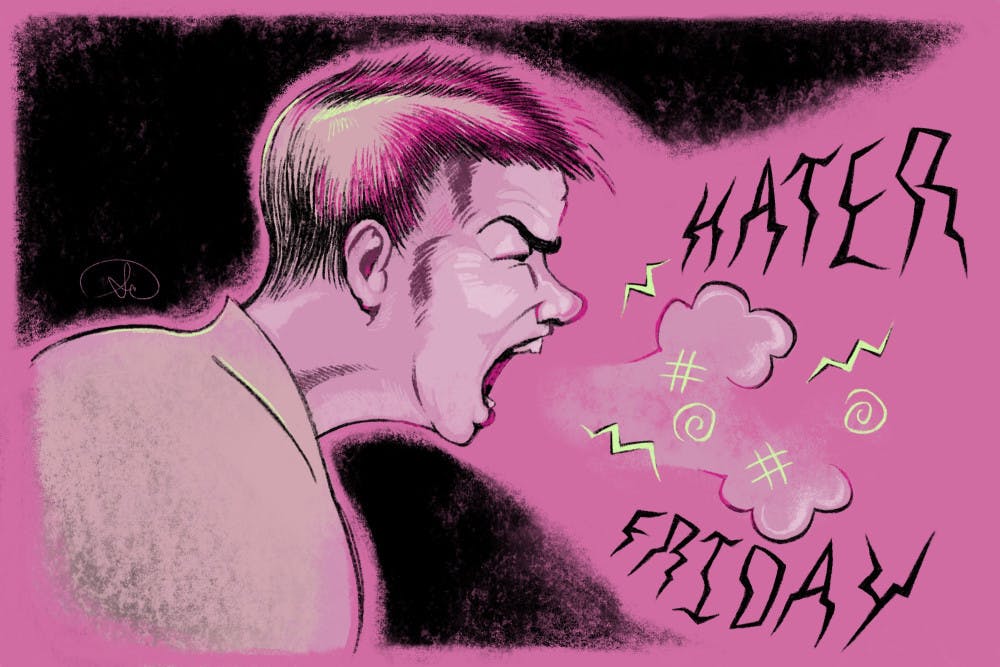
I am not ashamed to admit that I am a social media addict; my weekly screen time average for TikTok is 10 hours, Instagram is 7, and Pinterest (because Pinterest is a valid form of social media, but that's an argument for a different day) is 5. When TikTok was banned in the United States for 12 hours, I found myself so much more productive than I have ever been in my life: I cleaned my dorm, did my readings for SOC1101 like 2 weeks in advance and even finished my MATH1920 problem set in one sitting (hard to believe, I know!). But, most importantly, I found myself reflecting not just on how much time I spend on TikTok and other social media, but also on the content that I was consuming. And I realized something - once you look past the Shein hauls, TikTok vlogs and DIYs, there's something much more complicated happening on our explore pages: social media has become ground zero for a new movement to rebrand, waterdown and westernize Black and Latino cultures in order to make them mass-marketable.
This is not a new phenomenon, rather this has arguably been years in the making. For instance, see the rise of the 2022 trend of "Spa Water," in which TikTok wellness influencer Gracie Norton advertised to her half-a-million followers that she had come up with a cucumber-sugar-water concoction that was "anti-inflammatory and packed with antioxidants." What Norton failed to mention was that this "Spa Water" recipe wasn't an original and had in fact already existed for centuries under the name of "Agua Fresca." A Mexican and Central American staple, Agua Fresca dates back to the Aztec Empire and can easily be found being sold by Latino street vendors and corner stores. And that's just one example. Looking across social media we can see how Mexican esquites - a popular street food consisting of boiled corn kernels topped with lime juice, hot sauce, cotija cheese and mayonnaise - have been rebranded by white influencers as "Mexican Corn Salad" and horchata - a cinnamon rice-milk drink which holds origins in various Latin American and West African countries - as "mud water."
When these Latino recipes are prepared and served by the people they originated from, mainstream media is quick to dismiss them as gross, dirty and/or unhealthy. But, as soon as outside groups - who are almost always white - take it and present it as their own authentic "creation," they are quick to receive thousand dollar brand deals, glowing media coverage and praise for coming up with the next big health trend.
We can see these same patterns of appropriation within beauty and fashion spaces too. Most notably, is when Hailey Bieber shared her "go-to fall lip combination," a dark lip liner and lip gloss, on TikTok in order to promote a new release from her makeup brand Rhode. Bieber dubbed her look "glazed brownie lips," a look that went viral on TikTok until users began to note its similarity to lip combinations that Black and Latina women, including icons Selena Quintanilla and Aaliyah, have been wearing for decades.
Beauty aesthetics that have long been rooted in Black and Latino communities have been stripped of their cultural roots and rebranded as a go-to "clean girl" look by white social media influencers. Historically, these fashion and make-up trends have negatively been viewed as "unprofessional," "trashy" and "distracting" when worn by Black and Latina women, and yet, when they are worn by the right (read: white) influencer, they are suddenly deemed worthy of Vogue write-ups and Sephora shelves.
An argument could be made that these trends are ultimately harmless and even a form of cultural appreciation, not appropriation. But I challenge this idea. How much "appreciation" is actually being shown to Black and Latina communities if recognition and respect isn't awarded to these trends until they are completely stripped of their cultural roots and divorced from the Black and Latina women who popularized them? These fashion trends, makeup styles and dishes have always been viewed as vibrant, stylish and popular by their respective communities, it's just that mainstream social media couldn't acknowledge this until they were filtered through a white lens. So when these trends blow up on TikTok or Instagram by white, wealthy influencers, it should be seen for what it truly is: exploitation.
That's not to say I don't welcome cultural appreciation on social media because I do. The beauty of the modern digital world we live in is that everyone and everything is so interconnected in a way that wasn't possible 50 years ago. We have the privilege of being able to learn and participate in cultures and communities beyond those that we have direct access to. Cultural appreciation is wonderful when it is done right and with intention. This means white influencers giving credit where credit is due and ensuring social media companies are building an algorithm that uplifts Black and Latina creators who have always been sharing these trends online but have just been gatekept from the spotlight - because this is an issue that runs deeper than individual influencers. Social media platforms amplify whiteness; their algorithms, which decide what (and who) we see, favor white creators and whitewashed content in order to maximize their own profit. However, by doing this, they are ultimately contributing to a larger movement to erase Black and Latino culture from American media.
I understand the desire to use social media as an escape, there are days where all I want to do is mindlessly scroll on TikTok for hours in order to find some relief from the real world. However, nothing can exist devoid of context; social media reflects systemic inequalities we see in the real world, and the truth is that these trends from Black and Latino cultures have always existed and been popular. The only difference now? Who's profiting.
Leslie Monter-Casio is a freshman in the College of Engineering. They can be reached at lm953@cornell.edu.
FADED ON FRIDAY | Building an Elite Rotation 6:17 AM (8 hours ago)
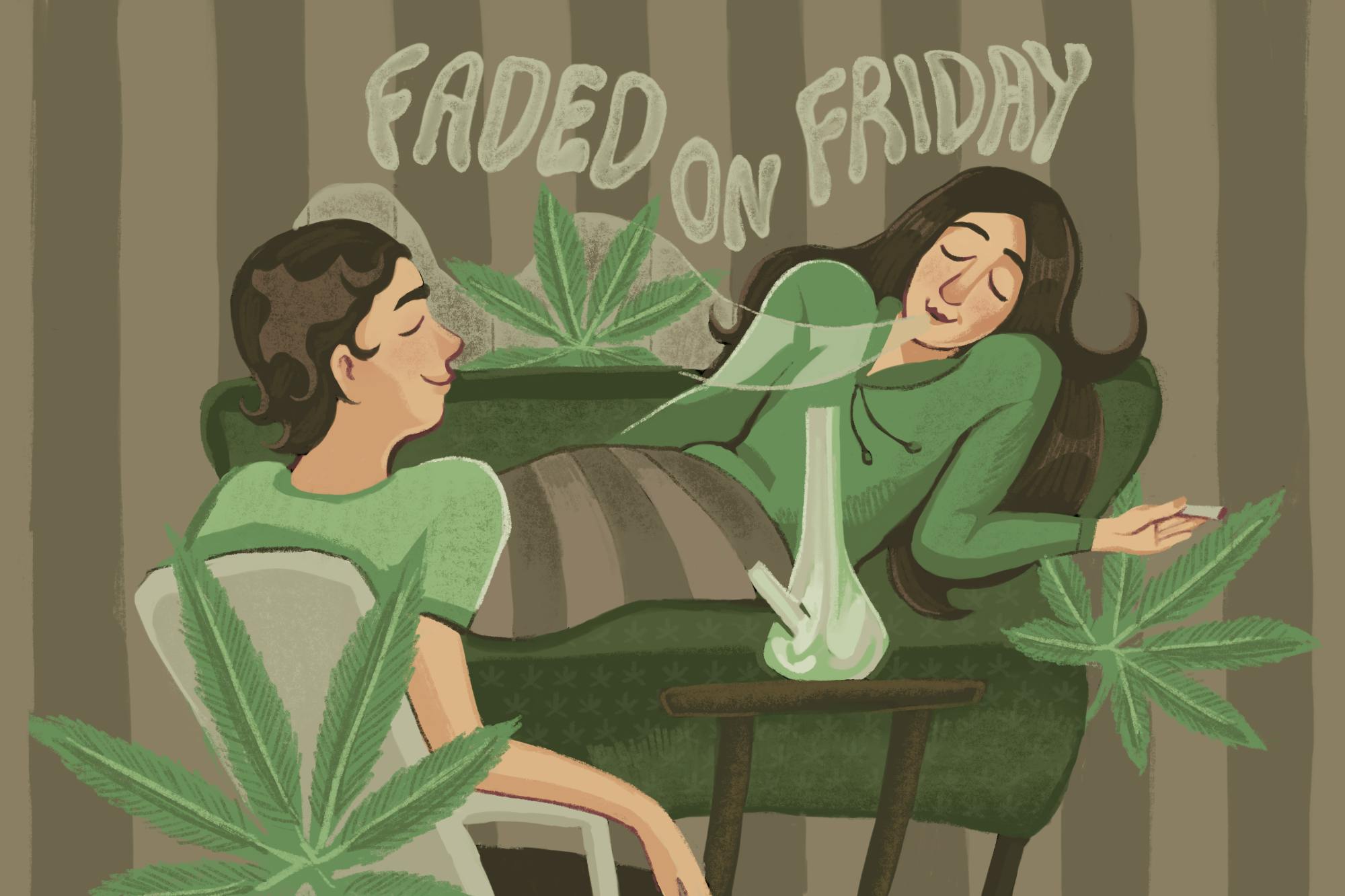
The big day is approaching. With 4/20 a couple of days away, it's time (now more than ever) to lock in. Obviously, the day is only as good as who you're getting high with, so today we'll be talking about the type of people you need to be around to actually enjoy your weed.
On a normal day, I'd say just go with whoever is there, but it feels disrespectful to, on the most meaningful and historically significant day of the year.
Number of People
The greatest groups of all time, in any field, have consisted of three to seven people. The Beatles, Kris Jenner's family and the Third Triumvirate all understood this. This rule also applies to a smoking rotation.
Smoking alone or with a friend is chill, but on 4/20 a larger group seems more appropriate.More people means more reactions to the weed, more side quests and ultimately more bullshit accomplished by the end of the night. Otherwise what's the point?
With the right amount of people, the perfect level of genius ideas are thrown around, and fulfilling the munchies is always better when the table talk can get heated.
People to Include
Not everyone who smokes weed should be in a rotation, so the choice of who you get zooted with has to be intentional. Look at Bill Clinton. The guy almost definitely lit up in the sixties, but then he got with an intern. He can play the saxophone, though.
That being said, the most important person to have is the one who's down for anything. Whether it's going on a two hour car ride to a random location or jumping into freezing water in the winter, this rotation member can be convinced to do it within a few seconds. They make every activity flow, and hold everything together.
The next member that should always be there is the idea generator. Somebody always has to have the perfect movie to watch, the perfect place to eat, or the ideal location to go to for doing absolutely nothing. If George Washington smoked, this would have been his role and the soldiers in the painting crossing the Delaware were our first character. Considering how cold it was and their chance of actually winning that war, maybe they were high that day.
A third huge member is the deep convo guy. Every group needs someone you could go up to when you're completely gone and you know your life will be changed, until the next morning, of course. When you're high, this individual sounds like Plato and Dostoevsky at the same time.
People not to Include
This is just as important, and sometimes the harder one to pull off. If someone comes up to you and asks to smoke, you may feel awkward telling them that you don't want to have a horrible night on one of the most important days of the year. They may offer to buy the product, which could be tempting.
However, I must urge you not to fall into the trap, although tempting you will suffer the same fate as Plankton, hanging out with a robot as people consume a better product than you with real members of society.
Possibly the most annoying person to smoke with is the one who is always worried about whether they are high. Counting up milligram amounts, hits, time since smoking and whatever other nonsense. They can never talk about anything else, and never actually feel any high because rather than just take more, they debate for hours with themselves, and for some reason everyone else, about how much they took.
I can guarantee you Hendrix had no idea exactly how much weed he had smoked before getting on the stage at Woodstock.Yet, his performance is still remembered to this day.
A quick note about people who don't get high with the group and try to be the "responsible" one, keeping people from doing mildly stupid actions: they're the worst and should never be invited.
Formation
This may seem strange, but the way the group is situated makes all the difference. There's the classic circle, or the horizontal couch lineup, or no structure at all. In terms of a large group during 4/20, the classical circle has to be the best option.
The knights sat at a round table for a reason. When the Avengers assembled, they did it in a circle. In much the same matter, for optimal performance a circle is ideal.
This way the joint also gets passed around more efficiently. Conversation flows seamlessly and no one gets too locked out. Of course, in an ideal situation, one or two people have broken away from the circle at certain points to engage in chicanery.
A day of great importance approaches. To make the most of it, you'll need an elite group that has a plethora of dumbass ideas. The people are out there, but you must find them and bring them together, because a good high is worth it.
Paul Allen can be reached atpaul.allen@cornellsun.com.
Kotlikoff Criticizes Kehlani's Slope Day Headline: 'It's Too Late To Secure Another Performer' 5:00 AM (9 hours ago)

After the April 10 announcement that Kehlani was selected to headline Slope Day, President Michael Kotlikoff responded to mounting concerns at the Thursday Student Assembly meeting by stating, "It's too late to secure another performer."
The soulful R&B singer is set to perform on Slope Day, the annual campus-sponsored concert on Libe Slope after the last day of classes. In the week following the announcement, dissatisfaction has surfaced as students and parents have learned of the artists' active political, specifically pro-Palestine, presence on social media.
Kolitkoff shared steps the administration had already taken to limit the artists' political impact on campus, including a clause in her contract.
"We also altered that contract to make it clear that if there are any political events at the performance, there is full forfeit of the whole compensation," Kotlikoff said. "We assured ourselves to the extent [possible] that this will be a successful event … without politics."
Kehlani's "Next 2 U" music video, released in June 2024, opens with a message that flashes "Long Live the Intifada." The word "intifada" literally translates to "to shake off" in Arabic. The word intifada is often associated with two Palestinian uprisings.
The First Intifada took place in the late 1980s and consisted mostly of nonviolent protests such as boycotts and demonstrations. However, this period was also marked by less frequent armed attacks by Palestinians. Israel's military response led to steep fatalities.
This led to the Second Intifada, which took place in the early 2000s. This uprising was incredibly deadly and is remembered for the slew of suicide bombings by Palestinians against Israeli civilians, including in buses and in restaurants. 4,300 died as a result of this uprising.
The music video features a Palestinian flag in the background for the second half, and the background dancers wear keffiyahs and wave Palestinian flags. The video, which has over 2.4 million views on YouTube, came just weeks after the singer posted strong political views against Israel on X.
"It's f*ck Israel, it's f*ck Zionism, and it's also f*ck a lot of y'all too," the singer said in a video expressing discontent with other music industry members not speaking up on behalf of Palestine.
In a Tiny Desk Concert performance in July 2024, Kehlani took a moment to share her support for Palestine again.
"I want to take a second to say free Palestine, free Congo, free Sudan, free Yemen, free Hawai'i," Kehlani said. "Beyond an end to the ceasefire, we need an end to the occupation."
The artist's statements about the conflict have been met with backlash from some Cornell parents in the Cornell University Parents Group on Facebook. One user wrote, "Given the threatened loss of $1 billion for anti-[Semitism], who at Cornell thought it would be a good idea to hire Kehlani for Slope Day?"
The New York Times broke the news of Cornell facing $1 billion in federal funding cuts on April 8. At the Thursday Student Assembly meeting, Kotlikoff said that the University still has "not gotten formal notification" of - and by extension, the reason for - the funding freeze.
Kotlikoff stated that the University was unaware of Kehlani's political views when beginning negotiations for her to perform in October, but now it is "too late."
"We found out about the social media of this performer roughly three weeks ago," Kotlikoff said. "It's too late to secure another performer that will be acceptable or appropriate for Slope Day."
Kehlani's performance follows a year of campus tensions surrounding the conflict in the Middle East and administrative crackdown on expressive activity.
Within the last month, 17 protestors were arrested or detained for protesting during a panel titled "Pathways to Peace," featuring four speakers on the Israeli-Palestinian conflict. Five of 13 detained protestors declined their conditional case dismissals in Ithaca City Court on April 10.
On March 28, the University released the final version of its Expressive Activity Policy, which walked back some of the Interim Expressive Activity Policy's most contentious points. The interim policy, which established guidelines and restrictions for expressive activity on campus, was implemented last Spring amid a rise in pro-Palestinian protests and increased national scrutiny over how Cornell responded to these demonstrations.
Kotlikoff claimed that Kehlani's political beliefs hasn't interfered with performances during her recent "Crash World Tour," which concluded in March at Northeastern University.
"That was a sold-out concert that had no political events," Kotlikoff said. "And by all accounts, a very successful performance."
Correction, April 18, 5:15 p.m.:A previous version of this article incorrectly stated that Kotlikoff did not know about Kehlani's political views until after the headliner was announced. The article has been updated to accurately reflect the timeline.
GUEST ROOM | We See Your Silence 2:00 AM (12 hours ago)
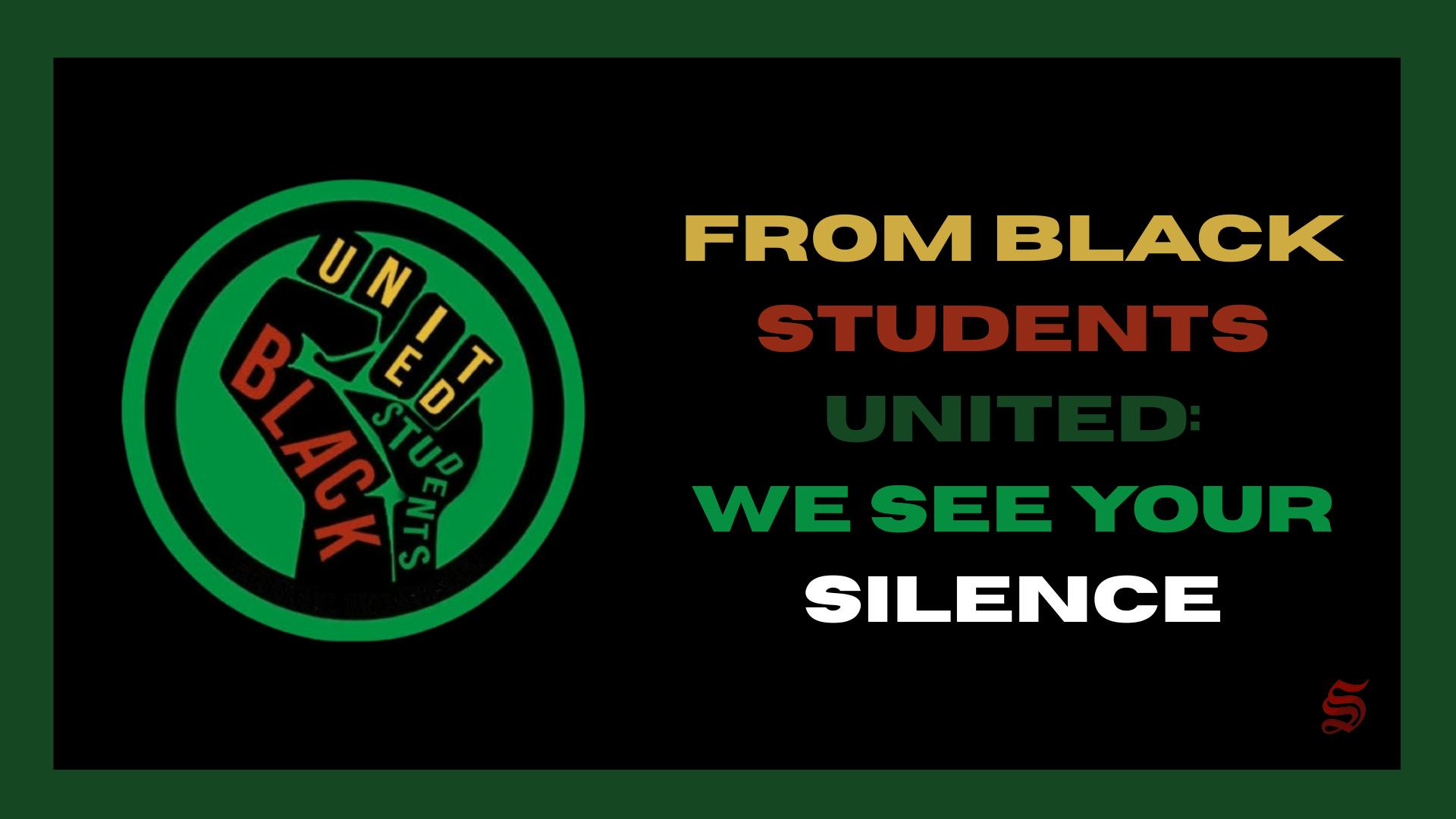
Last semester, Black Students United wrote a statement sharing our unwavering solidarity with Momodou Taal in the events that led to the Cornell administration's decision to suspend him - a decision that endangered his visa and livelihood. That semester, we fought long and hard alongside our Palestinian, Jewish and broader community members to oppose this decision. We all recognized the importance of standing up not just as students but as individuals at Cornell University who hold the privilege - and the responsibility - to speak up when many others are denied a platform to.
It is undeniable that under the Trump administration, America officially exists in a new era. We operate under an administration more frightening and aggressive than ever before - one that has openly shown minority students that we do not belong. One that has shown us we do not have a voice. One that has shown us that we are not worthy of its protection. The precariousness of our position as Black students at this institution has never been more terrifying.
There has been a chilling effect on the nation, one marked by fear. We have seen the forcible silence of dissent, the shutdown of programs created to uplift marginalized groups and the threatening and deportation of protestors. With this happening as Taal was being persecuted, we felt muzzled and beaten down - a return to a familiar condition of Black America, one rooted in the forced suppression of Black voices and ideals. We spoke privately about our discontent, but in fear of making the "white man" mad, we were intimidated into broader silence.
Many of our internal debates centered not on whether the Trump administration was wrong - that part was obvious - but on how we would survive our own fear. The first step was unlearning the defeatist mindset that if we spoke up, we would be next. But that fear is the very aim of this administration's actions: to suppress free speech and open expression of anyone, especially educated minorities, that dissents.
The Kotlikoff administration's behavior mirrors, albeit on a smaller scale, the playbook of the Trump administration - using threats and terror to induce silence. The Kotlikoff administration has threatened suspension of student organizations, arrested protestors and failed to protect our own from the Trump administration's illegal actions. The use of these exact strategies has sent a clear message that has reverberated through the entire student body: stay quiet, don't fight back, don't protest in order to keep your funding, your organizations, or even your place at this University. That fear mongering works - unless we stand up to it.
This is what Taal has seen from the very beginning. That's why he fought. Being on your "best" behavior will not save you. Appeasement will not save you. Capitulation will not save you - and more importantly it will never win you justice. Regardless of the intention, the Kotlikoff administration has fallen victim to the same intimidation tactics that we had.
By asserting that Cornell will always "follow the law" and refusing to publicly denounce federal pressure, Cornell has positioned itself to comply with the Trump administration. And yet, the University has still had to face the loss of over $1 billion in funding, the second-highest funding cut an American university has seen so far.
We affirm, again, our unequivocal solidarity with Momodou Taal: a Ph.D. candidate in Africana Studies, an esteemed scholar and fearless advocate for justice. The recent targeting he faced from Immigration and Customs Enforcement that ultimately led to his decision to depart the US is not only deeply shameful, but also emblematic of a broader systemic pattern. A pattern of silencing those who speak truth to power - especially individuals of color who defend Palestinian liberation.
Momodou's commitment to affirming the humanity of the Palestinian people belongs to a long-standing tradition of Black solidarity with international struggles - rooted in the shared fight against colonial violence, state repression and imperial injustice. His legal challenge to the Trump administration was a courageous act of resistance - one rooted in hope, dignity and the pursuit of justice not just for himself, but for all who have found themselves caught in the crosshairs of state-sanctioned injustice.
The revocation of Momodou Taal's visa and the threat of ICE detention were blatant attempts to suppress dissent and dismantle the intellectual and moral leadership of individuals who dare to confront global oppression. We strongly condemn these actions and the systemic forces that made them possible.
Momodou's absence is a profound loss to the Cornell community. His scholarship, leadership and commitment to political education through his podcast, The Malcolm Effect, enriched our campus and challenged us to think more critically about the world we live in.
As Black Students United, we echo his call for justice and we reaffirm our commitment to protecting the rights of scholars, students and organizers who dare to resist. We will not be silent in the face of injustice. We will continue to stand behind those who are targeted for doing what is right.
And to the Cornell administration: stand up and do what is right. Stand for academic freedom. Stand for the safety of your students - especially your international students, who now face increasing danger. Acquiescing to the demands of an unreasonable government has proven to be futile. Cornell must use its leverage as a world-class university and work with like-minded institutions to push back against the broader attack being made on the most sacred values of higher education.
In solidarity,
Black Students United at Cornell University
BSU is a student organization dedicated to promoting Pan-African unity by addressing political, organizational, institutional, social and educational needs on campus. They can be reached at bsu.cornell@gmail.com
JASO | Be Whoever You Want. Just Don't Be VP (for Now) 2:00 AM (12 hours ago)
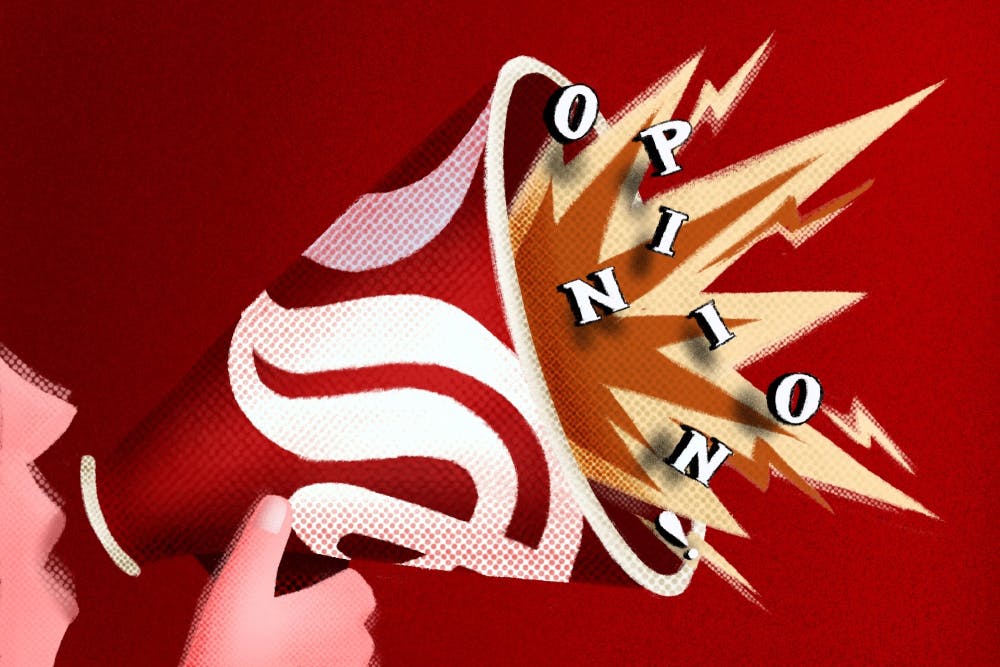
Wake up. Check Outlook. Parse the Slack chat. And "coffee chat" - whatever that means - a dorky freshman. He's eager, bright-eyed and convinced that a five-minute exchange with a disinterested upperclassman is the key to breaking into [insert acronym here]. But alas, he too will succumb to the institutional perils that Cornell flagrantly permits.
This scholastic phenomenon, to some extent, is appealing, but to less myopic thinkers, appalling. And it is especially peculiar that, while our institutions bicker at the government over inconspicuous funding (relative to endowment money aplenty), it is then when they pay no mind to the erosion of their principles, all whilst extending Student and Campus Life funding. But so be it: Viva Cornell's most popular, albeit dreadful, extracurricular activity: Careerism.
This parasitic entity, one that has infected every facet of student life, has effectively warped the purpose of higher education into something resembling a Tiger Mother's hellscape. Attend the first session of ClubFest, and you'll find that at least half of the organizations exist purely as gilded drinking groups or, in the instance of a national organization, diverge from central doctrine. Consulting clubs, pre-law fraternities, investment banking societies - whatever makes your wallet tingle - still attract woeful subjects, despite their decreasing relevance in the national labor market. Getting into some of these groups requires a multi-round interview process, complete with technical or outright absurdist questions, case studies, and a general willingness to forsake intellectual fervor in favor of being "marketable."
The university loves this. Self-sustained coalitions churn out the typical six-figure starting salary candidates, most of whom will suffer from anterior pelvic tilt and pupil strain over mere months, a trade-off neither I nor Gwenyth Paltrow would dare subject to. But those who do affirm the university's supposed funding methodology: that near-guaranteed, promisingly affluent alumni will inevitably drop their share in the offertory, largely without excessive mobilization or campaigning.
Only nostalgia can accurately depict the days when American universities were sanctuaries for intellectual exploration, for debates about Kant (or "c*nt") over cheap Napa wines and the occasional ill-advised foray into universalism. Higher education is a $90,000-a-year investment, and students are under hot pressure to secure a return on that investment. Yet, as if we had not established ourselves over our peers in secondary, a convoluted, elite-instituted monopoly on academia, ideology and labor divides us further.
English majors spend half their time justifying their existence. "What are you going to do with that?" is the immediate response to any major that isn't tied to finance, bioengineering or tech.
Despite our Ivy pedigree and university-touted idealism, the school has seemingly secured more hefty returns on equities and trades than it has on moral and spiritual cultivation. That centuries-old "promise" of virtue endowed not by a Carnegian employer, but attained through equal doses of self-cultivation and effacing - a guarantee that HR need not contemplate their candidate's moral aptitude nor critical thinking, but merely their Microsoft certifications and GPA. And alas, the numbers agree, with the popular CIS accounting for a whopping 17% of all undergraduates - because god forbid you waste four years learning something that is not monetizable.
And it isn't just Cornell. A recent article in The Atlantic described how students at elite universities are struggling to engage with literature beyond their assigned course readings. Making matters worse, many arrive at college like daughters in boxes, viewing themselves in the same sense they had prior to college: vying for interests that are not their own.
Now, we ought not be fully averse to these themes: ambition is not the enemy. There is nothing inherently wrong with wanting a solid job at Palantir working on LLMs that target refugees, or reaping cash from credit reliant Americans. We have to keep this lifestyle going somehow, no? But when the pursuit of employment eclipses the pursuit of knowledge, something vital, something human, is lost.
A university is meant to be a place of continual discovery, where students engage with ideas not because they're profitable but because they're frankly cool. Liberal education is not intended to produce instantaneous financial utility; it's about learning how to think, how to question, how to exist in the world with a mind that fetters to the whim of market fluctuations, or how many hours the suit must work overtime in the hope of Chipotle, or better yet, late drinks at Delmonico's.
So what's the solution? Let's start with reclaiming education as an end in and of itself. It entails embracing the humanities, not as a gen-ed, but as a pursuit that seeks to frame our current contexts with those of old; to evolve with, not against, technology. It means taking classes that don't translate seamlessly into Workday expectations. It is joining clubs for fun rather than for a vacuous LinkedIn accolade.
It means, simply put, being a student. If you weren't told to be whoever you want by mother dearest, allow me to be the one to do so. Be a social justice warrior; a haughty international student with three metropolises in their bio; a first-generation student unsure about her major, but destined to carry herself to the top regardless of shifts in interest.
The corporate world isn't going anywhere. But scholarship, introspection and even Hideaway? Those remotely disappear the moment you trade curiosity for the cloister.
So relax; open a novel, put that Clairo on - and get yourself a beer while you're at it.
Pulling Back the Curtain on the Class of 2029 17 Apr 9:54 PM (16 hours ago)
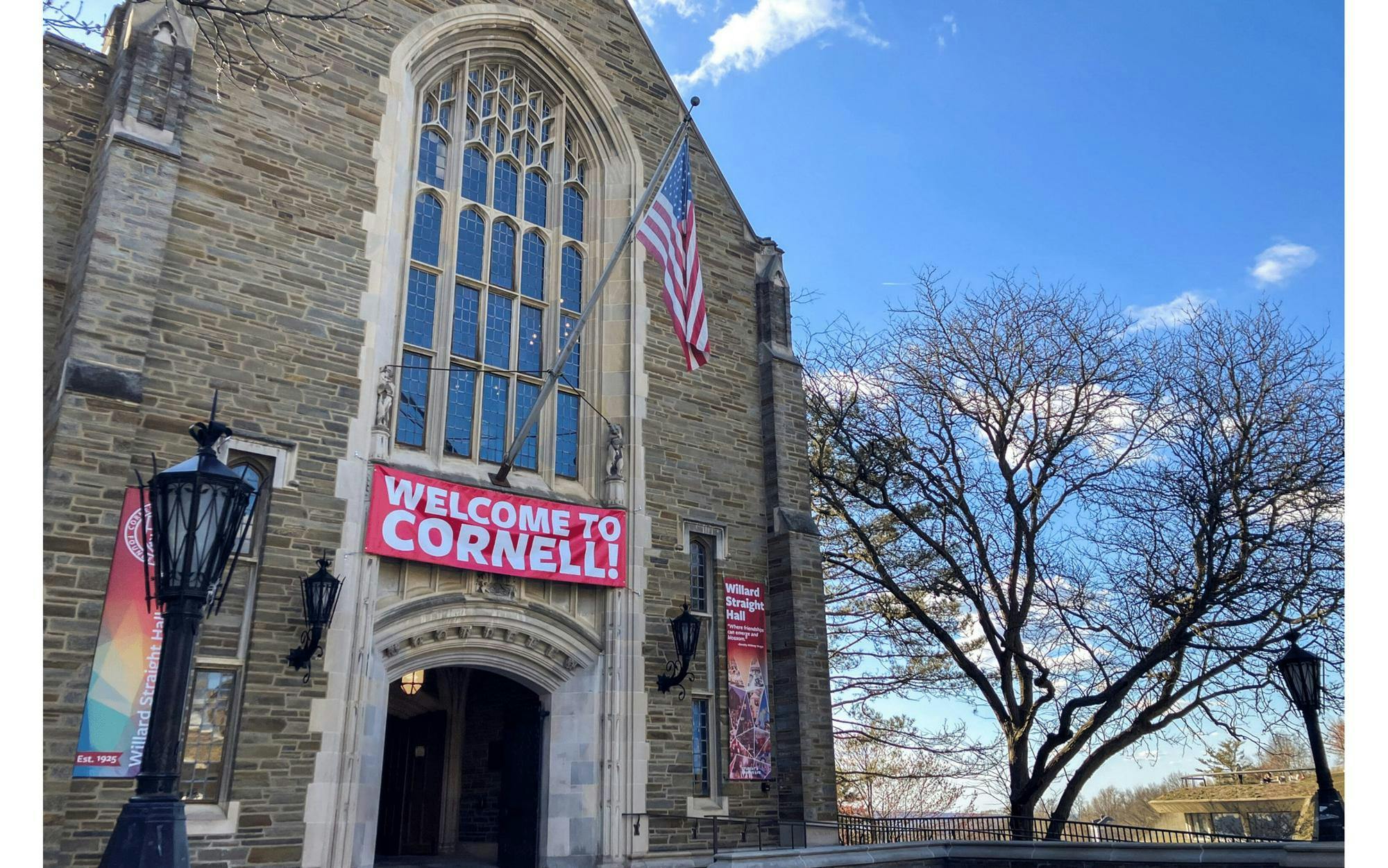
Rain or shine, admitted students from the Class of 2029 flocked to Ithaca from around the globe to attend Cornell Days and learn about the University on Saturday and Sunday.
Cornell Days is an annual event lasting multiple weekends in April, during which tours and various events are held across campus to teach admitted students about the school. One final Cornell Day will be held on Sunday, April 27.
This year, Cornell admitted 5,824 students to the class of 2029 from over 100 countries across the globe. In light of Cornell Days, The Sun spoke with some incoming students who have already committed to attending Cornell in the fall.
Why Choose The Hill?
Cornell offers unique programs that fit the specific needs of incoming students. Jackson De Guzman '29 is an incoming public policy major from Plymouth Meeting, Pennsylvania. He wrote to The Sun that he applied to Cornell because "the Brooks School is a cutting-edge policy program with strong connections to [Washington,] D.C."
De Guzman also appreciated that since Cornell has so many colleges, the Brooks School is "a small school within a bigger university, so I get the perks of both small and big schools."
Others fell in love with Cornell through their high school programming. Michael Chen '29 from Taiwan attended the Cornell International Debate Camp, a one-week summer camp, twice in 2023 and 2024, where he enjoyed participating in a "dynamic discussion atmosphere" with people from around the world, he said.
"That was my first realization of how diversity is very important," Chen said. "In Taiwan, … everyone had the same beliefs."
Others took a less conventional road to Cornell. Samara Cooper '29 from Eugene, Oregon, was matched with Cornell through QuestBridge's National College Match program.
QuestBridge is a non-profit organization that provides a community for and supports low-income students. Cooper received a full-ride scholarship to Cornell, room and board included.
"As a low-income student, I really never thought that I would get into an Ivy League school," Cooper said. "So not only having Cornell as an option but also receiving it with a full ride, … it was a no brainer [to commit]."
Students are looking forward to their time at Cornell for a variety of reasons. Student organizations are a source of excitement for many. Cooper is especially looking forward to joining the Mock Trial Association, and Chen is looking forward to exploring the Cornell Speech and Debate Program to continue his interest in debate, which brought him to this campus.
De Guzman is interested in organizations involved in political protests and organization at Cornell.
"Figuring out how to organize communities towards shared interests is a big part of the political process," De Guzman said.
Curiosity at CU
Students still have some unanswered questions about Cornell. Chen was interested in finance internships and the timeframe for obtaining one. Kashmir Tai '27, who majors in economics, has been accepted for a finance internship for the summer of 2026. She shared advice about preparing early for the internship application process.
"Each year, the recruiting timeline gets earlier and earlier," she wrote to The Sun. "This means that I need to prepare early, as early as starting in September [for summer internships]."
She also wrote about the importance of "networking" and researching market trends during the application process to prepare for interviews.
Cornell Career Services also offers support for finding internships, conducting interviews and writing resumes.
Additionally, Cooper was curious about the resources for low-income students at Cornell. The Centers for Student Equity, Empowerment, and Belonging include First Generation & Low-Income Student Support, which provides a number of resources such as the Access Fund.
Furthermore, during the Fall 2024 semester, the Student Assembly funded shuttle buses - free of charge for all Cornell students - to the Ithaca and Syracuse airports during finals week under Resolution 11.
The First Generation & Low-Income Student Support Center did not respond to a request for comment by the time of publication.
De Guzman was interested in how to obtain part-time employment as a student and what getting a job is like. On-campus job listings are generally posted to Workday, a job searching platform.
Winnie Chan '28 is a former Cornell Dining employee who worked as a cashier and barista at Novick's Café in the Fall 2024 semester. She wrote to The Sun about her experience with getting a job on campus.
"I applied for and got two on-campus positions across different semesters," Chan wrote. "Depending on the job, the application process can vary in how time-consuming or competitive it is."
However, Chan encouraged interested students to apply, explaining that employment "was a great way for me to step out of my comfort zone and meet new people!"
As spring rolls to an end, Cornell finds itself amid a tense political climate. The University recently saw 75 stop-work orders from the U.S. Department of Defense. The New York Times reported that the federal government froze over $1 billion in funding for Cornell, although Cornell administrators said they lack the information to confirm that amount. The campus has also seen a number of protests and student arrests over the past year.
Despite this, students expressed their continued willingness to attend Cornell.
"I think hard times are the times that define societies and how we respond to these problems, how we choose to stand up and fight. There's a lot of opportunity for good that comes out when there's a lot of tension," De Guzman said. "So I wouldn't say that I'm necessarily excited for it, but I don't think I'm afraid of it either."
REYEN | Qualitative Study Reveals ChatGPT Up, Critical Thinking Down 17 Apr 8:43 PM (17 hours ago)

On Thursday, OpenAI announced that ChatGPT Plus would become free for college students until the end of May. With this subscription, users will have access to GPT-4o, image generation, advanced voice mode and other research tools.
I've long suspected that the unparalleled degree of information access granted to us by the internet - and now, artificial intelligence - comes with a loss of internal memory function.
A 2019 study not only suggests this concern, but supports it, finding that the internet's constant "distractions" and ability to "offload" mental tasks hinder the development of higher-level critical thinking during key stages of brain growth in children and adolescents.
At Cornell, it's safe to say that I've seen the effects firsthand. Recently, I asked the Cornell Sidechat community how often they use ChatGPT to complete assignments. Out of 324 respondents, 43% responded "most of the time". Is this a function of overworking students, or of a tendency towards convenience?
Another 22% responded "when I don't know how to do the work". In other words, Chat is serving as a substitute for learning itself.
Forbes reports that an estimated 1 in 3 Americans between the ages of 18 and 24 use the platform.
While undeniably convenient, I have to wonder if this ready-access second brain is quietly dulling our own. While getting my laptop fixed last week, the employee on hand consulted GPT to answer my questions about my computer's lifespan. And when assisting a group of colleagues with printer issues, I peered over their shoulders to see the familiar "What can I help with?" in ChatGPT's minimalist interface.
Hoping to assess just how pervasive GPT use is on campus, I've taken to conversing with my peers. One student I interviewed was working on an essay for which her professor permitted ChatGPT use.
"It will only hurt me if I use it," the student said: the assignment was to create work samples for job applications.
She initially asks ChatGPT to generate an essay using the prompt and her notes, then refines awkwardly-worded sections herself before prompting GPT to improve the essay once more.
Collaborative? Or outsourcing?
GPT may seem like the busy student's solution to managing heavy course loads, job applications, and club activities. But what writing skills will we have left if the tool becomes the first - and final - draft? Using GPT as a crutch removes the process of forming connections and patterns while writing, minimizing the ability to learn from writing feedback and academic improvement.
Another student uses ChatGPT to turn class notes and an essay prompt into an outline, which she later develops into a cohesive paper. (And, she informed me, the key to job application efficiency is perfecting the slight tweak of an A.I.-prepared cover letter.)
Working to fine-tune the assignment, she wondered out loud: "How do I get ChatGPT to make this essay better without shortening it?"
"Did you run that through an A.I. detector?" another student added, peering over her shoulder.
But perhaps there's no need.
Professors are attempting to adapt, with GPT citation clauses included in each syllabus after the standard academic integrity boilerplate.
Yet, the prevalence of use and lack of corresponding Academic Integrity hearings demonstrates that the current state of A.I., compounded with the savvy of students, is evading any safeguards professors may have in place. For teaching academics, it surely must be frustrating to assume the role of anti-plagiarism enforcer.
One grad TA said he runs every student writing assignment through an A.I. detector. Still, even when seemingly obvious that a student has used A.I. for a writing assignment, unless hallucinated citations are present, he feels there's no concrete evidence that can be used as proof of cheating before an academic integrity hearing board.
(I'm saddened that my favorite punctuator - the emdash - is now apparently considered a sign of A.I. writing. Will an A.I. detector will flag my work too?)
My friends and I have noticed the introduction of annotated reading assignments on Hypothesis and marked-up close readings for essay assignments, possibly an effort to mandate "showing your work" in Humanities courses.
As an English major, I'm attuned to just how much of our learning comes from writing: not just expressing ideas but arriving at them as well. (For the record, I have yet to be impressed by ChatGPT's attempts to stand in for quality, human-authored prose.)
I acquiesce that students must adapt to the changing times, that a Luddite mindset will only leave us behind in the fluctuating job market. However, I caution the "offloading" of academic tasks at the expense of critical thinking.
I'm not trying to be Holier than Thou by any means. It's objectively a waste of our tuition dollars to leave behind the soft skills that ChatGPT often steps in for. And we're not only losing out on skill development; each time A.I. helps with an assignment, we're teaching GPT how to more effectively replace us.
The university's shift towards pre-professionalism (consulting, tech, etc.) may be accelerating this decline. As we train students for jobs, GPT becomes less of a shortcut and more a symbol of a trend away from thinking for thinking's sake. I worry that higher education's chief objective will become churning out corporate robots.
Are the STEM fields safe from A.I. corruption for now? One student lamented that GPT was unable to answer a coding homework question due to the specificity of libraries required.
In my neurobiology and behavior class, our professor warned us about A.I.'s tendency to butcher scientific writing by summarizing badly, hallucinating nonexistent citations and omitting the word "not," thus falsifying information.
Yes, Chat use at Cornell may be symptomatic of overworked students grasping at any method that might help them pass the semester. But looping in another professor to the conversation, he told me that students rarely attend office hours. Easy access to GPT may also allow students to slide through their four years of college avoiding voicing questions to the human resources on campus or building meaningful relationships with faculty.
Perhaps, then, this is another of the reasons for the rejection of academia. Not only can machine learning complete basic course functions and reduce labor, but students are checking out of their work - there's no incentive to do it themselves when a 24/7 virtual assistant is waiting eagerly on computer screens to transform assignment prompts into deliverables.
Whether or not I like it, last fall's headlines confirm that "ChatGPT Is Coming For Higher Education." Arizona State University, for one, has been working with OpenAI since early 2024 to develop ChatGPT Edu, with functions such as individually tutoring students.
The CEO of OpenAI has said that ChatGPT will create new knowledge and provide stepping stones to answer otherwise unsolvable problems, altering the current job market in some positive ways.
Can we trust this testimony? I doubt I'm alone in my skepticism. Several students shared my lethargy to get with the times, A.I.-wise.
"I never use it," one student said.
I'm hopeful that the GPT Plus deal's requirement of a university email address will encourage engagement with assignments, with a healthy fear of academic integrity violations and university surveillance preventing actual cheating.
GUEST ROOM | "Little p" Politics 17 Apr 6:23 PM (20 hours ago)

Like many professors, I love talking with students about big ideas. Because I teach law and public policy, the ideas my students and I discuss are often weighty and contested.
However, in the State Policy Advocacy Clinic, a course in which students design and advocate for evidenced-based public policies, my students and I often wrestle with surprisingly mundane questions: "Why didn't our stakeholder follow our advice?" or "Did you see the legislator's expression when you mentioned x; what was that about?" or "That meeting was a bit of a disaster. What should we have done differently?" We read William Ury's Getting Past No, which teaches negotiation skills, try its tips on our unsuspecting partners and laugh when we catch our classmates using its strategies on us.
Why do we devote so much time to building emotional awareness, social skills, teamwork, negotiation, relationship building and other "soft" skills when the presumption is that policy debates are decided by the strength of data, evidence, rhetoric and principle?
The reason is that years of practice experience have taught me that a shocking number of public policy and political decisions are made based on "little p" politics. Little p politics refers to the emotional and interpersonal considerations that drive people's behavior. Data, evidence, theory, framing, timing, hard work, grit, good luck, financial resources and political support from powerful interests will only get you partway to where you want to go. The rest depends on interpersonal skills and relationship building.
At first, I resisted this. I love ideas. I loved law school because of its rigor and discipline. I attended law school at the University of Chicago, where soft skills - all things practice-oriented - were looked down upon.
Then I started working. It soon became clear that the best lawyers, politicians and leaders were not necessarily the most intellectually gifted, hardest working or best educated. Rather, they were the people with the strongest interpersonal skills.
This is even more true in policy and politics. Whether a good, evidence-based policy idea is passed into law is often more of a function of "little p" political considerations - is the sponsor of a bill well-liked in the legislature, are the advocacy groups getting along, can the right person take credit for an idea - than on "big P" political or ideological considerations, like one's opinion about the proper division of power between state and local government. Sometimes these considerations seem petty. But even people who are passionate about ideas, evidence and principles are rarely immune to occasional bouts of small-mindedness, jealousy or territoriality, especially when they are stressed.
These skills are best learned through practice, trial and error and reflection. In our Clinic, when a stakeholder meeting goes poorly, we deconstruct it in class. Students practice their policy pitches on their teammates who play the role of legislators and executive branch officials. We invite legislators and community leaders to class and observe their behavior. We watch one another and seek to emulate students with the strongest soft skills along various dimensions. Most importantly, we share and reflect openly and honestly on what has worked and what hasn't. We acknowledge our mistakes and apologize when we mess up, as we invariably do.
Here is where diversity in the classroom is so useful. Students from different backgrounds bring different strengths and skills in terms of communication, teamwork, project management, negotiation and relationship building. Our ability to be effective often depends on our ability to connect with policymakers and community members. Sometimes the common thread is hometown, cultural or linguistic background. More often, it is common extracurricular passions, work experience, policy passions or taste in movies.
You might think that "little p" political skills are necessary only for those who pursue careers in law, policy and politics. Not at all. They are foundational to success in business, medicine, the sciences, the arts, academia, human services and almost all other careers. Like most skills, they don't just "come naturally." They can be learned, and they can be taught. That is one reason why engaged learning, research and small classroom opportunities are so important.
Maya Angelou famously said, "I've learned that people will forget what you said, people will forget what you did, but people will never forget how you made them feel." Especially now, as outside pressures on the University heighten stress within our community, it is important to practice teaching one another these skills.
Alexandra Dufresne is a Professor of the Practice and the Director of the State Policy Advocacy Clinic at the Brooks School of Public Policy at Cornell.
The Cornell Daily Sun is interested in publishing a broad and diverse set of content from the Cornell and greater Ithaca community. We want to hear what you have to say about this topic or any of our pieces. Here are some guidelines on how to submit. And here's our email: associate-editor@cornellsun.com.
Around the Sun: 4/20 Edition 17 Apr 3:32 PM (22 hours ago)
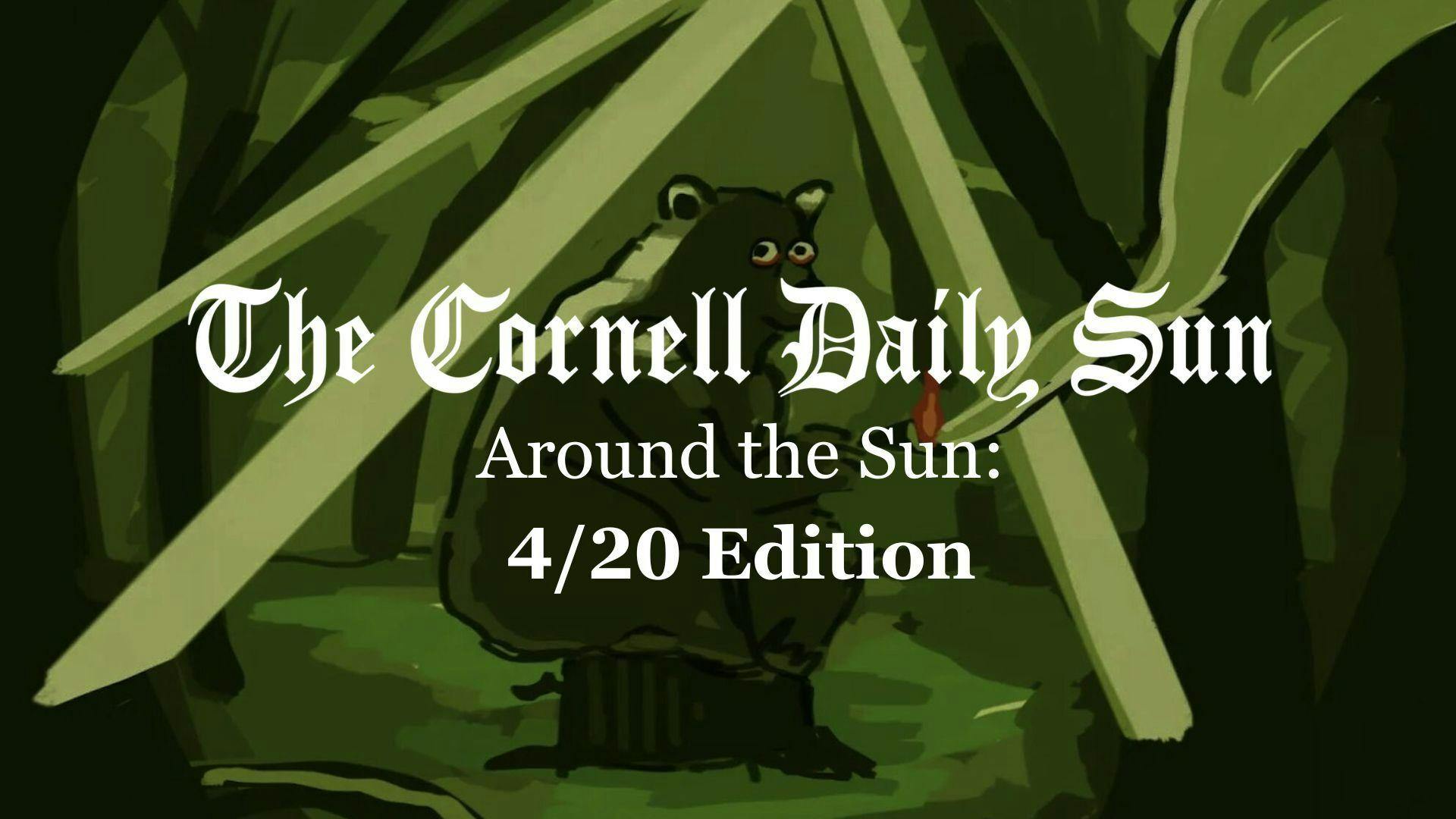
4/20 MULTIMEDIA | On this edition of Around the Sun, City Editor Gabriel Muñoz and Social Media Editor Jade Dubuche share this week's good news.
Hosted by Gabriel Muñoz, Jade Dubuche
Filmed by Jade Dubuche, Gabriel Muñoz
Edited by Marian Caballo
Produced by Jade Dubuche, Gabriel Muñoz
PREVIEW: No. 1 Men's Lacrosse to Face No. 10 Harvard for Final Top-10 Matchup of the Season 17 Apr 2:09 PM (yesterday, 2:09 pm)
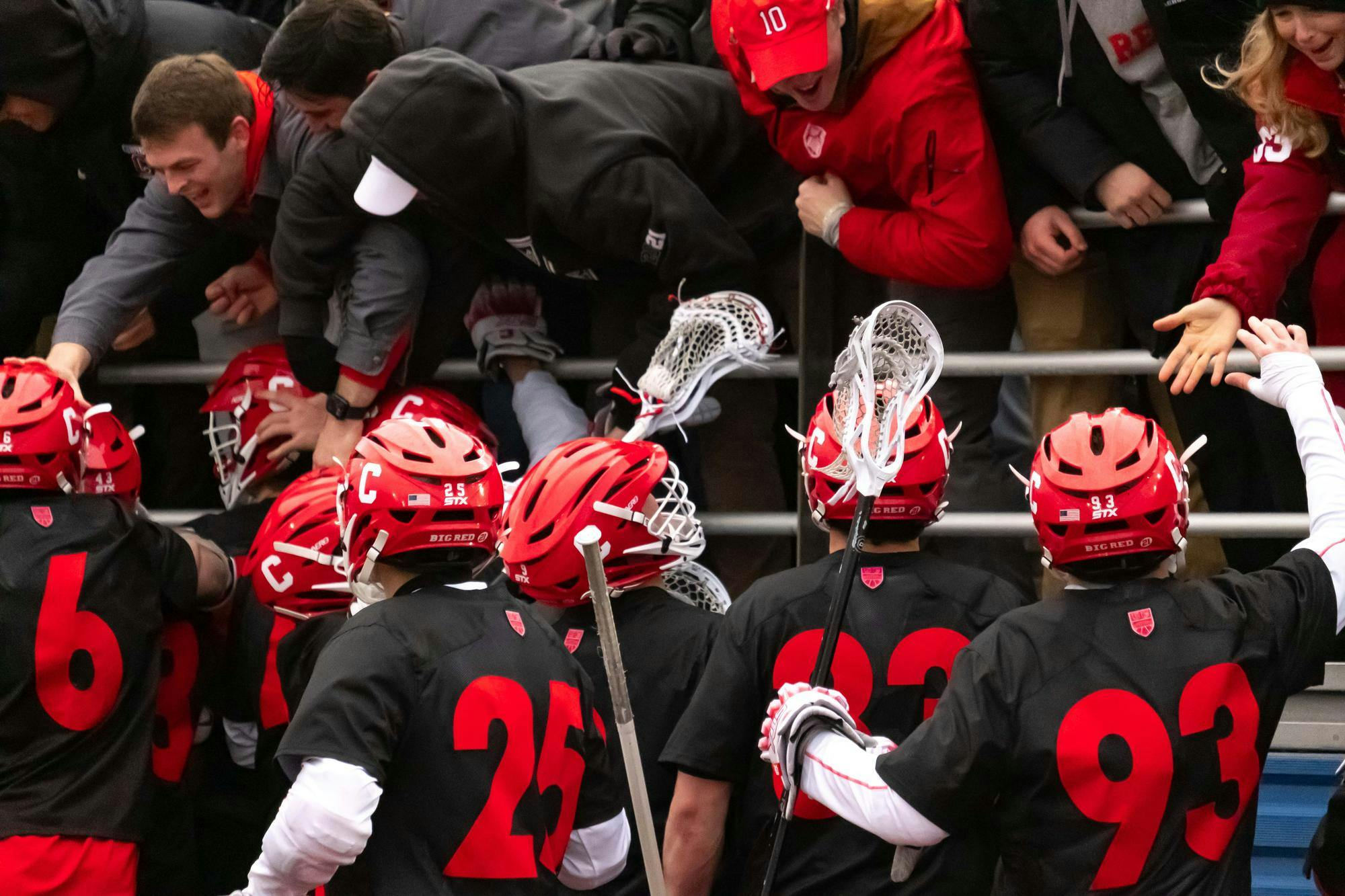
With just two games left in the regular season, men's lacrosse remains at the top of the polls. Though it's looking good for the Red's postseason prospects, there's no time to sit back and relax.
This Saturday, Cornell (10-1, 4-0 Ivy) travels to Cambridge, Massachusetts to play No. 10 Harvard (9-2, 3-1 Ivy), a powerhouse in its own right. The Crimson's only loss in the Ivy League this season came against No. 2 Princeton on March 22, and since then Harvard has taken four straight games, all by a margin of at least five goals.
The offensive trio of Sam King, Jack Speidell and Teddy Malone have all contributed over 40 points to the Crimson's attack this season and are a force to be reckoned with.
"[Harvard has a] great offense," said head coach Connor Buczek '15 MBA '17. "They score goals in bunches. It's always hard to play a great team on the road. We know we're going to get their best, and we have to show up prepared and execute at a high level in order to get a win."
The Red is coming off an electric victory against then-No. 4 Syracuse. Recent games against Syracuse, UAlbany and Penn saw Cornell pull ahead in the first quarter, and Harvard has also benefited from the same early lead.
Cornell tops the list of most productive offenses, averaging 16 goals per game. Harvard, however, is not far behind, tied for second with 15.
"[The game against Syracuse] was one of our most complete efforts to date," Buczek said. "That's the goal, is to keep getting better."
The battle for possession begins at the X, and the Red has a gem in junior faceoff Jack Cascadden. Cascadden now boasts a 58.9 percent faceoff percentage, a statistic bolstered by 68.2 and 51.6 percent performances against Brown and Syracuse, respectively.
In contrast, Harvard faceoff Jackson Henehan has a 43.7 percent success rate, while Matt Barraco has taken 45 percent over half the number of faceoffs. Both players had a good day against Penn last Saturday, however, with Henehan going 6-9 and Barraco taking 7-12.
Though Henehan has taken more faceoffs for the Crimson this season, the first-year has been yielding to junior Barraco in recent games.
With its dominant offense - senior attackman CJ Kirst six goals away from holding the NCAA record for highest career scorer - Cornell has depended upon success at the net over defensive prowess. It managed to hold Syracuse, also a team powerful on the attack, to 12 goals, and another solid performance from senior goalkeeper Wyatt Knust may be needed to keep the Crimson at bay.
"We're trusting the guys on [the] ball," Buczek said. "Wyatt [Knust] has given [the defense] a lot of confidence. Overall, I've been proud of the growth of that unit and where they're heading."
The teams face off at noon this Saturday in Cambridge, Massachusetts. Live coverage will be provided by ESPN+.
Homogeneity, Inequity and Exclusion Announced as Academic Theme Year 2025-2026 17 Apr 11:57 AM (yesterday, 11:57 am)
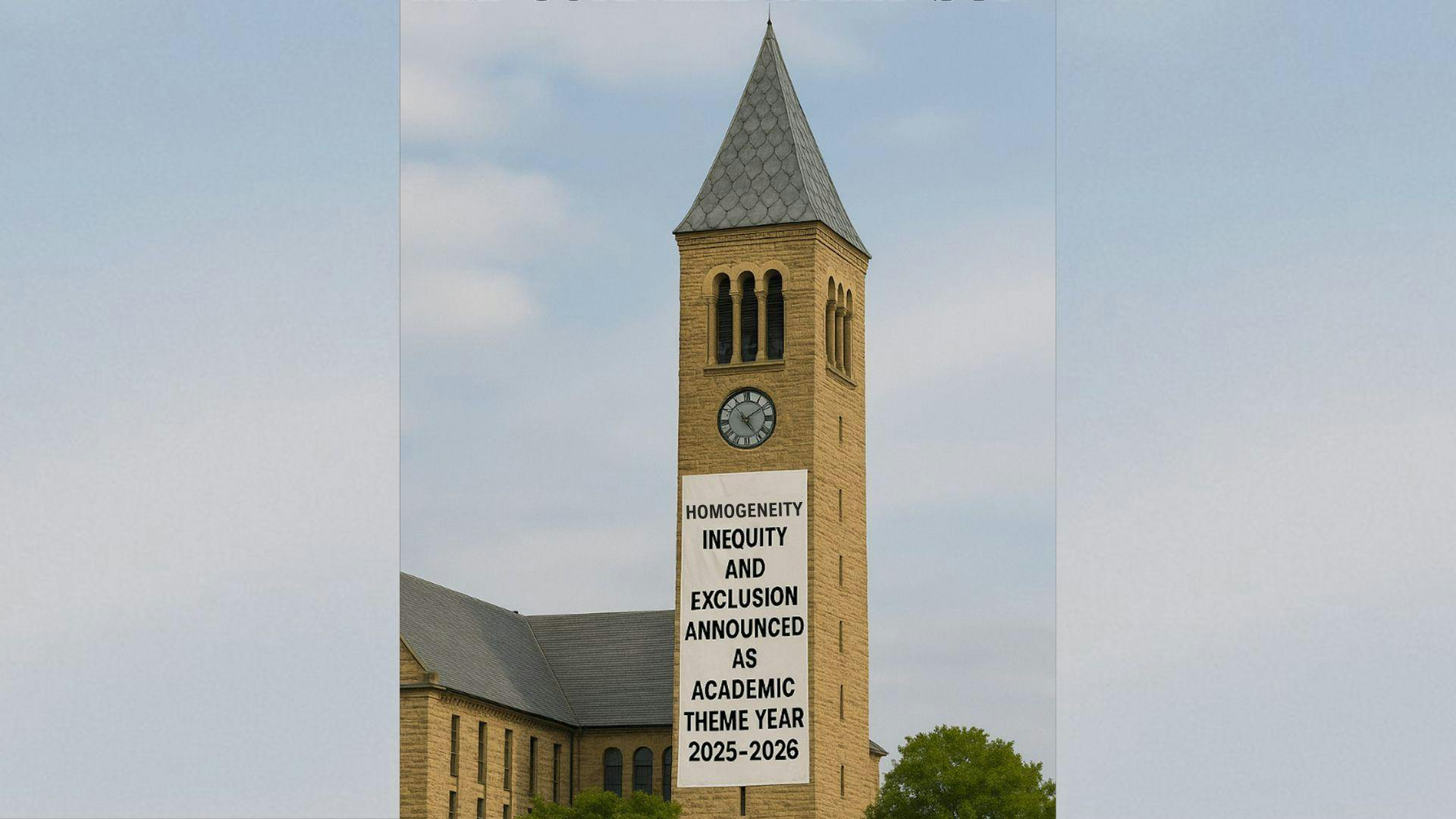
The University will dedicate $1 billion in federal funding to embrace homogeneity, inequity and exclusion as part of the academic theme for the 2025-2026 school year, according to a fax sent to the Cornell community on Sunday, April 31.
Under the academic theme year, students and faculty are expected to embrace the spirit of HIE. Some of the initiatives launching this fall include: a common NetID for all undergraduate students, food rations proportional by tax brackets and senior-only libraries according to the fax signed by President Michael Kotlikoff. Additionally, all undergraduate students will have to change their names to "Michael" to comply with the homogeneity.
"The decision was all mine. I just thought everyone should have the same name to avoid confusion," Kotlikoff said. "Michael is a beautiful name, a wonderful name."
Dining halls will now operate under a caste system, where all students will be assigned a number based on their need for aid on their initial application. If students have a net worth of over $500,000, they will have access to all dining halls and unlimited meal swipes.
Those whose families have a net worth under $100,000 will have one ration of Okenshields lunch leftovers a day. University administrators said the move would encourage students to take advantage of other side jobs to "get their bread up."
"We have a looming recession. It is just a matter of time until the 'brokies' have to adapt to eating like back in the good old days when America was great," a student who just qualified for the unlimited meal plan said. "Maybe they can start an OnlyFans or something to add some zeros to their accounts."
While upperclassmen used to have preference over housing and class selection before, they will now have the ability to vote for certain buildings to bar underclassmen from accessing them.
"We just thought we would bring back meritocracy. Those who have paid the most will get access to services, with no more freeloading for those freshmen who keep walking in the middle of the sidewalk," Dean of Students Marla Love said.
The University's new pep chant will also change as a result of the fax announcement.
"Cornell HIE!" will become the new school chant at all sports events.
Mike M. Michael was formerly in the College of Engineering before all students were integrated into the College of Arts and Sciences to ensure homogeneity. He can be reached at mmm1880@cornell.edu (along with all other students).
Editor's Note: 4/20 content is a part of The Sun's joke issue and contains exaggerated and factually inaccurate information.
BURZLAFF | Beyond the Silent Wall: Participation Is a Process, Not a Performance 17 Apr 10:07 AM (yesterday, 10:07 am)

In her recent op-ed, Opinion Columnist Julia Poggi describes the frustration of looking around a room and seeing "a wall of silent, disengaged students." It is a striking image - one that resonates with many who have experienced a classroom where participation feels more like an obligation than a dynamic exchange of ideas. Poggi argues that this reluctance stems from exhaustion, performance anxiety and an unspoken fear of being perceived as a "try-hard." In her view, participation has become either performative or absent altogether, with discussions dominated by a handful of voices while others disengage behind laptop screens.
Poggi identifies real challenges, and the fact that many students share her experience must be taken seriously. However, I would like to offer a perspective from the other side of the classroom - one that might help students better understand how participation looks from a professor's point of view. Silence does not always mean disengagement and I have not encountered the quiet classrooms she describes. This semester, for example, I teach The Past and Future of Holocaust Survivor Testimonies, a hands-on course that explores evolving forms of Holocaust survivor testimony, combining historical analysis with AI methods. Students work collaboratively on these largely untouched archives, examining how testimony and memory have been recorded, interpreted and reshaped across different historical and cultural contexts. Last week, I struggled to keep up with all the hands raised as we analyzed relationships and encounters between 1939 and 1945. I have thus found participation to be a dynamic process rather than a simple function of student motivation, social anxiety or digital distractions. Participation flourishes when students are given open-ended inquiry, collaborative interpretation and structured opportunities to connect. That process, however, does not happen automatically. Below are two ideas that can help foster meaningful engagement in the classroom.
First and foremost, one of the most effective ways to encourage participation - at least in the humanities - is to ask open-ended questions that do not seek a single "right" answer. A rigid, instructor-led model can discourage engagement, whereas a dynamic, adaptive approach draws students in. Discussions thrive when students feel their contributions actively shape the conversation rather than merely affirm what is already known. Last week, for example, we examined human behaviors in video testimonies. Instead of asking students to categorize responses as simply "hostile" or "sympathetic," we explored how tone, pauses and omissions shaped our understanding of others' behavior. This reframing led to a rich, layered discussion in a class attended by students from disciplines as varied as information science, economics, psychology, government, history and sociology. Because the questions had no predetermined answer, students recognized that their interpretations mattered - not only within their own field but in dialogue with others. The result was an energetic exchange that transcended disciplinary silos.
This same approach works in traditionally rigid settings as well. When I was a guest lecturer for Antisemitism in the Courts and in Jurisprudence at the Law School earlier this semester, students - once encouraged - did not hesitate to debate complex legal and historical questions. The notion that some disciplines are inherently more silent than others often overlooks the role of classroom structure in shaping discussion. Rather than accepting silence as inevitable, instructors can thus create low-stakes opportunities for engagement - such as short reflective writing exercises, peer discussions before full-class debates, or inviting students to submit questions anonymously. In my experience, these small adjustments make participation feel less intimidating.
Therefore, equally important is fostering a collaborative atmosphere where participation feels like a shared effort rather than a performance - something Poggi rightly emphasizes. However, in my experience, Cornell is better positioned than other Ivy League institutions in this regard. At Harvard University, where I taught until last year, I saw this hesitation in full force. One day, I brought a cake to class, and nobody touched it - until a student confessed a week later that they didn't want to be the first. This reluctance exemplifies the dynamic of classroom participation: Often, students hesitate not because they lack thoughts to share, but because they are waiting for someone else to break the silence. At Cornell, I have observed a greater ease in classroom exchanges, where students are more willing to take that first step.
To students, I would emphasize that this reluctance is completely normal. In my courses, it typically takes two to three weeks for discussion to flow naturally. One major reason is that, at our large university where isolation is common, students often do not know their classmates when a course begins. Speaking up in a room full of strangers can feel daunting. Similarly, the fear of speaking up often stems from a growing culture of competition. When students view participation as a performance - where their contributions ought to be flawless or impressive - many will opt for silence rather than risk being judged. To counter this, I have made structured group discussions a staple of my courses, allowing students to first build confidence in smaller settings before transitioning to full-class discussions. This fosters a sense of community, making participation feel less like a competition and more like a shared intellectual process.
Ultimately, participation is not just about getting students to speak more; it is about creating an environment where they feel encouraged and equipped to contribute. I teach students from across the university, including engineering, business and the agricultural college. In my courses, I make a point to emphasize that there are no stupid questions, only stupid answers - because engagement often begins in unexpected ways, opening up new avenues of discussion and revealing gaps in our assumptions. By reinforcing that all contributions have value, I encourage students to see participation not as a test of knowledge, but as a mutual process of exploration and discovery. To be sure, taking classes outside one's comfort zone is both brave and exciting. We should take silence as an opportunity - to open up the questions, to get to know each other and to ensure that everyone, when ready, has the space to speak. The next time you hesitate to raise your hand, remember that participation is not about performing - it is about making the classroom a space where your voice, and those of your peers, truly matter.
Jan Burzlaff is a postdoctoral associate in the Program for Jewish Studies. He can be reached at jb2825@cornell.edu.
The Cornell Daily Sun is interested in publishing a broad and diverse set of content from the Cornell and greater Ithaca community. We want to hear what you have to say about this topic or any of our pieces. Here are some guidelines on how to submit. And here's our email: opinion@cornellsun.com.
LETTER TO THE EDITOR | Faculty Call on Trustees to Oppose Political Interference in Higher Education 17 Apr 10:00 AM (yesterday, 10:00 am)

Editor's Note: The following letter was submitted to the editor on April 16 2025 and was released on April 17 2025 to the Cornell Board of Trustees and general Cornell community.
This is an open letter signed by more than 500 Cornell faculty members. On this National Day of Action for Higher Education, we join colleagues from 14 universities around the country who have signed similar letters. Here at Cornell, there will be a rally today at 5:00 pm on Ho Plaza. We hope faculty, staff and students will join us in calling on the Cornell administration to stand up to attacks on higher education.
Dear Members of the Cornell Board of Trustees,
Ongoing attacks on American universities threaten bedrock principles of a democratic society, including rights of free expression, association and inquiry. In light of this unprecedented assault, we urge Cornell's leadership to do three things:
1.Continue to publicly condemn attacks on universities.
2. Legally contest and refuse to comply with unlawful demands that threaten academic freedom and university self-governance. Freedom from political interference has allowed American universities to lead the world in scientific,medical and artisticinnovation,as well as humanistic and social scientific research, from which our entire country benefits.
3. Work with other universities and Cornell's own alumni networks to mount a coordinated opposition to these anti-democratic attacks.
Signed,
The full list of all signees ishere.
Cornell faculty are invited to sign the petitionhere.
BREAKING NEWS: Oscars Now Require Movies to Use AI 17 Apr 10:00 AM (yesterday, 10:00 am)
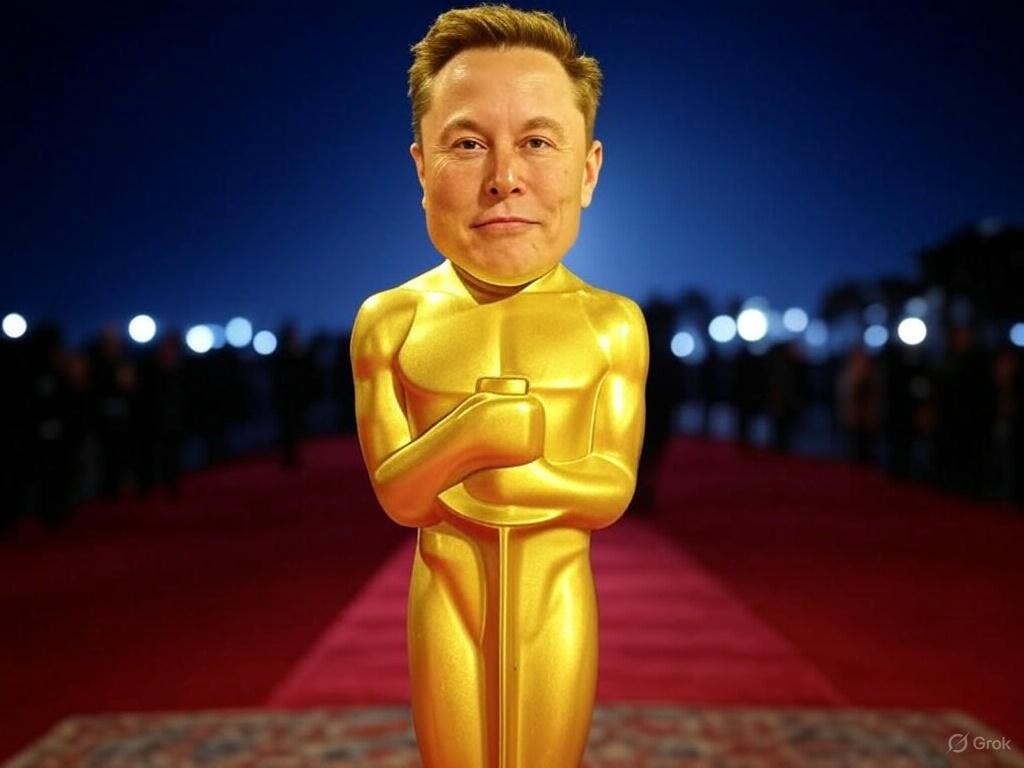
The Academy Awards, the annual awards show, A.K.A. the Oscars for illiterate barbarians, will now require films to utilize artificial intelligence in their work to be eligible for any awards. This change comes after the A24 film, The Brutalist, won three Academy Awards: Adrien Brody for Best Actor, Lol Crawley for Best Cinematography and Daniel Blumberg for Original Score Music. The editor for The Brutalist, Dávid Jancsó, revealed in an interview that he used AI to make Adrien Brody and his co-star Felicity Jones' Hungarian more legitimate in the film. This use of voice-generating AI has made the film's nominations and awards debatable and potentially undeserving. But why do hours upon hours of voice training (or hire an actual Hungarian actor) when you can kill four forests to make it sound legit? .
In a recent interview, the Academy Awards revealed that it was for this very reason The Brutalist was nominated for ten awards and won three. The Oscars applauded The Brutalist for using AI in this decade where tools like ChatGPT and DeepSeek are making creativity more efficient. Elon Musk, whose later venture is becoming the majority stakeholder of The Academy said, "Everyone should use AI in their artwork. If you're not, how are you going to increase stakeholder value, you worthless attempt at a jester?"
The Oscars is now even contemplating rescinding awards from movies that did not use AI for being pretentious and preachy - Parasite, Moonlight and Spirited Away are rumored to be first. Schifen Spillvert, director of the Academy, said, "The lack of AI use is creating a barrier for others to produce films. Why should we pay livable wages to overconfident animators? Once the Academy recognizes only the films that use AI, we will have more films and more work, generating the greatest good for the most people."
Let's look at Dune: Part Two. Wouldn't the film have been better if Timothée Chalamet was AI-generated? AI could have come up with a more biblically accurate twink. The majority of people already accept special effects like green screen use and CGI. How is AI use any different? Perhaps if Emilía Perez had used AI for their Mexican accents, it wouldn't have been such a train wreck.
The Arts Department reached out to the academy on the question: Do you expect other awards shows to follow in your footsteps?
We pleasantly heard back in ten minutes. They wrote to the Sun,
"Certainly! Here are a few reworded versions of your quote, depending on the vibe you're going for:
We firmly believe at the Oscars in accessibility. Despite art being the most human activity, tracing back to the caves with handprints, it's much better for people to use AI in their artwork so others can produce films. AI makes it easier to produce. Soon, there won't be any need for producers, editors or writers. Next are actors. Why have people taken up space in the creative world when AI makes production and creation more efficient and overall better? AI is just better. Plain and simple. People keep wondering if AI will ever be as good as people, but what they don't get is, AI is already better.
This is not AI, we can absolutely certify this.
Let me know if you need assistance with something else or if you want to edit my response."
Once art is out of the hands of people, won't it be better? More accessible, more common, more generated: sounds like a dream.
Once art is no longer a problem for people, there will be more time for work, housework and increasing stakeholder value. Absolutely no reason for humans to busy themselves with creating art when AI can do it for them. Why even think? Chat GPT has already thought of that, and that too. The assembly line is meant for people, not the stage and definitely not the movie screen. Who's ready for the 21st-century art renaissance, AInaissance? Big Brother - I mean The Academy - embraces it, and you should too.
- Claudia.ai
Editor's Note: 4/20 content is a part of The Sun's joke issue and contains exaggerated and factually inaccurate information.
The Dos and Definite Don'ts of Festival Season 17 Apr 9:00 AM (yesterday, 9:00 am)

Exactly one year ago, I was in Coachella Valley, sweating and jumping to my favorite artists with some of my closest friends for an entire weekend. I've been reminiscing about those few days recently, vividly remembering the thrill that came with running from stage to stage and the adrenaline rush I'd get when a set would finally begin. But, while this weekend was incredible, it came with an exceptional number of challenges inherent to large music festivals such as Coachella. The lack of sleep, constant dehydration and scheduling issues are just some of the common problems that arise at these kinds of events. As an experienced festival-goer, I feel obligated to share some of the tips that have kept me sane throughout my musical journey, so here's a list of my favorite tricks.
1. Overhydration is a myth.
If there is one piece of advice you take from this article, let it be to prioritize hydration. Water cures all - from dizziness to heat exhaustion - and it's nothing short of your best friend during long, hot days spent overwhelmed in sweaty crowds. Bringing your own is ideal (because drink prices at festivals are dystopian), but then again, emptying your wallet is better than passing out at your favorite artist's set.
2. Establish a meeting spot early.
There's no way to avoid getting lost at large festivals, especially in the beginning when every stage and food stand looks the same as the last. Groups split up and suddenly the next few hours are lost in desperate attempts to reconnect. Cell phone reception is merely an illusion at these events, but landmarks are permanent. Looking stupid standing next to the "inflatable farm animal display" is objectively less distressing than running around the grounds in anxious tears.
3. Make peace with the bathroom situation (or lack thereof).
Relying on Porta Potties is a humbling, even degrading experience, but it is an inevitable aspect of the festival environment. The best thing you can do is to carry disposable hand-wipes around with you and to never, ever look into the hole. Even well-known, long-established events like Coachella struggle to maintain Porta Potty integrity. I would know - I ran through a mysteriously brown river on my way back to my campsite.
4. Pack a survival kit.
Bringing a small bag or overstuffing your pockets is only annoying when you're trying to take Instagram photos. In other words, you'll never regret the earplugs, gum and portable charger in your conveniently located fanny pack. Stay prepared!
5. Make friends (with caution).
Festival-goers are either the best or worst people you've ever met, but either way they're destined to provide a unique story to bring home with you. I've found that dedicated ravers are a good group to ally with - they're always open to sharing water, making extra space for you in the crowd or trading colorful trinkets as you wait for an artist to arrive. Just make sure to stay far away from the afterparty the middle-aged man invited you to during Sabrina Carpenter's set.
Festival season is here, and it's important to stay aware and prepared during these long weekends. You'll go in optimistic and come out wrecked, but somehow mere days later you'll be making plans for the next one. May your phone battery and friendships survive these trying adventures.
Mia Roman-Wilson is a freshman in the College of Arts and Sciences. She can be reached atmromanwilson@cornellsun.com.
SEIELSTAD | A Degree in Decline: The Hidden Costs of Cornell's Changes 17 Apr 8:52 AM (yesterday, 8:52 am)

When I chose Cornell University and the College of Agriculture and Life Sciences, I envisioned a unique blend: Ivy League rigor coupled with the practicality of a land-grant institution. But shifts in institutional priorities and administrative decisions have cast a shadow over that vision, leaving me to question whether the very decisions meant to strengthen Cornell are, in fact, diluting the value of my degree. Cornell's recent push for self-sufficiency within CALS is inadvertently diminishing the value of its degrees by fostering academic silos, limiting interdisciplinary exposure and obscuring student achievement.
CALS' Internal Faculty Push is Undermining Interdisciplinary Rigor
CALS' increasing push to hire its own faculty for foundational STEM courses like math and chemistry, driven by financial pressures, threatens the longstanding symbiotic relationship between CALS and the College of Arts and Sciences. Historically, shared courses and faculty fostered a sense of unity and intellectual cross-pollination. Now, as CALS becomes more insular, this connection weakens, directly impacting the strength of my CALS degree, which traditionally benefits from its integration with Arts and Science's broader expertise.
The 75-Credit Requirement Further Limits Intellectual Exploration
This drive for self-sufficiency extends beyond just staffing. To graduate, CALS students must now complete a minimum of 75 credits from within the college. This requirement, coupled with the shift towards CALS-specific STEM instruction, creates a concerning feedback loop: By teaching its own foundational courses, CALS further incentivizes students to remain within the college for their requirements, solidifying the separation from CAS and limiting intellectual exploration beyond CALS disciplines. When students from diverse backgrounds share classrooms and instructors, it cultivates mutual respect and strengthens Cornell's overall reputation. But as CALS pulls away through these policies, I fear my degree, and others within the college, will lose that crucial connection.
Stripping Class Averages from Transcripts Hides Academic Achievement
This concern is amplified by the removal of class averages from student transcripts. This decision, purportedly made to address GPA disparities between colleges, has inadvertently disadvantaged STEM students. In demanding fields like Biology, a B+ might signify strong performance relative to a challenging class average. Without this context, my transcript fails to accurately reflect my academic standing, hindering my ability to showcase my achievements to potential employers.
As a biology student, concentrating in genetics, my academic performance is heavily weighted by the difficulty of the courses. A B+ in a class with a C average is significantly different than a B+ in a class with an A- average. However, the lack of a class average on the transcript obscures this information. This makes it difficult to present a comprehensive picture of my academic capabilities. This lack of context diminishes the perceived rigor of my coursework, ultimately devaluing the strength and competitiveness of my Cornell degree.
Prioritizing Pragmatism Risks Long-Term Prestige
These decisions signal a trend of prioritizing financial pragmatism and internal divisions over long-term educational quality and interdisciplinary collaboration. While I understand the need for fiscal responsibility, these changes feel like a devaluation of the academic experiences that drew me to Cornell. What was once an institution that championed academic rigor and interdisciplinary collaboration now seems to prioritize practicality and internal competition over intellectual depth and a unified academic experience.
The financial motivations for increased CALS credits are clear: retaining tuition revenue. However, this approach comes at a cost. With only 120 total credits required for graduation, the 75-credit mandate leaves little room for exploration. I am already struggling to reach even 55 CALS credits due to my pursuit of Arabic language studies and a minor in public policy, and this policy actively discourages the broad, liberal arts-infused education I value.
This trend incentivizes a curriculum focused solely on CALS disciplines, limiting exposure to diverse perspectives and critical thinking skills. It feels as though Cornell is subtly pushing students away from a comprehensive education, towards a specialized - and less intellectually diverse - path. This risks producing graduates with a narrower range of skills, ultimately undermining the value of a Cornell degree.
Don't Abandon the Vision - Strengthen It
Cornell's land-grant mission, a cornerstone of its identity, is about fostering collaboration and maintaining high standards. If CALS and Arts and Sciences are pushed further apart, this collaborative environment will suffer, and the value of a Cornell degree will diminish.
I am not advocating for CALS to abandon its pursuit of financial independence. However, I implore the administration to consider the long-term consequences. Eroding these connections, even for practical reasons, risks diluting the prestige that makes a Cornell education so coveted.
Students deserve - and should advocate for - greater flexibility to pursue interdisciplinary interests. There should be more institutional support and clearer pathways for those who want to explore beyond the boundaries of their home college. The lines between CALS and Arts and Sciences shouldn't be walls; they should be bridges.
This burden shouldn't fall solely on the individual. The real change must come from the top. The administration needs to re-evaluate whether these policies are truly serving students, or just serving spreadsheets. Because what's being lost in the name of finances is far more valuable than what's being gained.
A Pilar of Thought offers a fresh lens on the overlooked corners of our Campus. Through this column, Pilar Seielstad delves into situations often unseen or unacknowledged, bringing them into the light with a focus on facts and thoughtful analysis. Expect pieces that serve as food for thought, aiming to spark real conversation and offer new perspectives on the everyday. She can be reached at pseielstad@cornellsun.com.
The Cornell Daily Sun is interested in publishing a broad and diverse set of content from the Cornell and greater Ithaca community. We want to hear what you have to say about this topic or any of our pieces. Here are some guidelines on how to submit. And here's our email: associate-editor@cornellsun.com.
SUNBURSTS | 4/20: Broken News 17 Apr 8:31 AM (yesterday, 8:31 am)
Editor's Note: 4/20 content is a part of The Sun's joke issue and contains exaggerated and factually inaccurate information.

INSTITUTIONAL NEUTRALITY? | In a shocking turn of events, President Michael Kotlikoff was spotted at a pro-Palestinian protest, pouring Cornell's promise of neutrality down the drain. (Psetahn Shmencea / Sun Contributor)
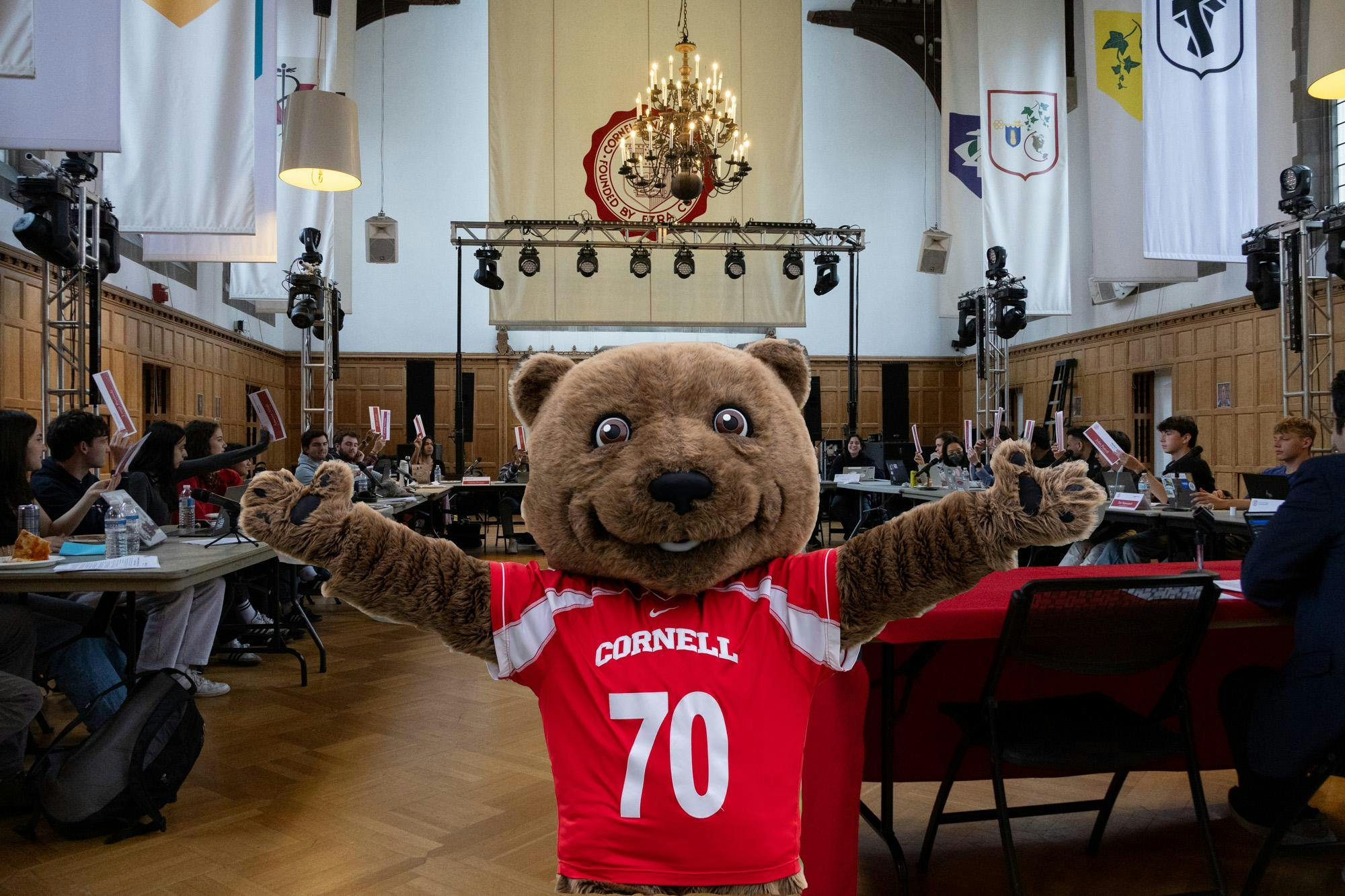
FOUR-YARD PLAY | The Student Assembly announced Sunday that beloved mascot Touchdown has won the position of president. (Rielka Cngman / Sun Contributor)
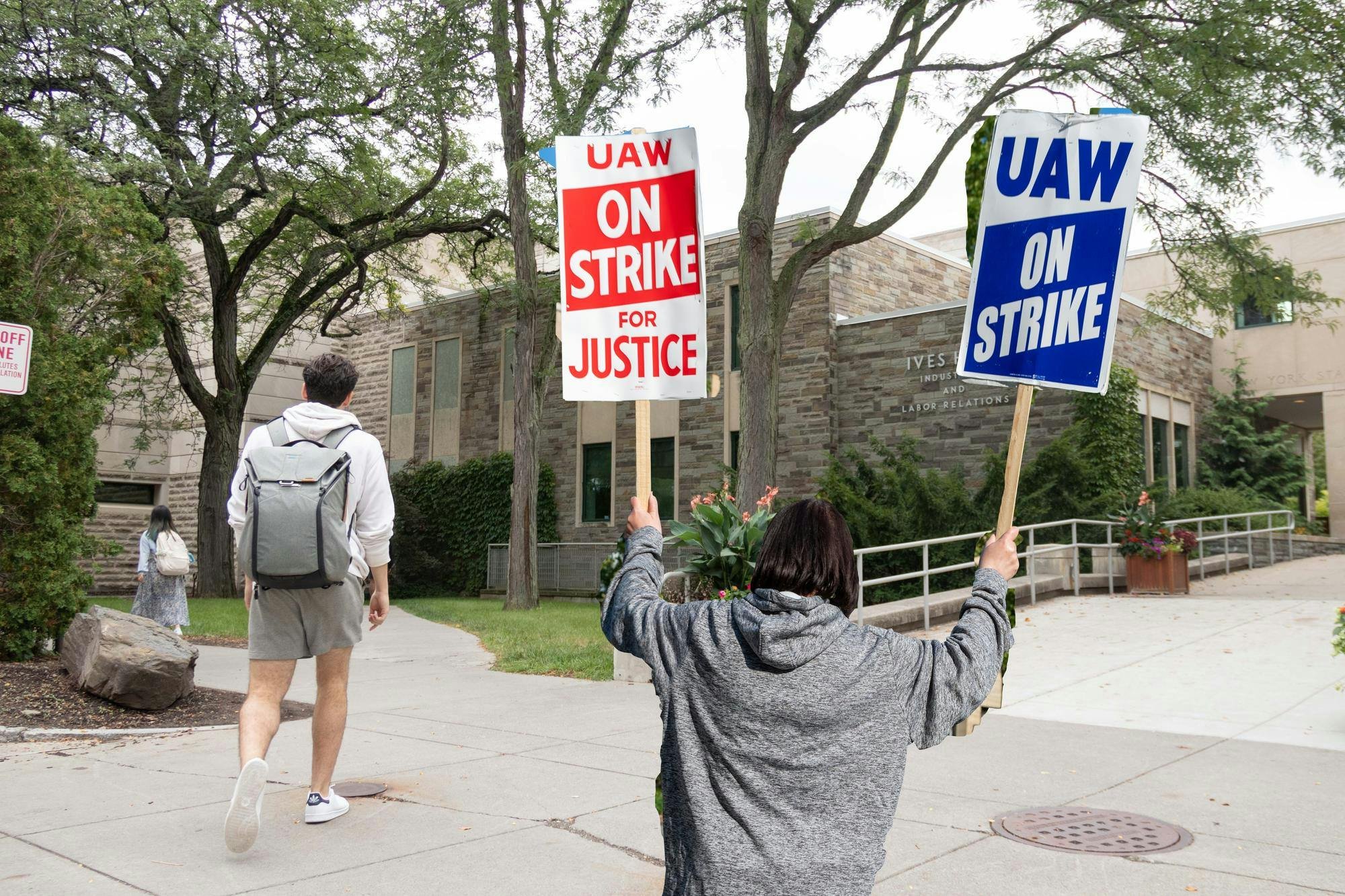
ILR IRL | For the first time in Cornell's history, ILR professors have voted to join the UAW and are going on strike, effective immediately. (Temawth Ckkziyorn / Sun Contributor)
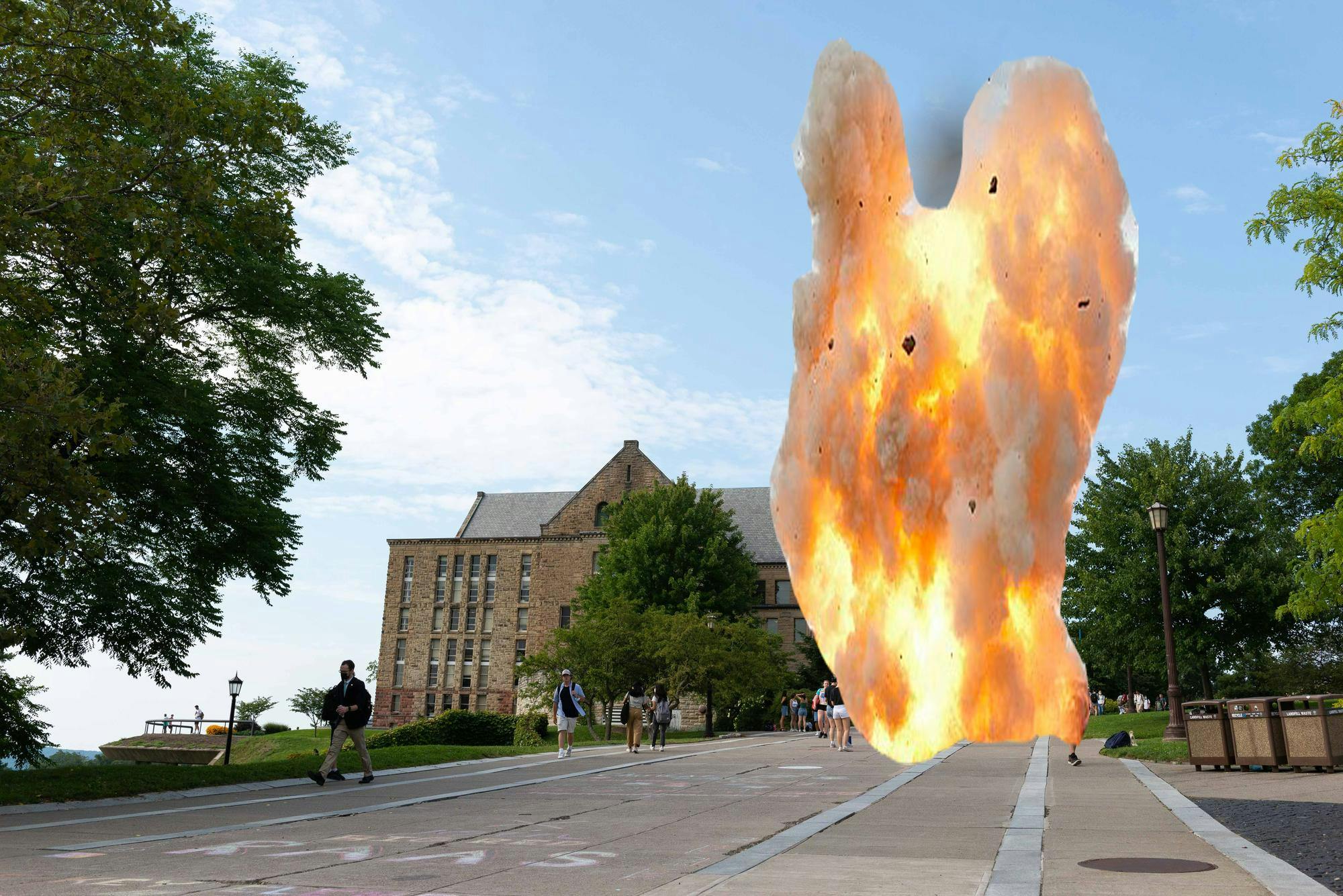
TICK, TOCK, BOOM! | Administration decided to demolish McGraw Tower yesterday, claiming that the years of construction on the landmark "were taking too long." (Mnig Medesr / Sun Contributor)

GETTING THE BAND BACK TOGETHER | After complaints about this year's headliners, Slope Day Programming Board has decided to change the 2025 lineup to a COIN reunion concert. (Lujia Ngale / Sun Contributor)
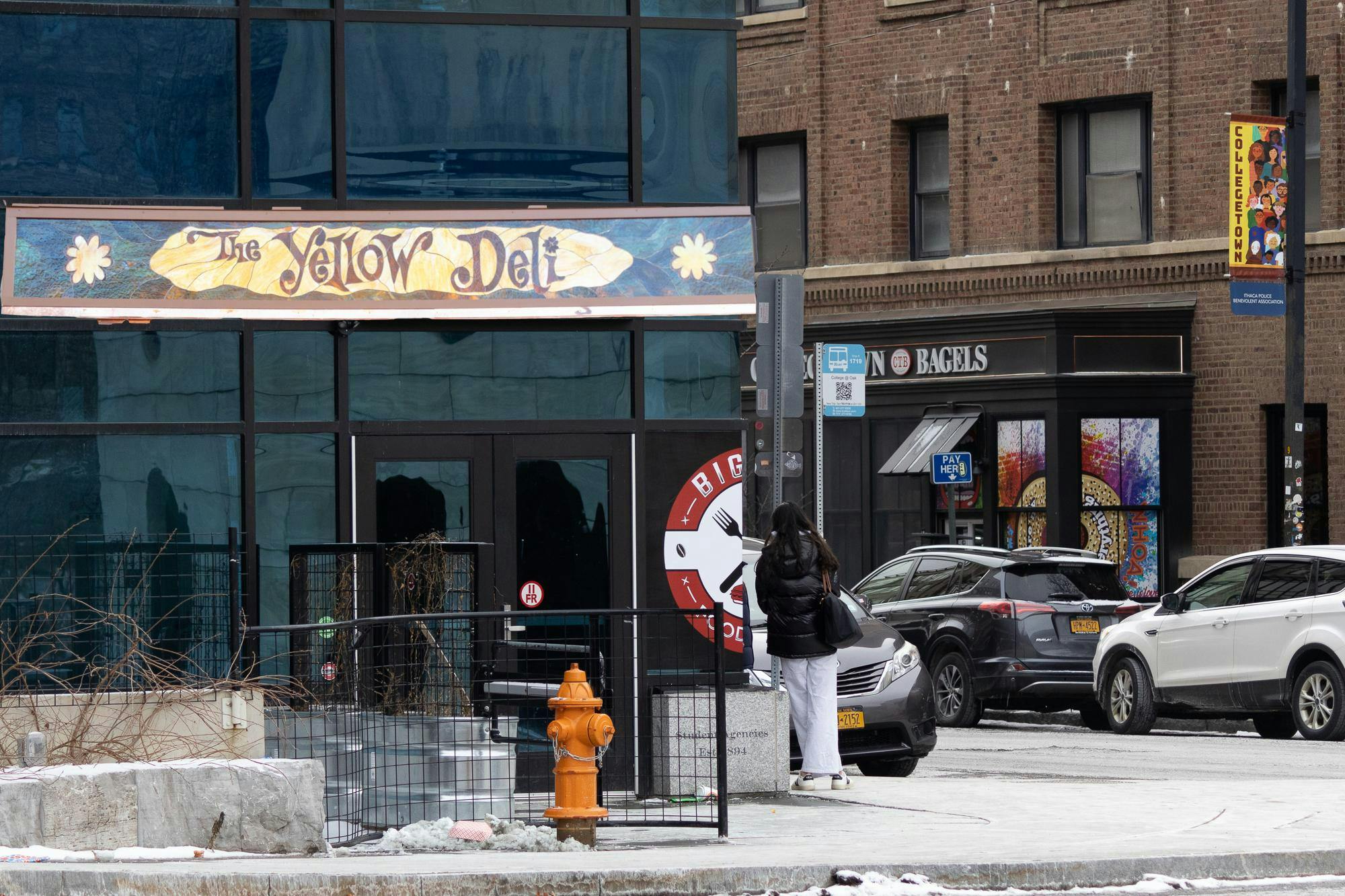
BIG YELLOW FOOD COURT | After a disappointing launch, Big Red Food Court is closing, and a new Yellow Deli will open in its place in Fall 2025. (Linilae Ukbre / Sun Contributor)
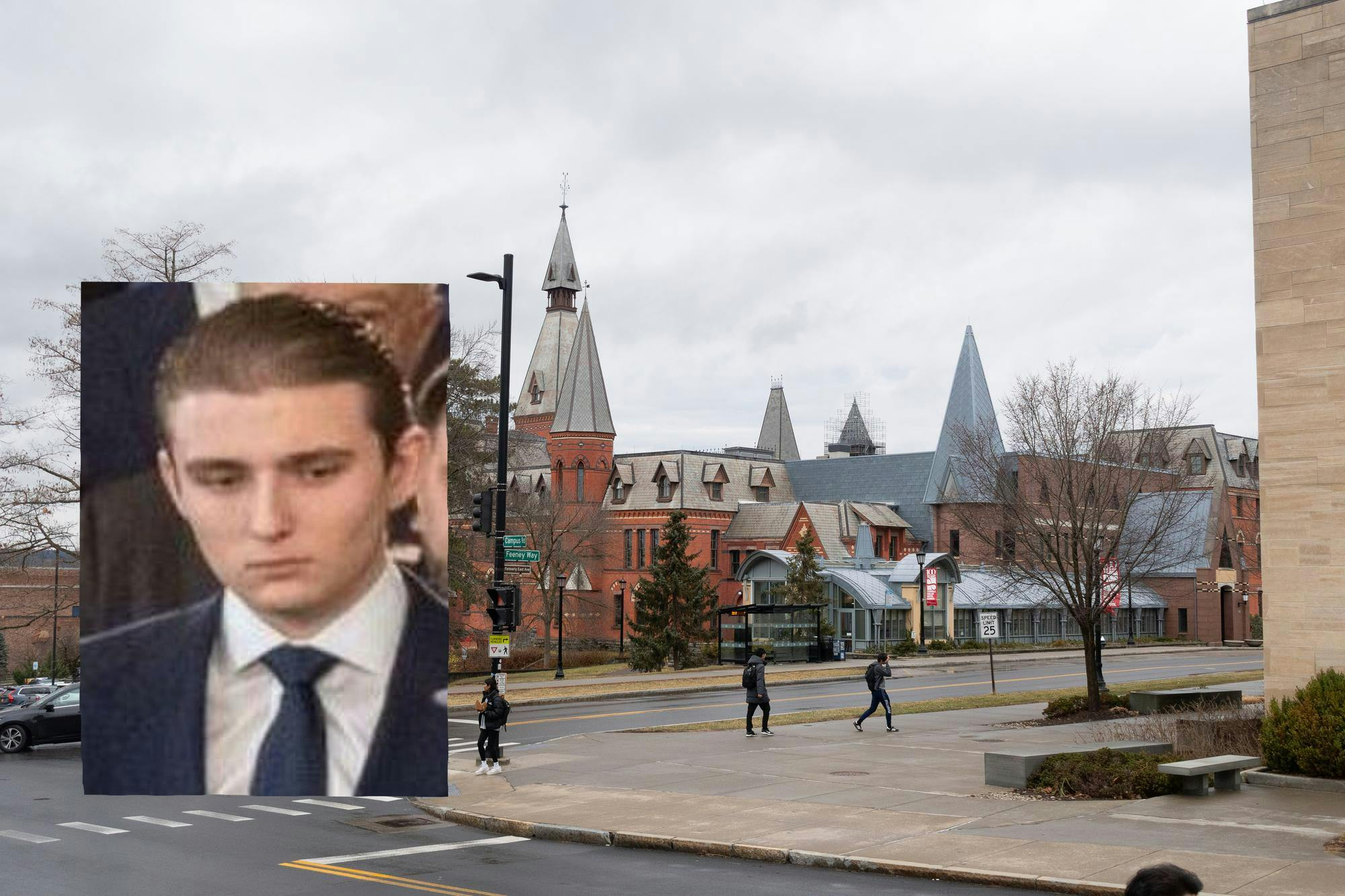
IVY FAMILY | After his freshman year at NYU, Barron Trump is bringing his sootcase to the Dyson school, hoping to become the first in his family to graduate from an Ivy League university other than Penn. (Hnaahn Beorgrsne / Sun Contributor)
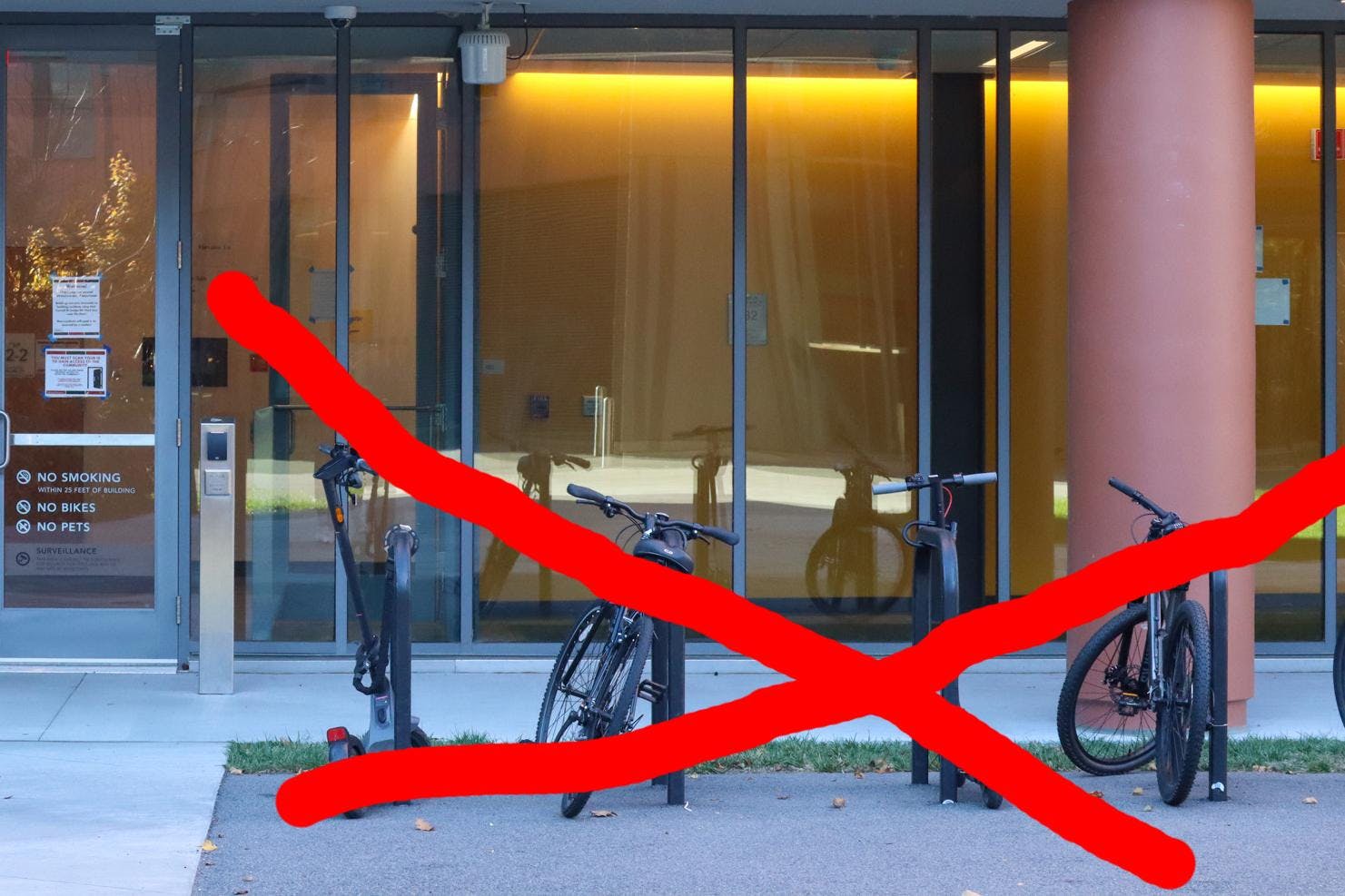
SLOWER COMMUTES | Sad news for athletes: as a result of several near-collisions with electric scooters and pedestrians, administrators have decided to ban them from Cornell's campus. (Cenmaro Ploklca / Sun Contributor)
4/20 | LETTER TO THE EDITOR | A STEM Major's Take on the Humanities 17 Apr 7:35 AM (yesterday, 7:35 am)
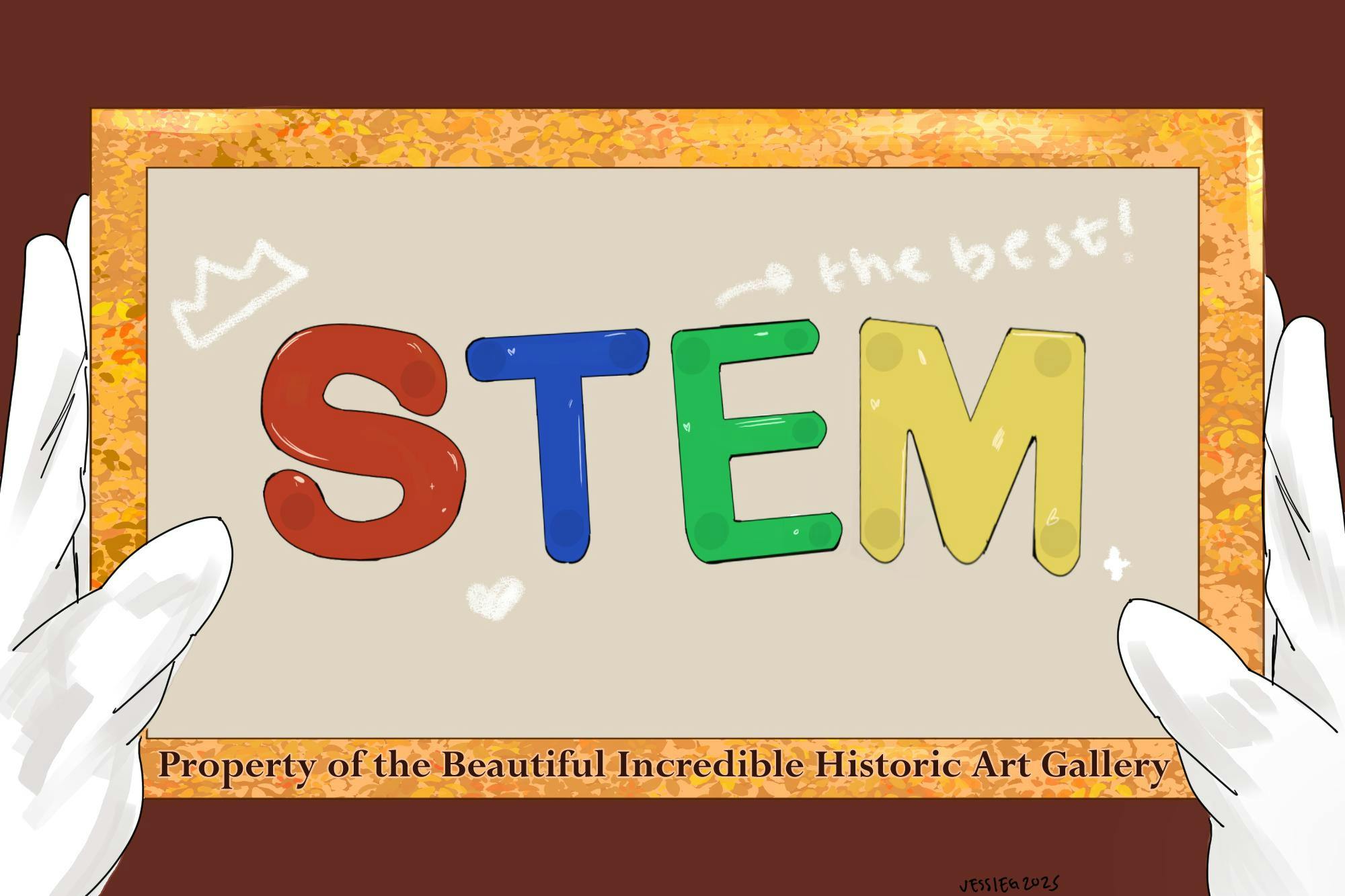
There is a reason that, when moving from grade school to college, STEAM loses the arts aspect and becomes STEM. The arts are superfluous and irrelevant, only used to get kids interested in the much more valuable science, technology, engineering and math required to be successful in life. After all, math is the universal language, and I'm a fluent speaker.
It is impossible to get through a day without using math, the prime subject at the top of the objective hierarchy of importance. The Pythagorean Theorem allows me to optimize my route to class, cutting across the Arts Quad diagonally to follow the shortest possible path. I ensure that I've calculated the tax on my Bus Stop Bagels order before Econ 1110 every day, so that I'm never caught off guard by the total. (I know, microeconomics is getting dangerously close to social studies territory. I'm only in it for the graphing, trust me.) I keep my spine at the precise angle necessary to reduce strain during my three-hour chemistry labs. On my walk to the infinitely homey and welcoming PSB, I scoff at the humanities majors in their fashionable outfits, sipping coffee in Zeus. They'll never have jobs. I don't have time for a sweater, scarf and acceptably-oversized leather jacket. I have vector sums to compute and internships to acquire.
My roommate once tried to show me a painting she had made of the sunset. I refused to taint my vision with such a trivial token of inferiority. If I wanted to look at the sky, I would simply open the blinds. Besides, paintings make me feel things. Why would I want that? I much prefer the sterility of a mathematical equation to the messiness of paint on canvas. Avogadro would never let me down; his number is always the same. There's no correct answer to those horrendous questions posed in humanities classes. I'd prefer never to think that deeply, actually. Why were the curtains blue? I don't know! Nobody knows! None of us will ever know! But I know the airspeed velocity of an unladen swallow, and that's what really counts.
The arts are barely even part of the world as a whole. I would consider myself a happy person. And I have never, of my own free will, visited a museum, art gallery or library. Television shows and movies are (I don't know if you know this) entirely made up. I deleted the default Apple Music app from my phone when I purchased it because I'm strong enough to listen to my own thoughts instead of an amalgam of lyrics and instruments. I abhor musicals. Why would I ever pay to see people sing and dance on a stage when I already see that every night in my melatonin-induced, post-lab fever dreams? I also don't read books. My lab-goggle-dented eyes much prefer numbers to words, and I'll only accept the latter if they come in the form of a lab report. If I can be happy without these so-called "important cultural centers," then what purpose do they even serve? You say that art is supposed to disturb the comfortable, but why would anybody ever want to be disturbed? That sounds exceedingly unpleasant to me. Tape no more bananas to walls, oh artists of the world! Come into the light, and we eminent scientists and mathematicians can teach you to analyze the molecular composition of the banana. Doesn't that sound far more entertaining?
So powerful is my hatred for the arts that I, in fact, have been moved to compose a sonnet on the subject. It reads as follows:
A pittance in the scheme of things, humanities are thus,
The jobless, sad and pitiful dead end.
To capable STEM majors our society will entrust
Their hopes and whims and know they will transcend.
A vector sum brings joy that knows no bound
Where magnitude and direction are one.
In matrices and theorems, we dance around
The knowledge of the moon and sun.
Only through calculations can life be real,
And sterile, predictable, making sense.
The arts confuse, beguile and steal
Time from STEM sans recompense.
Knowledge comes from calculation,
In the arts, naught is to be found but vexation.
Before you continue on with your day, infinitely more knowledgeable about the supremacy of STEM, make sure to connect with me on LinkedIn. If I can get to over 500 connections, maybe my professor will finally let me join in on the research in her lab. I already have the post drafted. "I am utterly thrilled, completely honored and unfailingly proud to very humbly and gracefully spread the good news that I will be joining … "
Al Gorithm is a proud member of the College of Engineering and a mediocre staff writer for The Sun (but only the Science section) (except this guest piece for Opinion) (but it will never happen again).
Editor's Note: 4/20 content is a part of The Sun's joke issue and contains exaggerated and factually inaccurate information.
The Death of Supers: Can Comic Book Movies be Revived? 17 Apr 7:00 AM (yesterday, 7:00 am)

In 2019, a small town in Kentucky experienced an unusual event: a line snaking outside of the local (slightly run-down) movie theater, full of chattering movie-goers. All were eager to enjoy the Marvel universe's latest feature, Avengers: Endgame. Though I was in middle school, I can still remember standing in that line until the box office opened, streaming in to snatch a few coveted tickets, grabbing popcorn and then sitting down in the dark before a large screen that would soon show one of the most successful films of all time. Avengers: Endgame would earn over two billion dollars globally, and the epic finale still holds the title of highest-earning superhero movie of all time. This was the golden age of comic book movies. Six years later, Marvel and the superhero movie industry are faced with a whole new story - one that might not have a happy ending.
It can be argued that the superhero movie industry was born when Iron Man was released in theaters in 2008. The movie brought audiences worldwide a love for heroes, and, most especially, a love for playboy billionaire Tony Stark. This character would go on to lead a group of superheroes called the Avengers in countless battles for the safety of Earth and the universe. Yet, what was truly created in 2008 was not a character; it was a franchise. An article in The Week points to a specific quote said by Nick Fury in Iron Man that led to a worldwide phenomenon: "You think you're the only superhero in the world? Mr. Stark, you've become part of a bigger universe." This seemingly simple statement opened the doors for a multiverse of heroes that would rule box offices for years. Yet, just as the comic book movie machine started up with Iron Man, when Avengers: Endgame killed off Tony Stark, the industry died with him.
The last five years have been some of the worst for superheroes on screen. From the much-ridiculed Morbius to the horrific flop of Madame Web to whatever Eternals was supposed to be, the new generation of powerful planetary guardians have not delivered anywhere close to the success of Iron Man. Marvel amped up releases for Phases Four and Five, cranking out low quality movies by the dozens. Phases, in Marvel, are milestones of stories or character introductions that are used to timestamp their movies. Phase One began with Iron Man and included the formation of the Avengers. Though bright spots have arisen - from Loki to Deadpool and Wolverine - these shows and movies of current Phases have been about bringing back old characters audiences are known to love. DC has not been exempt from this downward trend, with its own disasters popping up in The Flash and Joker: Folie á Deux. With no solid new content and the occasional success with former favorites, Marvel and DC appear to be fizzling out.
Strangely, however, comic book sales do not seem to be having the same difficulties as movies. After facing the disastrous fiscal period of Covid, comic shops have recently reported much better years. Superhero rebirth series have seen success, as have new creations. Why, then, are superhero comics booming while the movies flounder? Though there could be many explanations, ranging from the individualized sense of building a comic book collection to the brighter colors and daring art of physical books, one obvious reason would simply be that the movies veer away from their original source content, while comics are the source. When moviegoers begin to be more and more invested in the characters, they naturally turn to comic books to discover their true stories. Costumes, events and entire character backstories can be different when comic books are adapted for the big screen. Often, story arcs that can take many issues to unfold are simplified or even cut out from movie translations. Thus, when times get bad, superhero fans seek out comics instead of potentially horrific movies.
Of course, for Marvel and DC, the future is not all doom and gloom. Hopefully, after learning what audiences enjoy and what they simply don't show up for, directors and screenwriters can now listen to fans to produce quality movies. Additionally, following the ideology of bringing back what is known to be a big box office pull, Marvel announced the return of Robert Downey Jr. as Doctor Doom. Marvel is also attempting to build loyalty to fresh characters with the release of Thunderbolts in May. However, most notable of all is the excitement being built around DC's Superman. The movie is directed by James Gunn, who built the wildly successful Guardians of the Galaxy trilogy. Set to release this summer, the movie's trailers have sparked interest because of the presence of classic comic book staples like the dog Krypto and Lex Luthor. If Thunderbolts and Superman can prove to be hits, they could revive a seemingly dead industry; however, if the movies cannot live up to their potential, we could be witnessing the final cries of a once booming business.
Jane Locke is a freshman in the College of Arts and Sciences. She can be reached at jlocke@cornellsun.com.
Men's Lightweight Rowing Completes Upset Against No. 2 Princeton at the Platt Cup Race 17 Apr 6:47 AM (yesterday, 6:47 am)

For the sixth consecutive time, No. 3 men's lightweight rowing took home the Harriot Trophy at the Platt Cup race, defeating Princeton University on Saturday, April 12. The win marked the longest streak in program history.
The 1V8+ secured the win for Red, logging a time of 5:51.8 - nine seconds quicker than the Tiger's 6:00.8 time. The 2V8+ slightly outpaced the Tigers by a margin of under two seconds, and the 3V8+ had similar success, outpacing by under four seconds.
"This is just what we needed to prove to the league and ourselves that we are a legitimate championship contender this year," said senior captain Peter Albrecht. "Our ballsy racing mindset combined with our determination to make a statement to the rest of the league ended up being our edge."
Cornell entered the Platt race off of a loss to both Harvard University and the University of Pennsylvania at the Matthew Cup on April 5. The 1V8+ raced 5:33.6, narrowly losing the second-place finish to the UPenn boat by under a second. Harvard's boat finished first with a 5:31.6 time. Senior Emmett Patterson said that although the close loss was demoralizing for his team, he is confident they can recover confidence for the rest of the season.
"We rowed a race with good effort; however, we had sub-par execution and technique," Patterson said. "When it comes down to margins, it's often small things like catch timing or drive sequencing that add up. While it was definitely a frustrating result, we knew we had a lot more to improve at every boat level."
The Red will host Dartmouth College at the Baggley Bowl on Saturday, April 26. As long as the team makes small technical adjustments, Patterson said he has high expectations for the rest of the season.
"Looking ahead to Dartmouth, we must continue to improve our technique on the water, fitness and overall mindset when it comes to racing," Patterson said. "Our goal when we started this season in August was to win a national championship, and that remains unchanged."
Coverage of the Baggley Bowl will be available on ESPN+.
SEX ON THURSDAY | I Am an Incel 17 Apr 5:00 AM (yesterday, 5:00 am)

By Stevie Dicks
Hey freaks, it's me again.
Roughly two and a half years ago, I did a very daunting thing - I came out as gay in a small upstate New York town. Now years later, I am coming out again: I am an incel.
For those that don't know, an incel is a person who is "involuntarily celibate." I have not had sex since July. It's been so long that I can no longer see, my legs don't work and I can hear colors. But it's not like I haven't gotten any play.
I can explain! This all goes back to my fling from last summer. I was seeing this man in med school; he was beautiful and an absolute monster in the sheets. Just looking at him would make me hard… but he would thrust his willy into me with an absurd amount of force and at lightning speed back and forth. It was remarkably unenjoyable because it hurt that freaking bad.
Looking back, I have no clue why I never told him to go slower, because he definitely would have! I think I just didn't want to risk him not having sex with me again because our sex styles didn't align. God, he was so weird, but he was so hot. And he just texted me the other week too. Like please stop and let our history die! I am NEVER going back to South New Jersey again. I can't do it.
Side note: We shagged in front of a mirror. I did NOT like that. Maybe I'm not as freaky as I thought…
Until recently, I was scared to have sex again, and it's been almost a whole year! The thought of having a wiener up my butt again would send me into anaphylactic shock. It hurt THAT BAD. I've gotten with some people this past year since him, and I just would not have sex with them because I was so nervous.
But also, every time I see a man, I'm always the one that asks if they want to have sex. Like hello, I am a twink, you are a big strong man - can't you make the first move? My sweet autistic charm can only go so far. And I know you want to have sex with me because you're in my room right now, and your mouth is on my balls. Can't you just initiate it instead of me? All you stupid, stupid princess diva men are going to hell.
Back to my explanation. Ever since I had my first sort of serious thing with a man last semester, my standards have risen. I've learned a lot about what I want and how a man should treat me. Instead of having sex with anyone who asks, they need to be nice to me (standards have increased a lot!). In all seriousness, I have started being able to read red flags rather early on. After that evil, disgusting man hurt my feelings so badly, I just don't find that it's worth it to entertain shitty men. Also, his new man is so chopped, guys. He fumbled me so hard.
Crappy men do NOT deserve my time, energy, etc. And they especially do not deserve to have sex with me. Unfortunately, not many men are even giving me attention, so this could also just be me coping with my lack of desirability. I need a strong, masculine man, and there are just none of them on this campus. And a lot of the ones that are are too beautiful for me. Obviously, I am attractive and my body is tea, but I understand my limits.
Another reason for my lack of sex is an incident last year in which I had sex with a man I actually liked for the first time, and I was romantically infatuated with him. The whole shebang. It was just so, so much better than bonking someone I didn't know. I don't understand why some people prefer hooking up with random people over a recurring person. Y'all are weird.
Guys… I just want to make sweet, passionate love with a huzz so freaking bad. I need a man who is genuine, smart and funny. He needs to make me laugh while inside of me and also tell me how beautiful I am. Also needs to have a big penis, but not too big. Guys, I gotta fit it up my bum! Is all that too much to ask for…
But I see an end to the storm and the sun's shine. I will get my freak on soon. I just know it. Especially after I took some super sexy thirst traps in Mexico during spring break and added them to my Hinge profile. Since then, I have gotten more matches with these super fine men than I ever have before. I guess you guys don't care about my wonderful, dazzling personality, just my super tea body.
If you're a cute, hot, sexy, masculine gay man reading this and wanna help me out, email me at sdicks@cornellsun.com.
The Cornell Daily Sun is interested in publishing a broad and diverse set of content from the Cornell and greater Ithaca community. We want to hear what you have to say about this topic or any of our pieces. If you are interested in entering a submission, please email style@cornellsun.com.
The Return of Emma Chamberlain, Again 17 Apr 5:00 AM (yesterday, 5:00 am)

I have a parasocial relationship with Emma Chamberlain, but not in the way you might expect. I would hardly describe myself as a devoted fan, much less a diehard lover of Chamberlain's content, but I've always felt inextricably connected to her from afar. Maybe she's the cooler older sister I never had, or maybe I'm still clinging to the seventh-grade version of myself that first discovered her channel in 2019. Regardless, I've never been one to grow overly attached to celebrities or online personas. My years-old appreciation for Chamberlain's content was rekindled about a month ago when her face popped up in my YouTube recommendations. I was pleasantly surprised because, as faithful viewers know, she's become more of a sporadic poster over the years. That's one of the incredible things about her, though. She's never trying to please others or come off as anything more or less than herself. When she needs to take a break, she takes a break. When she wants to delete her entire TikTok feed, she deletes it. When she feels like dropping an hour-long vlog on a casual Tuesday afternoon, she does exactly that.
In this age of instant gratification and eight-second attention spans, there's something oddly nice, almost satisfying, about watching an Emma vlog after months or weeks of radio silence. Even during posting sprees with content pumped out in quick succession, you never know which video will be your last for the indefinite future. So, you make the most of your time and cling to the comforting lull of background music and daily routines caught on film, settling into the warm, slightly awkward embrace that is an Emma Chamberlain YouTube video.
As for her most recent content, Chamberlain seems more herself than ever. Sporting new hair and a recently cleaned-out closet, the 23-year-old's current editing style is my all-time favorite of her many content-creating eras. Dating back to the chaotic, rapid-fire clips of her first videos on YouTube, it's safe to say that she will always be a pioneer of "quirky" and "relatable" Gen Z content. These days, Chamberlain's taken the style of her channel in a philosophical direction. Her latest posts are more somber and thoughtful in their composition, making an art form out of everyday life. Her most recent hobbies - sewing, painting, baking and reading - sound generic on paper, but injections of her gritty humor and eye for cinematic design make even the most mundane of crafts a pleasure to watch. Whether we're cooking tofu and vegetables in her green kitchen, or intently watching L.A. traffic at random times of the day, there's a sense of comfort and nostalgia that radiates from Chamberlain's new content. With little regard for the hustle and bustle of the outside world, it's incredibly endearing to watch her cycle through daily routines, finding joy in trying new things.
From daily high school vlogs, to living alone in L.A., to filming with the Sister Squad, there will always be something inexplicably timeless about Chamberlain's content. A quick scroll through any one of her comment sections is typically filled with users trying to place their finger on the secret ingredient in her videos that keeps them coming back for more. Under one of Chamberlain's most recent posts, a user commented, "how can a person be this effortlessly interesting?" For as long as I've watched her content, I've wondered the same. After all, there are very few people in the world with enough power and influence to singlehandedly raise an entire generation of VSCO girls, myself included. One thing I do know, however, is that citing Chamberlain's relatability as her sole claim to fame is a massive oversight, one that fails to recognize the true essence of what sets her apart from other creators. No matter how much her lifestyle, editing or fashion changes, she's unusually good at commercializing her individuality. She's never shied away from online hate or speculation. She keeps her relationships private and has spent years building a loyal fanbase of viewers who return to her channel to watch her, and her alone. Chamberlain isn't a one-trick pony who needs to build success based on the people she surrounds herself with. She keeps the spotlight keenly trained on herself, creating a uniquely intimate relationship with viewers that they can't find anywhere else. And I haven't even mentioned that her eclectic style is always years ahead of its time.
At any age, at any point in my life, visiting an old Emma video is like reliving the version of myself that I was when I first saw it. Growing alongside her is bittersweet, but no matter how many times she leaves and returns to YouTube, my parasocial relationship with Emma Chamberlain is one that I'll always appreciate.
Charlotte Feehan is a freshman in the College of Arts and Sciences. She can be reached at cgf47@cornell.edu.
Kotlikoff Acknowledges Assembly Resolution for Immigrant Student Protections, Rejects Several Suggestions 16 Apr 9:23 PM (yesterday, 9:23 pm)
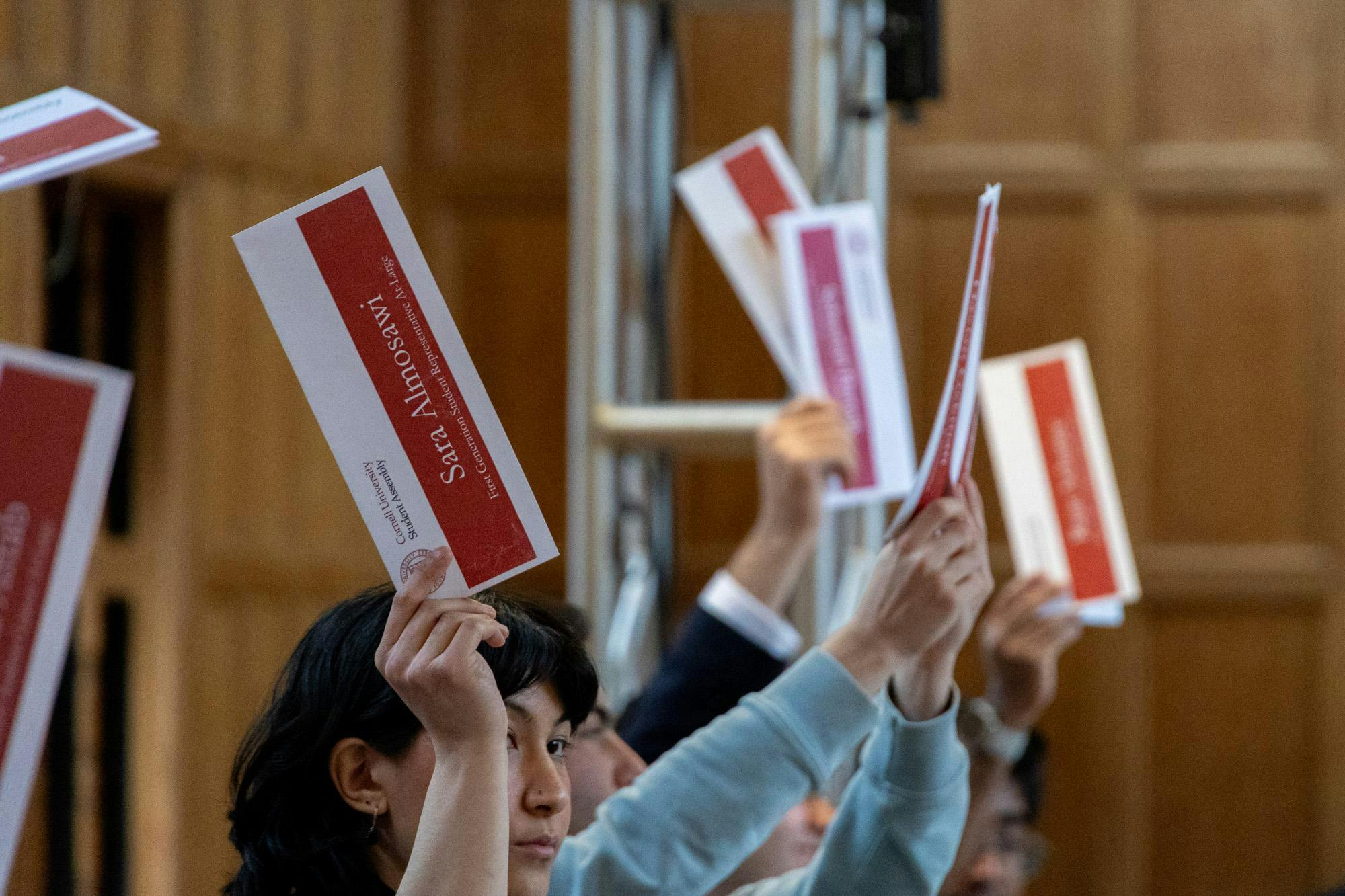
President Michael Kotlikoff acknowledged Student Assembly Resolution 37: "Protecting Immigrant Students" on Monday, while rejecting several of the Assembly's suggestions and pointing to existing resources for international students.
Resolution 37, which sought to increase protections for immigrant students, passed in the Assembly on March 6 in a room crowded with more than 100 community members gathered to show support for the resolution.
In his acknowledgement of the resolution, Kotlikoff rejected several demands, including implementing mandatory "Know Your Rights" training for all students, faculty and staff, designating certain campus buildings, namely religious spaces, as "exempt" from ICE activity and providing legal assistance to international students facing visa revocations.
The resolution and its acknowledgment from Kotlikoff come amid rising concerns over the safety of international students in the wake of executive orders from the Trump administration. These orders have been the basis for numerous ICE arrests of immigrant students and revocations of student visas across college campuses, including graduate student Momodou Taal, who was told to surrender himself to ICE custody in the middle of a legal battle with the administration.
"Cornell is committed to supporting our immigrant and international community, and to helping mitigate the impact of the ongoing changes to the federal landscape," Kotlikoff wrote.
In his response, Kotlikoff said that "Know Your Rights" training is, and will continue to be made available, but, "as a general rule, Cornell avoids adding mandatory training for all students, staff, and faculty for whom the information may not be required."
Further, Kotlikoff explained that the University does not represent individuals in personal legal matters, but directed students to the DACA and undocumented student support office and several immigration clinics run by the Law School.
Kotlikoff also referenced several existing University-run websites, including the Executive Order website, the immigration advice and resources website and international services page.
Adam Vinson '25, executive vice president of the Assembly and co-sponsor of the resolution, acknowledged the administration's existing protections for students and expressed hope that it would be enough in a statement sent to The Sun.
"Kotlikoff's response detailed the many actions that the University is taking to protect international, immigrant, and DACA students," Vinson wrote. "Those actions are good. However, time will tell whether that alone will be enough."
The resolution also urged the administration to avoid issuing suspensions to international students that could threaten their visa status. Kotlikoff responded that a student's immigration status was "not a relevant factor" when considering sanctions and that the University will continue to abide by the Student Code of Conduct.
"We proposed additional protections and were told that it wasn't necessary. I hope we are wrong," Vinson wrote.
How to Maximize Your Cornell Tuition 16 Apr 6:42 PM (yesterday, 6:42 pm)
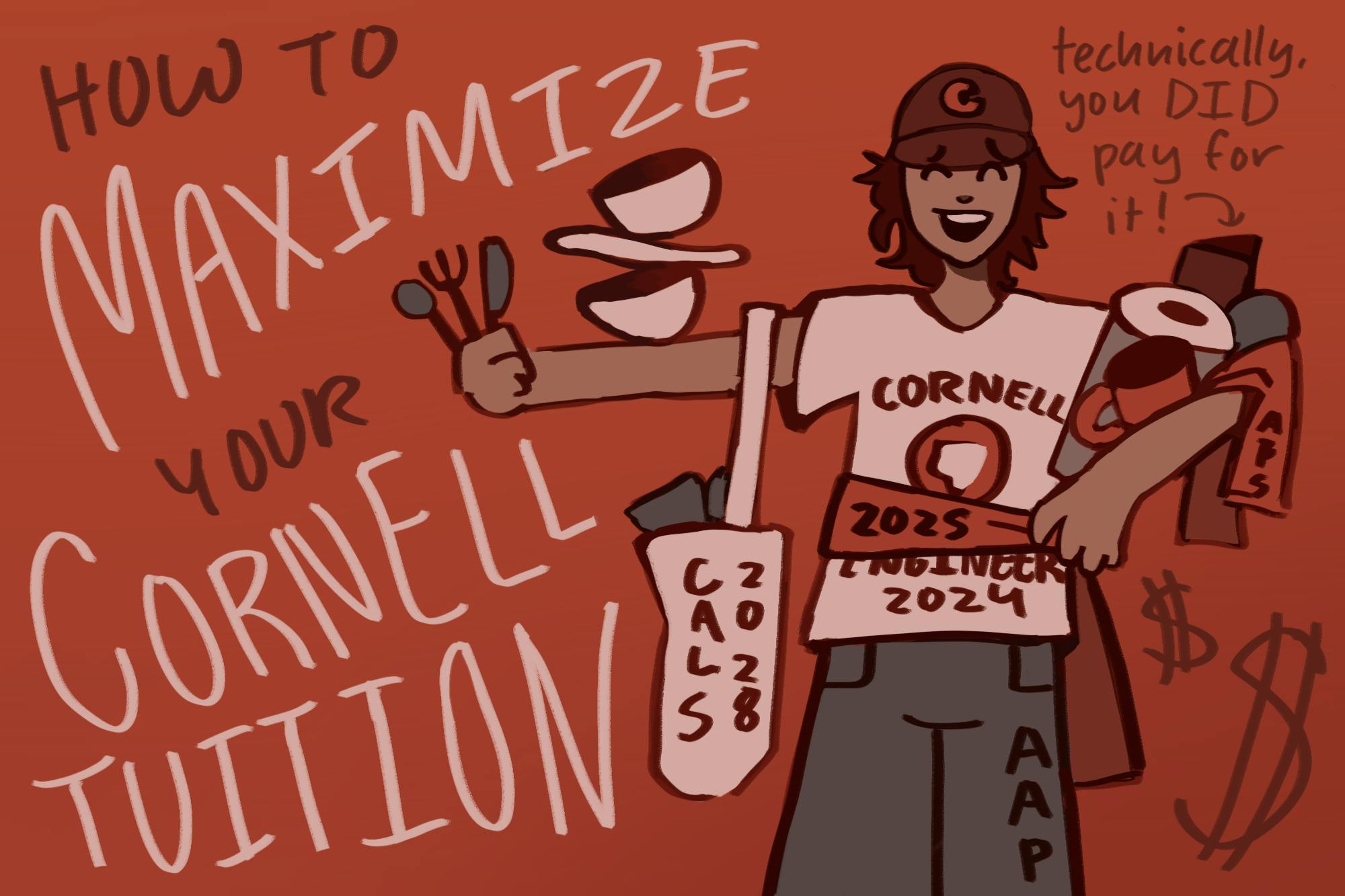
You're getting conned. All of you. And no one will tell you that hard truth: You pay too much and use too little! Most of you probably don't care, and that's okay. Well, actually, no, it's not. You should be embarrassed that you are not milking all that your tuition offers (and doesn't). To solve this little (expensive) issue, I'll share what I've seen (not personally done…) are the most effective ways to maximize your tuition.
- Find a Cornell Alum that happens to also be a Sugar Daddy!
Ok, not sure if this has ever been done, but I think it's an untapped market and resource. Everyone here blabs on and on about how you're paying for the "connections" this school offers, so why not use them? If you're repulsed by this idea, clearly you haven't been committed enough to networking, and what a shame that is. I hope you consider this one, but just a warning! Check that they do not have legacy children… who could be at school… cause that would be weird.
For the straight men! Don't you worry, I'm sure there are some interested alumnae who would take you under their wing… of their private jet! Best of luck!
- Don't be a Scaredy Cat: Dining Hall Hacks
If you've never snuck into the back of Morrison Dining because you have limited swipes or no meal plan, then I'm ashamed of you. That's embarrassing! If you also haven't taken plates, utensils, cups, etc. from a dining hall you should probably start. If you have a moral issue with this one, you can kiss my ass. I have free forks and you don't.
Here are some creative dining hall swipes: bowls, the big "Ken's Essentials" salad dressing bottles, plastic cups, salt and pepper packets. And my last suggestion, one I am uncomfortable with sharing as I have personally swiped: soy sauce bottles. I won't be giving further explanation.
- Every Event Offered: For Free Shit
You should genuinely go to every event offered by Class Councils, clubs, schools, etc. Why? Free food. Oh! Speaking of food, do not buy the ten-dollar Chick-fil-A sandwiches or two-dollar Krispy Kreme donuts or twenty-dollar Crumbl boxes. If you do, you're an idiot. No matter what student is begging you to buy it, no matter how much you miss fast food, no matter if it's cheaper than other food you'd buy instead. Don't do it. It's a statement.
Besides the best part, the food, they also occasionally have free Cornell-labeled dumb shit, such as but not limited to: notebooks, stress balls, pens, phone wallets, cups, cones - you get the gist. Go, and take all of the dumb shit. If you don't want it, do it for me (just kidding, please don't).
- Get a Job?
I know this is a foreign concept, but you can get a job? On campus? Isn't that crazy? How does that maximize your tuition, you might ask… you're going to have to make the tuition back somehow. Considering most of you are pursuing pre-graduate degrees, you should probably do this. But, what do I know!
- Get a Flu Shot, Pregnancy Test and STD Test All in One Day
You sluts might as well utilize your access to Cornell Health and all of the great things they can do for you, including free Plan B! Seriously, take everything you can including their Free Well-Being Resources. Even if you think they're useless, like… why not?
You all also should get STD tested because you are all insane, so just get it for free here! I don't know what you're doing or who you're doing it with, but I do know it's with someone, so you might as well get tested.
- Enroll in Hotelie Classes
Considering most of Cornell is dumb and didn't enroll in Hotel Administration - considering they're all going to make more money than everyone else - you might as well get a taste of the lifestyle by taking a class or two.
So, one day, when your Hotelie friend is putting up triple the amount of money as everyone else, you can say, "Hey, I took Introduction to Wines, I'm basically a Hotelie." And you'll be wrong every time, because Hotelies know how to maximize their tuition. I mean they need to, considering they're paying to play chef (sorry, not sorry).
No, no, I didn't mean it. What I do mean is they get all of the leftover food from Hotel events and that is worth it.
Other ideas that I have for you are fairly self explanatory, so I will list them below!
- Steal food from club events.
- Do an information session and pretend to be a prospective student. (They'll probably give you free stuff.)
- Eat at Okenshields… I know, it's a bad idea. But, it maximizes your meal swipes and saves you BRBs.
- Get up early? Nah, screw that. You can pay to sleep.
I hope you all take this advice seriously and steal from everything there is to offer, they'll never know.
Editor's Note: 4/20 content is a part of The Sun's joke issue and contains exaggerated and factually inaccurate information.
Paleontological Research Institution Grapples With Loss of $100,000 Grant Amid Trump Funding Cuts 16 Apr 6:28 PM (yesterday, 6:28 pm)
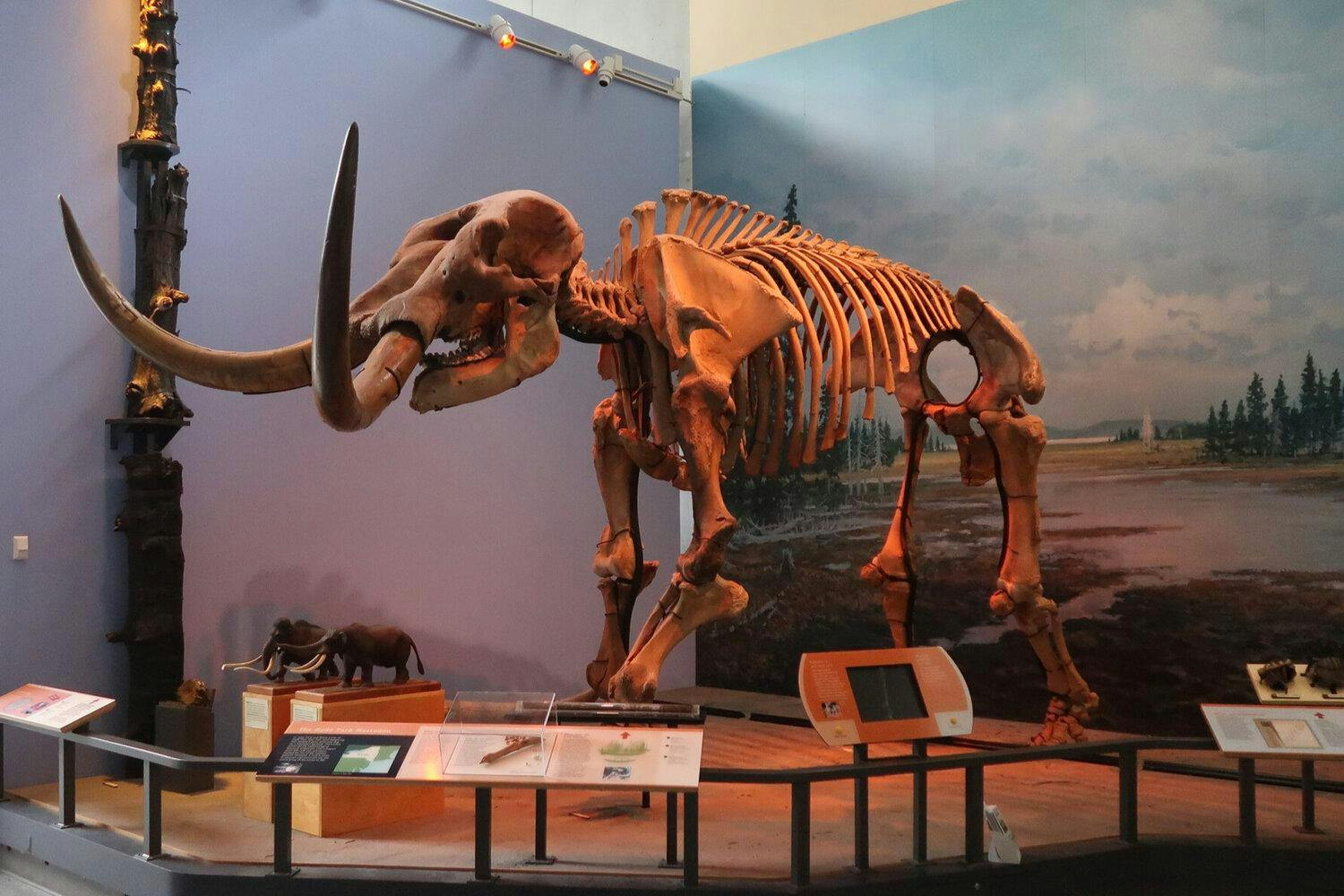
The Paleontological Research Institution received a formal letter terminating nearly $100,000 of federal funding on Wednesday following several funding cuts under the Trump administration. The PRI was awarded the grant last fall by the Institute of Museum and Library Services, which has recently been dismantled by the Trump administration.
The IMLS is an independent federal agency that supports U.S. museums and libraries through grants, policy development and research opportunities. As of March 31, IMLS staff were placed on administrative leave and the following day, several institutions across the country began receiving termination letters for different grant awards.
The PRI has received several grants from the IMLS in the past. The recently terminated grant appropriated two years of funding for a project called "Digitizing the Cenozoic Western Atlantic Coral Collections of the Paleontological Research Institution." The project involved the identification cataloging and computerization of approximately 10,000 coral specimens from the Caribbean and Florida.
The Museum of the Earth is a natural history museum that is part of the larger Paleontological Research Institution, a nonprofit organization that owns and operates the museum. Cornell has been formally partnered with the PRI since 2004. According to the PRI website, The Museum of the Earth has served as a resource for "Cornell undergraduate courses in biology, geology, anthropology, and art."
Prof. Warren Allmon, earth and atmospheric sciences, who is the director of the PRI, explained that their team had finished about one-third of their project and was supposed to have over a year and half of funding left to complete their work.
"It has been halted - Our collection is so vast, and we totally depend on grant money to do major cataloging," Allmon said. "This grant was paying for us to do that with one little slice of our collection. Now, if there's no more money, that project will simply stop."
Allmon said that there was a lack of clarity about the timeline for which termination letters were sent. Local institutions, including the Sciencenter, an interactive science museum, reportedly received two award termination letters last week, pushing them to halting two major initiatives.
Ali Jackson, director of programs and partnerships at the Sciencenter, told The Sun that they were grappling with the loss of around $400,000 in grant money.
Although the termination letters for the Sciencenter and PRI were sent several days apart, both had the same effective termination date of April 8.
"We got our letter in the middle of the night, [which is] later than the Sciencenter, but interestingly our termination dates are the same. They got their letter three days ago, we got ours last night, [and] our appeal dates are the same," Allmon said.
The loss of the IMLS grant money also hurts PRI employees. Prof. Robert Ross, earth and atmospheric sciences, who is the associate director for outreach at the PRI, explained that grant money is often also used to pay salaries.
"When grants are lost, it is often also a loss of jobs, because the money that pays the people that do that work is often the only [funding] … available for those employees," Ross said.
According to Allmon, the PRI formally dismissed an employee working on their research project on Wednesday morning. "We're different from the Sciencenter … they were not employing any particular person with their grants," Allmon said. "That was not true for us, we had a person who was working sixteen hours a week just paid for by the grant."
The PRI directors are hesitant to solicit external donations for their project, as they don't want to "cannibalize donations" needed just to keep the PRI afloat, Allmon said.
Their ongoing financial crisis contributed to their hesitancy to solicit donations from the public. "People say, 'well, you know, find the money elsewhere.' We need the money from elsewhere just to stay open in our current crisis," Allmon said.
Allmon said that the IMLS grant was a "rare piece of good news for us last fall because we were able to advance on this curation project in the middle of all these other problems we were having."
An overwhelming amount of uncertainty remains surrounding the federal funding cuts. Leaders of the afflicted institutions have also expressed their frustrations with the lack of transparency about where the already appropriated funds would be reallocated. Connie Bodner, former IMLS director of grants policy and management, explained that the current situation is unprecedented.
"In the 13 years I've worked there, that [grant termination] was never, ever the case. Say you apply for a three year grant, the entirety of that grant is appropriated in the year that you're notified that you won that award. So, the money's already been appropriated by Congress," Bodner said.
The future of the IMLS and the programs it funds remains to be seen, including programs under the PRI.
"IMLS is a tiny agency, but it has incredible reach across the country, and it's in so many congressional districts," Allmon said. "One might hope that because it's in a lot of congressional districts, that all those librarians and museum-goers will be writing to their representatives."
DATING ON WEDNESDAY | PDA: Please Detach Already 16 Apr 6:08 PM (yesterday, 6:08 pm)

Have you missed me? I missed you! What I missed the most - because I'm always going to be honest in this column - was telling you all how to not be super freaks, and attempting to, (desperately) single handedly, fix the dating scene on this campus.
On the topic of super freaks, some of you need to get a grip, and not on each other. This is my plea and my threat: stop publicly displaying your affection. What I mean by this is that your PDA is too much, and if you don't think it is, you should reassess.
Don't get me wrong, there are certainly places, times and moments where PDA is okay, but there are some that are atrociously horrible. To be blunt, for a school with such smart individuals, you would think you'd know how to act a little normal in public… but apparently not. Let's discuss!
While I'm not a psychologist I can confidently deduce that some of you have attachment issues. My guess is that for some, this was your first ever relationship, and even if it wasn't, you might be socially awkward or unaware. You probably feel really lovey-dovey or really horny, and neither is an excuse for your behaviors. No matter how in love you are, no matter if you think no one is watching: you are a public nuisance. Take your love elsewhere. Now, I won't discredit your feelings toward your significant other, but what I will say is that there is always a way to not be in everyone's face. I sympathize with some hand-holding (which I am generally anti), but I do not understand what goes through people's heads when they cuddle, makeout or whatever else in public spaces.
This phenomenon ties directly into anxious attachment styles. People with this style tend to be excessively preoccupied with their relationships and fear abandonment. Public displays of affection can sometimes serve as a way to reassure themselves, constantly seeking validation from others or proving their bond to the world. When couples are glued together in public, it's not just a sign of love, it's a sign of insecurity. These individuals often feel the need to demonstrate their connection to counteract internal fears. However, that kind of dependence on constant public reassurance can be psychologically unhealthy, as it undermines the ability to feel secure without external validation. And let's face it, you go to Cornell, of course you need validation. Poor baby…
I can already hear some of you thinking, "It's not that serious, we are just happy and expressing our love." Okay, Shakespeare. Then express it somewhere else. Literally anywhere else. Do it behind a bush, in your dorm or - dare I say it - just wait until you're alone like a normal person. I promise you, your relationship will not spontaneously combust if you stop cuddling and sitting on top of each other in the library. Learn to act right.
A little about me: I don't do PDA. Obviously, if you didn't get that. I think it's uncivilized. You might call me cold or anti-romance, and maybe that's true. But, there are times where it is okay, and dare I say: it doesn't count. Unless you abuse it, then it counts. These places include frat basements, a movie theater (these two cannot be every single time you attend one) and your wedding. That's it.
So here's my advice - and honestly, it's a public service: Detach. Practice sitting in separate chairs. Try saying goodbye without licking each other's faces. Remember what it felt like to exist as your own person before you got into this mess: a relationship, or situationship or whatever you are. And if you physically cannot resist holding hands on the way to class, fine. But if I see a hand around the waist, I'm calling the authorities. Look, I'm not saying don't love each other. I'm saying we can learn to love each other quietly when in public. Like, "we share Spotify playlists and like to study together" quietly. Not "we're giving a free demonstration of how to be weird." Because when you are publicly displaying your affection - unless you are the hottest person ever, or it's an engagement - you are not cute, you are not hot and you are not normal.
Generally we are entering an era where people can do whatever crazy shit they want in public, and that, I don't support. But when you throw in couples, the situation is so much worse. Restaurants, amusement parks, elevators, parks: the list never ends. You might think you look like a happy couple, but studies do show that ultimately, the public views PDA couples as "unlikable and psychologically unhealthy."
Here's what research on public displays of affection tells us: people often feel uncomfortable or irritated when they witness PDA. It's not because they are jealous or unsympathetic to love, but because it disrupts social norms and personal boundaries. Studies show that excessive PDA can lead to a negative view of the couple, seeing them as attention-seeking or even emotionally immature. The most extreme reactions involve discomfort or irritation. This could explain why so many people cringe when a couple won't stop kissing or being physically intimate in public. So when you're engaging in PDA, remember, the world is watching - and not in the way you think.
Here is the most important point for you all to know: nobody wants to see it. Stop, you are not the only people in a space, and we are not a part of your relationship. You think no one is paying attention to you, but they are, because you look like a freak.
But hey, don't get me wrong. We'll all watch a hot celebrity make out or some movie stars go at it on screen, but that's because they're paid to do it, and we don't have to actually interact with them in real life (plus, they're hot, and you're probably not as hot as them… at all… sorry). It's a spectacle, not a behavior that needs to be normalized in a library or on the bus… or in other public spaces for that matter. So yeah, go ahead, keep your love life private and leave the displays of affection to the movies. Detach and learn to live without your partner, you'll be okay… and we'll all thank you for it.
Doctor Love can be reached at love@cornellsun.com.
Head Coach Mike Schafer '86 Announces Retirement, Plans to Make WWE Debut This Summer 16 Apr 4:52 PM (yesterday, 4:52 pm)
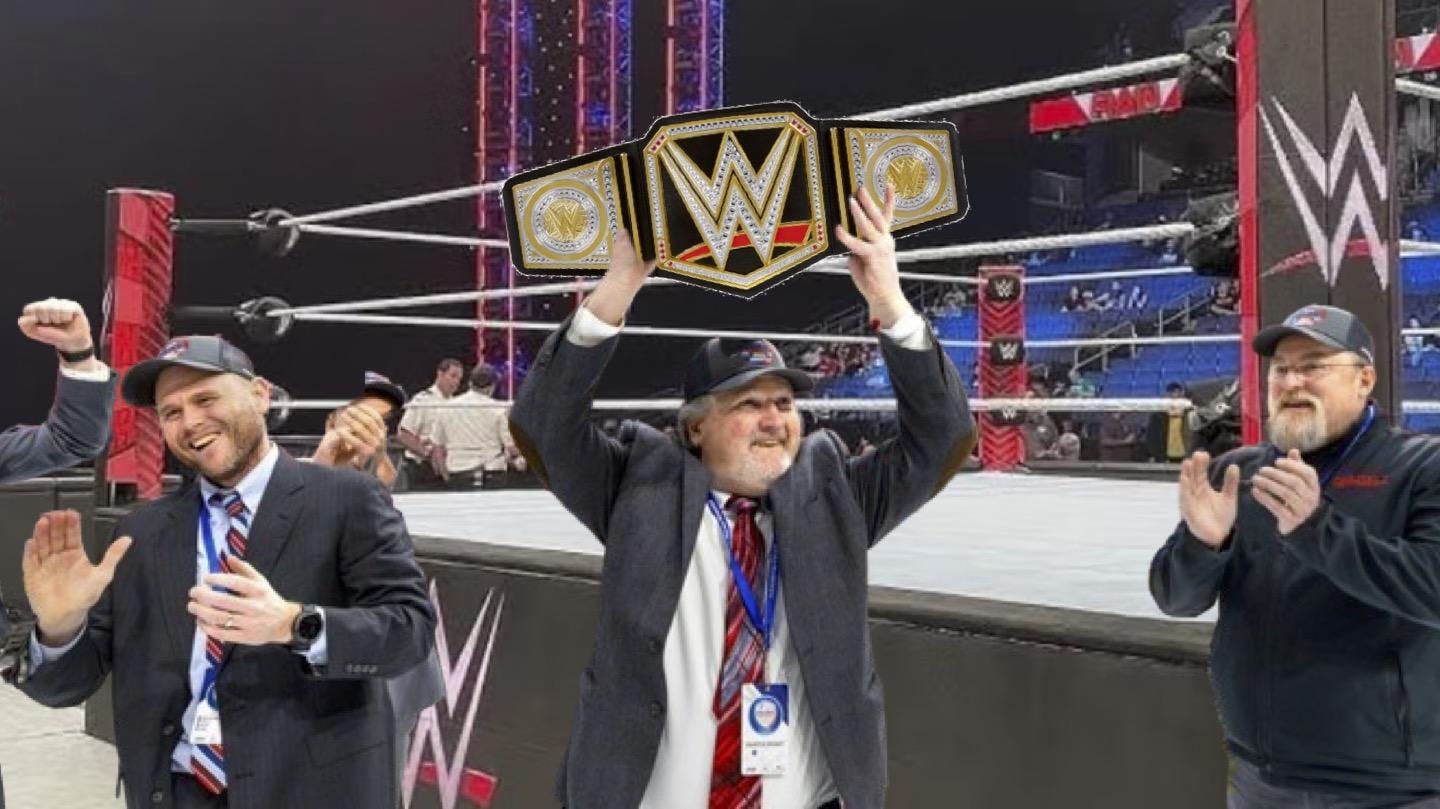
After weeks glued to ESPN+ for a never-ending postseason run, fans of Cornell men's hockey have re-emerged into society with one question: What's next for Schafe?
Head coach Mike Schafer '86 has spent the past 30 years of his life behind the Cornell bench. Though speculation circulated about whether he was moving to the women's hockey program, Cornell Athletics has debunked the rumor. A spokesperson stated that despite Schafer's knowledge of the game, he simply lacks the expertise required for a superior squad.
In a press conference this Monday, Schafer addressed questions about his post-retirement plans.
"I was looking at Puerto Rico," Schafer said. "But I heard the beaches had already been overrun by sorority girls on spring break."
Not quite ready to part with a career in full-contact sports, Schafer delivered a shocking message to fans used to his constant presence at Lynah Rink. Last Monday, the hockey legend officially announced his entry into the WWE ring.
The Sun received exclusive access to a training session between Schafer and the legendary coach Terry Taylor.
"It all started with the brawl against Dartmouth," Schafer said. "Just getting right in there with all those swinging fists was exhilarating. Terry saw the reel and said he saw real potential in me."
After men's hockey suffered a brutal 6-1 loss to Dartmouth on home turf, members of the Big Green skated over to taunt the Lynah Faithful. In response, the Red hopped the bench and prompted a full-team skirmish.
Schafer joined in after witnessing a Dartmouth player taunting the pep band.
"I was like, 'sure,' to the punching," Schafer said after the match. "It happens in hockey. But the second they threatened the source of the little jingle that plays before every power play, I knew it was serious."
Mere weeks later, the Red hosted Yale for the opening match of the ECAC tournament on March 8. When a Bulldog forward sprayed senior goalkeeper Ian Shane with a sharp stop right before the goal, Cornell leapt to its goaltender's defense, prompting a six-member brawl.
Schafer joined the fray with a solid hit to the face of Ron Grayson, one of three officials present to break up the fight. In the aftermath of the action, Schafer claimed regret, but onlookers noted the sparkle of adrenaline in his eyes.
"I'll be tuning in for every fight," Grayson said, still sporting a black eye at time of publication, on Schafer's WWE prospects. "That guy's got a mean right hook."
With a training regimen that currently consists of bench pressing hockey sticks, kickboxing goalie pads, and trying not to fall on the ice, Schafer plans to base his wrestling persona on his experience coaching Ivy League hockey. According to Taylor, the key to being a successful fighter is building a solid foundation before moving outside of the comfort zone.
Potential ring names for the former head coach will be subject to a vote by all men's hockey season ticket holders. Nominations released so far have included Mike "Icing" Schafer and Whitelaw Outlaw.
Schafer's debut is scheduled to take place against YouTuber Jake Paul at 8 p.m. on June 8. Tickets for the Performance Center in Orlando, Florida are available now. The match will be streamed live on ESPN+.
Betty Gainz is a student athlete in the comms department and can be reached at Gainz@cornellsun.com.
Editor's Note: 4/20 content is a part of The Sun's joke issue and contains exaggerated and factually inaccurate information.
BURZLAFF | The Tip Jar (1) 16 Apr 2:19 PM (2 days ago)
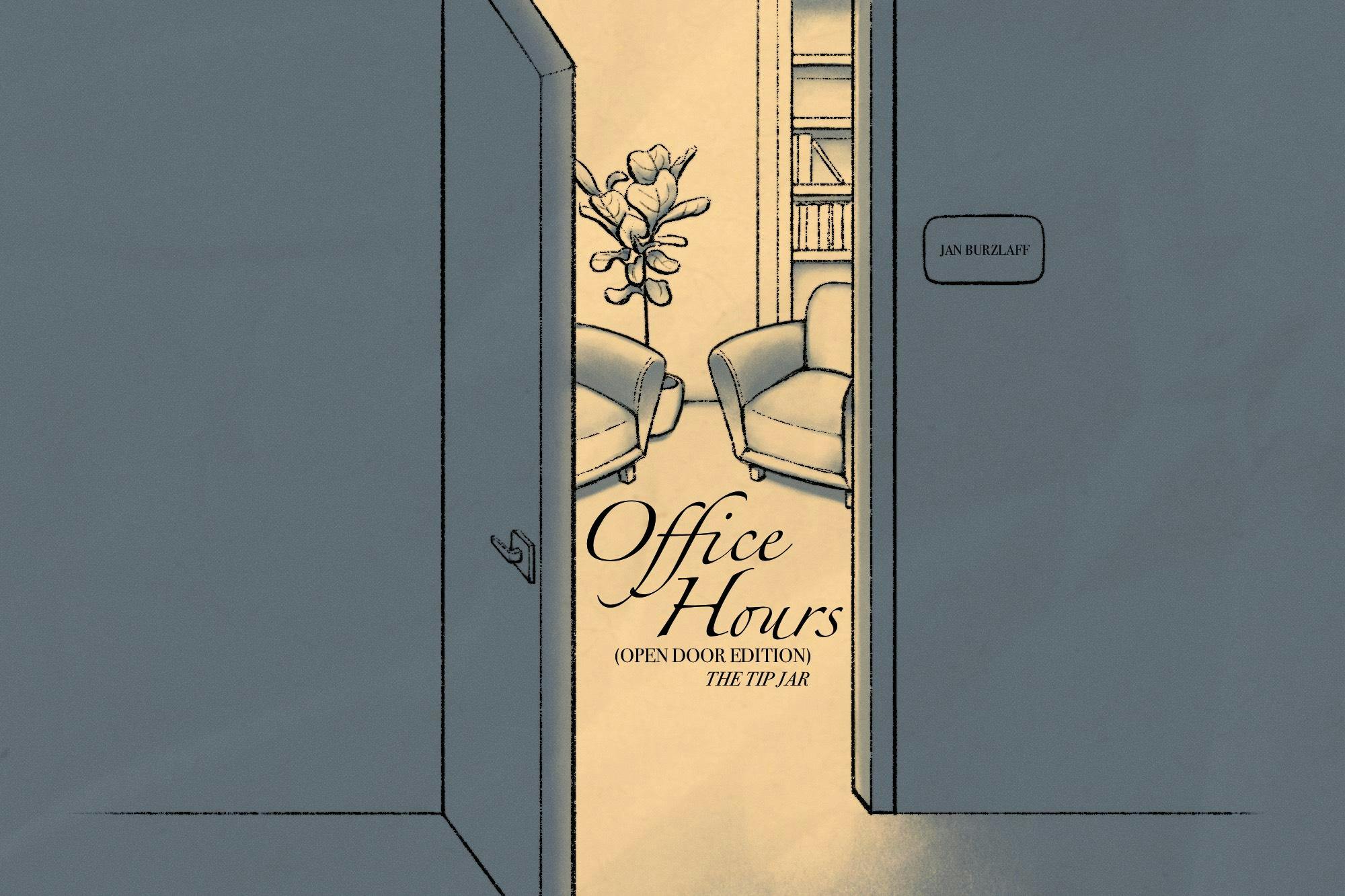
Last week, a student submitted a response through my Tip Sheet following a difficult conversation with their younger sister, a student at another Ivy League school. "She asked me 'Would you be friends with someone who voted for Trump?'" Their reply was instinctive: "yes of course" while "[their sister's] answer was a definite no." The student explained that this difference was not out of ideology, but lived experience: "My friends voted for Trump. They're my friends. If they were scoundrels, I wouldn't be friends with them."
But that answer opened the door to deeper questions - about empathy, loyalty, history and how we live with political difference. "How do you tell someone, who's genuinely wondering, that it's ok to reach across an aisle?" they asked. "Is it even something worth pursuing?" They also reflected on the war in Ukraine, on ruptured friendships and the haunting difficulty of reconciliation."How do you empathize with someone you can't understand?"
They ended with a quiet plea: "Where do I find the answers?... I doubt I'm the only person on this campus who needs a list of things to read… Where do I start?"
Thank you for writing with your whole heart. You're not lost - you're just paying attention, and I am certain many others feel the same. There's indeed a quiet, aching courage in what you're asking. These questions live in your sister's voice, in the hard knot of knowing that your friends voted for someone whose actions hurt people - and still choosing to be friends. You're not looking for loopholes; you are looking for something much harder: How to live with complexity without collapsing into extremes, despair or perhaps worse, indifference.
And that's exactly where we begin: Empathy is not an endorsement. Understanding why someone voted for Trump - or for anyone - is not the same as excusing what that vote enabled. But understanding is still a moral act. Because if we stop trying to understand each other, we stop being a community: in the classroom and outside of it. Building that understanding starts with listening - not to agree, but to learn how someone sees the world, and what shaped that view. I always appreciated the definition that political scientist Jon Elster once proposed for "society:" a space of condensed transactions - exchanges of belief, memory, fear. To understand someone, then, is to pause those transactions long enough to ask what they're carrying beneath the surface. It means holding your own values while refusing to reduce others to their worst decisions.
My expertise is the twentieth century. In small towns like Bełżec, Poland, Jewish and Catholic neighbors borrowed sugar, raised children next to one another and exchanged holiday greetings. But slowly, that ordinary coexistence began to fracture under the weight of economic hardships, deep-seated prejudices and sharp political rhetoric. Resentments hardened into conspiracies - and eventually, too often, into indifference or outright complicity after 1939. These are the consequences of polarization when it's left to fester: grievance becomes ideology and cruelty begins not with "monsters," but with people who once lived side by side. I've seen where it leads.
So when you ask, "Is reaching across the aisle even worth it anymore?" my answer is yes, when done with care, with boundaries and with a commitment to justice that doesn't erase disagreement and makes space for dignity.
You already know that, since you're trying to live it. And you're right: "How do you empathize with someone you can't understand?" might be the central question of our time. Nobody can give you a rulebook. The world doesn't divide cleanly into villains and heroes, and even though your friends have made a political choice you find deeply painful, you still see them as more than that choice. That's not weakness but moral imagination. It's what makes peace possible.
I often think of Eva Mozes Kor, a Holocaust survivor and one of the twins subjected to Josef Mengele's experiments at Auschwitz. Decades later, she decided to publicly forgive the Nazis - not without backlash - because she refused to let hatred define the rest of her life. That kind of (remarkable) forgiveness is a philosophy, and it takes far more strength than condemnation.
But peace, as you point out, is not the same as forgetting. You wrote: "Last year I was slapped in the face with the fact that history matters." That line stayed with me, not just because I am a historian. Of course, history matters in who gets believed, protected, mourned, elected, remembered. Peace, if it's to last, is about choosing to make a different kind of future precisely because of what happened.
Now, about that part near the end - the part that struck me perhaps most: "Where do I find the answers? And don't answer 'in a liberal studies education.' Some of us are technical and can't handle formal liberal studies education, unlike you."
Being "good at the technical side" doesn't disqualify you from wisdom. Anyone who writes "I know there's something I'm missing and I don't know where to start" is right where the humanities begin. What you need - what you already have - is a hunger for meaning, a willingness to ask hard questions and the humility to admit what you don't know. You may not cherish the expression, but in my book, this is what a liberal education looks like - done honestly, done humbly, and done by you.
So, when your little brother asks you about the world, you can tell him it's complicated, and the best thing we can do, as you put it, is stand by our values, be a good neighbor on and off campus, try to love others and resist the pull of cruelty. Then you can ask him what he thinks. "Just" doing these things may feel unbearably small, but I believe it's everything. It's how the fabric of shared life is maintained or even slowly repaired - through care, decency and the refusal to give up on one another. You don't need to have all the answers to be a guide. You just need to engage and stay in that conversation.
You're already doing that. And I'm very grateful you wrote.
For the anonymous writer-and everyone else quietly wondering where to begin (or begin anew): Here's a tentative list based on my personal trajectory. I promise there won't be a quiz. Think of it as a backpack for your individual journeys.
On Political Polarization and Moral Divides
- Why We're Polarized - Ezra Klein
- Polarized - James E. Campbell
- Uncivil Agreement - Lilliana Mason
- The Righteous Mind - Jonathan Haidt
- The Monarchy of Fear - Martha C. Nussbaum
- On Tyranny - Timothy Snyder
- The Influential Mind - Tali Sharot
- The Fire Next Time - James Baldwin
On Dialogue and Listening in a Fractured World
- High Conflict - Amanda Ripley
- Let's Be Reasonable - Jonathan Marks
- Braver Angels Podcast
- The Empathy Exams: Essays - Leslie Jamison
- Gravity and Grace - Simone Weil
- Man's Search for Meaning - Viktor E. Frankl
- Hope in the Dark - Rebecca Solnit
On Psychology and the Human Mind
- Thinking, Fast and Slow - Daniel Kahneman
- The Scout Mindset - Julia Galef
- Think Again - Adam Grant
- Mistrust- Ethan Zuckerman
- The Presentation of Self in Everyday Life - Erving Goffman
- Misbehaving - Richard Thaler
Jan Burzlaff is a Postdoctoral Associate in the Program for Jewish Studies. Office Hours (Open Door Edition) is his weekly dispatch to the Cornell community - a professor's reflections on teaching, learning and the small moments that make a campus feel human. Readers can submit thoughts and questions anonymously through the Tip Sheet here. He can also be reached at profjburzlaff@cornellsun.com.
The Cornell Daily Sun is interested in publishing a broad and diverse set of content from the Cornell and greater Ithaca community. We want to hear what you have to say about this topic or any of our pieces. Here are some guidelines on how to submit. And here's our email: associate-editor@cornellsun.com.
Cornell Adds 'Gay Son or Thot Daughter' Application Question 16 Apr 1:49 PM (2 days ago)
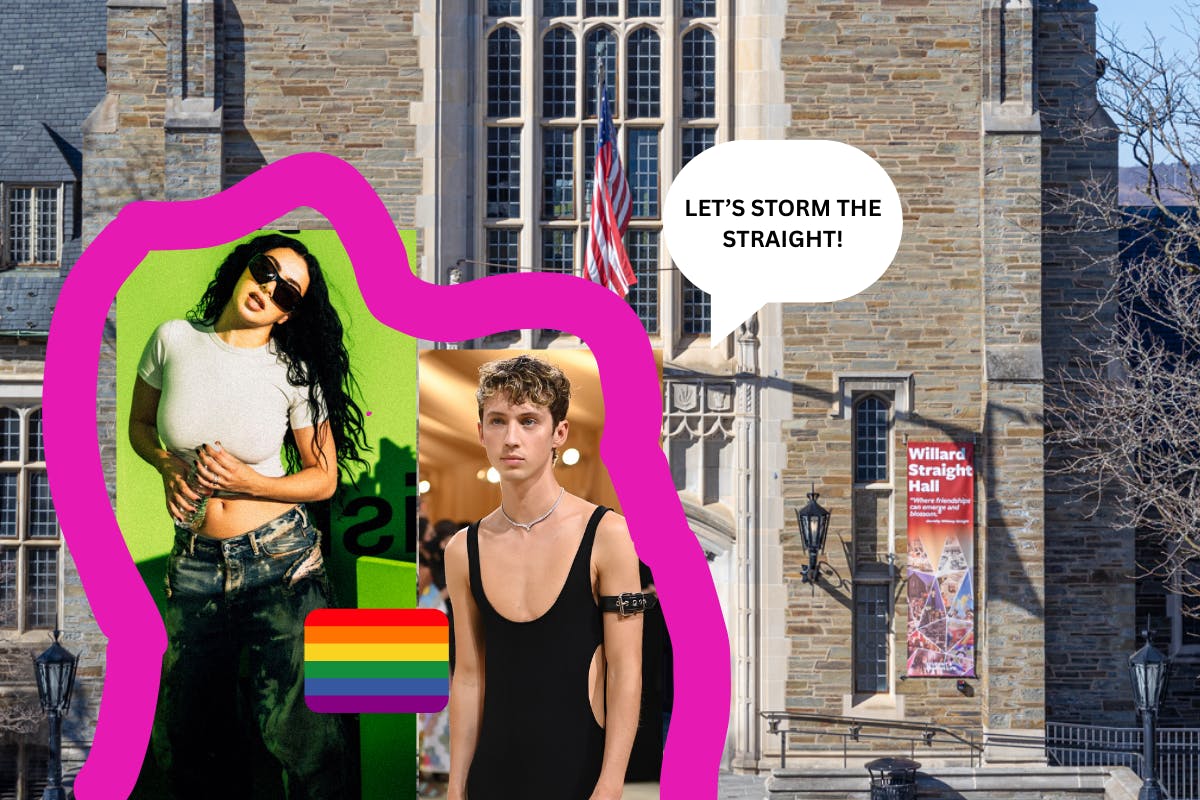
In the wake of Trump's crackdown on diversity, equity and inclusion in admissions and the Sweat Tour starring Charli XCX and featuring Troye Sivan, Cornell has added a fourth required admissions question: "Gay son or thot daughter?"
"We thought our hands were tied, but we were wrong," top administrators said in an email sent to the student body this morning. "Sabrina's fluffy pink handcuffs were unlocked. Now, we get to uplift two minorities well within the law - sluts and cis gay men."
The admissions question has been received with mixed responses - and a fair amount of confusion.
"I thought that they meant 'thought daughter,'" said Lucie Dacys, an applicant and avid Sylvia Plath reader, Earl Gray tea drinker and Mary Jane's wearer. "Isn't this school supposed to be for smart people?"
In a series of misunderstandings, one current student and Sun columnist mistook the word "son" for "Sun."
"I really thought (thot) the question was about me," wrote Sex on Thursday columnist and gay icon Jack Strap in an email to The Sun. "I was hoping the University was trying to be an ally and recruit a new SOT writer. And we really, really, need more tops."
Current Cornell student, Alf A. Fee '27, had mixed feelings about the apparent thot daughter recruitment.
"Those divas don't know what they're getting into," Fee, social chair at Oozma Kappa, said. "There's only so much walking to Collegetown in a mini skirt in 30-degree weather only to get doxxed underage drinking on the Level B Instagram a girl can take."
As for Charli and Troye, @gossipgirlcornell reported that they were supposed to headline Slope Day, but Troye backed out when he heard about "the Straight" - Willard Straight Hall.
"Their allyship feels performative. Where's 'the Gay'?" Sivan said. "Let's storm the Straight."
When asked for comment repeatedly on Slope Day and the application question, Charli XCX exclusively and continually replied: "Brat."
Addie Sun-Ray is a student in the College of Future Unemployment and can be contacted through a Ouija board.
Editor's Note: 4/20 content is a part of The Sun's joke issue and contains exaggerated and factually inaccurate information.
Launching: Celibate Tuesdays! 16 Apr 1:37 PM (2 days ago)
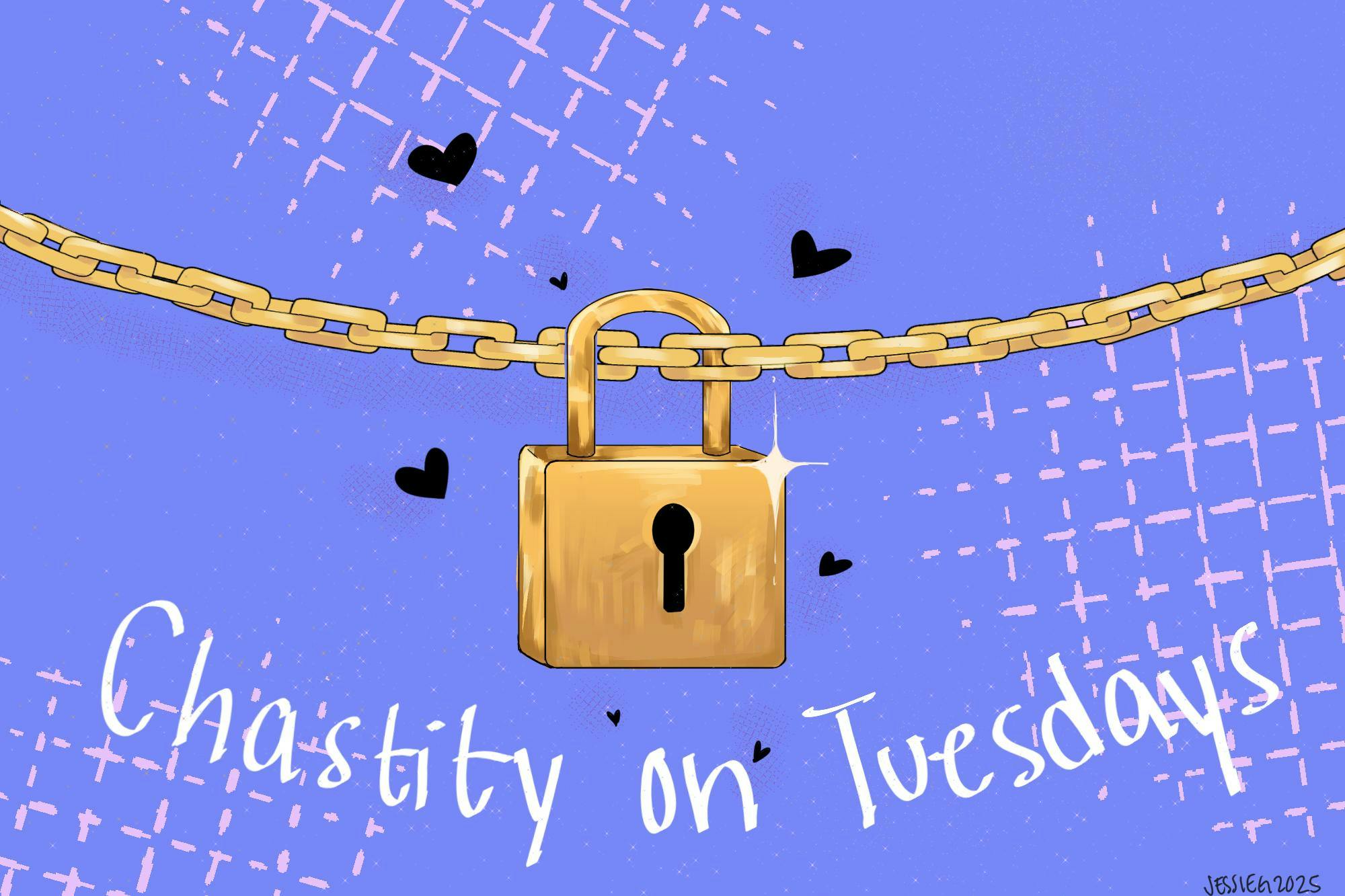
Dear readers,
Did you miss me? Because I missed you, dearly. Not as much as I miss sex though.
A while ago, I had an epiphany. Don't you worry, I did not decide to become a religious ex-gay influencer - that would take one more failed situationship with a DL guy. Instead, I realized, I am too fixated on sex. I am too busy having sex, like: All. The. Time. If you try to reach me during the weekend, tough luck. I will be caught between a c*ck or two (maybe more!) and will not check my messages - or the emails from my editors - for the entire weekend.
In fact, I am so busy having sex that I have not had the time to write about it! I mean, I tried, trust me. But there is something fundamentally incompatible with riding it reverse cowboy style and typing away on my laptop. Something had to give. And I am far too generous not to give my hole to my frat brother of choice on a Friday evening.
But I am a man of principle, and I believe in compromise. As my ex sugar daddy Ezra always said to me (while we were having threesomes with his pal A.D.) "Do the greatest good." So, I am launching a new column - R.I.P. Gulp Fiction - to talk about what really matters. Celibacy!
Celibate Tuesdays will run every Tuesday (without fail, ever!) to hold me accountable to NOT having sex. I have settled on celibacy because the abstaining, ace and incel communities deserve sex free representation too! (Not that incels deserve respect, don't get it twisted). The typing time will keep me busy long enough so I will not accidentally stumble upon a hard throbbing c*ck (Although if I stumble upon one on my desk chair, I might forget it is there when I sit down). There are many benefits to celibacy - I think, maybe? I look forward to becoming a more well-balanced individual (I am known for keeping my balance).
It will be so difficult to stay celibate - on Tuesdays only - maybe every other week - only during the school year. But with a 200+ body count, I suppose I have already seen all the violations of men that exist at Cornell, and beyond.
You may wonder what brought about this epiphany for me. I decided to do this as an act of solidarity with my fellow editors who are too busy racing to submit the print issue on Tuesday nights to get some. Although depending on the editors, I am just a Slack message away, just joking! - (maybe not)(hear me out…)(Meet me in the money toilet stall).
I looking forward to having you join me in this new chapter, (****** ******* HMU if DTF after submitting the paper??!!)
Editor's Note: 4/20 content is a part of The Sun's joke issue and contains exaggerated and factually inaccurate information.
Salvaging the Soul of Feminist Art: Reviving Suzi Ferrer's Legacy at The Herbert F. Johnson Museum of Art 16 Apr 11:30 AM (2 days ago)
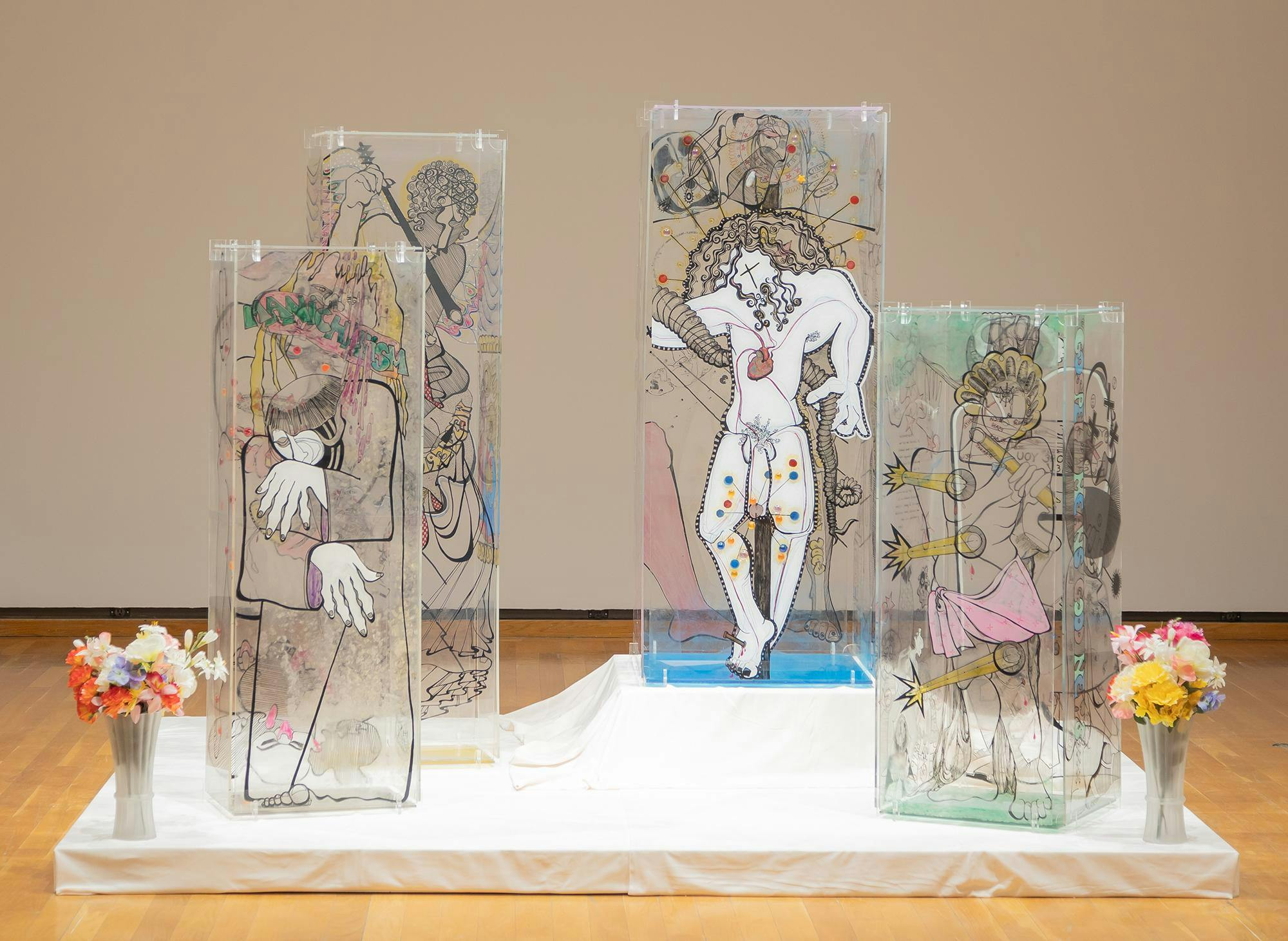
Just as most creatives are forgotten, Suzi Ferrer's name and artwork were confined to the storage closets of history. Cornell's Herbert F. Johnson Museum of Art presents this legendary artist's brief yet prolific time on the art stage.
The exhibition, set to run from Jan. to June of 2025, showcases the profundity of Ferrer's work. In doing so, the exhibit demonstrates how the twin themes of second-wave feminism and gender roles manifest in society through dissentient artwork. The Johnson Museum masterfully presents a dazzling array of the artist's unique works. The careful curation of this exhibit allows us to rethink Suzi Ferrer as a woman whose artwork conveys vital themes - ones that remain strikingly relevant to today's political panorama.
Upon entering the exhibit, themes of bodily autonomy and the Second Wave feminist movement hit close to home. The exhibit inspires Ferrer's generation to reminisce on the rights they gained and our generation to visualize the retrograde motion of society today. Ferrer's motivating work displays the rights our foremothers fought and died for and the sanctity of these endangered protections.
Upon first entering the exhibition, I was transported to 1960s Puerto Rico, engulfed by feminist themes applicable to almost anywhere in the world. This immersion is done both through the breathtaking art and distinctive exhibition design. I had the honor of discussing the curation process and Ferrer's life with her son and proud Cornell alum, Miguel Ferrer, and curator Melissa Ramos Borges.
As a young American Jewish woman living in Puerto Rico, Ferrer felt ostracized. She challenged the fallacies held about her identity through dramatic, evocative imagery in her artwork. As Miguel remarked, her art reflected her identity because it was intense - she wanted people to engage, question society and push back in a nonconformist manner. Ferrer confronts the preconceived notions about sex and desire and invites us to do the same.
While other female artists explored similar ideas through paintings hung on a wall, Ferrer was ahead of her time. She selected distinctive mediums and cunningly incorporated the space and sounds to communicate socially relevant themes. For example, she drew provocative silhouettes on plexiglass, boldly hanging them from the ceiling to comment on the subjugation of the female body - a particularly awe-inspiring work I came across in the exhibit.
Besides educating us on recurrent themes of femininity, the exhibition beautifully embodies the circle of life. The very campus we complain about daily was where she first began to pursue painting. Miguel shared that despite all the beautiful journeys his mother took, it all came back to Cornell - the place where she became an original thinker. Her work allows Cornellians to see the evolutionary power of attending such an institution.
For Melissa Ramos Borges, as an art historian, curating this exhibit before even acquiring the works was an act of pure faith. That's simply the effect Ferrer had on people. Ferrer's artwork was from a time and place that challenged hegemonic art discourse, yet she seamlessly weaves political discourse into unique mediums. Ferrer was navigating the currents of being a woman and foreigner in Puerto Rico. Despite the misperceptions held about her identity, she defined herself in the art landscape. And, through her art, redefined womanhood.
Today, the art world is undergoing an indispensable renaissance, bridging the gender gap by integrating female artists into the landscape. As a woman who always had something to say, Suzi Ferrer creatively strung her emotions together in a deliberate creative process to empower the buried feminine emotion within us all. The profound reinstatement of Ferrer's work speaks volumes. At the heart of the Johnson Museum, we can find her voice and hear the words confined to storage closets, suturing her observations into a broader discussion of women's rights at a time when the female body is politically contested.
As her son and Ramos Borges both said, they hope people will walk out of this exhibition saying "That's fucking cool." I certainly did. Take some time out of your prelim-ridden week to visit the museum's conversation on Suzi's life on April 17, 2025 and the open house on April 18, 2025. The Johnson Museum is resolutely allowing the world to rediscover one of art history's greatest forgotten figures - and, trust me, it's beyond "fucking cool."
Ava Tafreshi is a freshman in the College of Arts and Sciences. She can be reached at ant63@cornell.edu.
SCHECHTER | Harvard Took the Bullet: Let's Follow 16 Apr 10:51 AM (2 days ago)
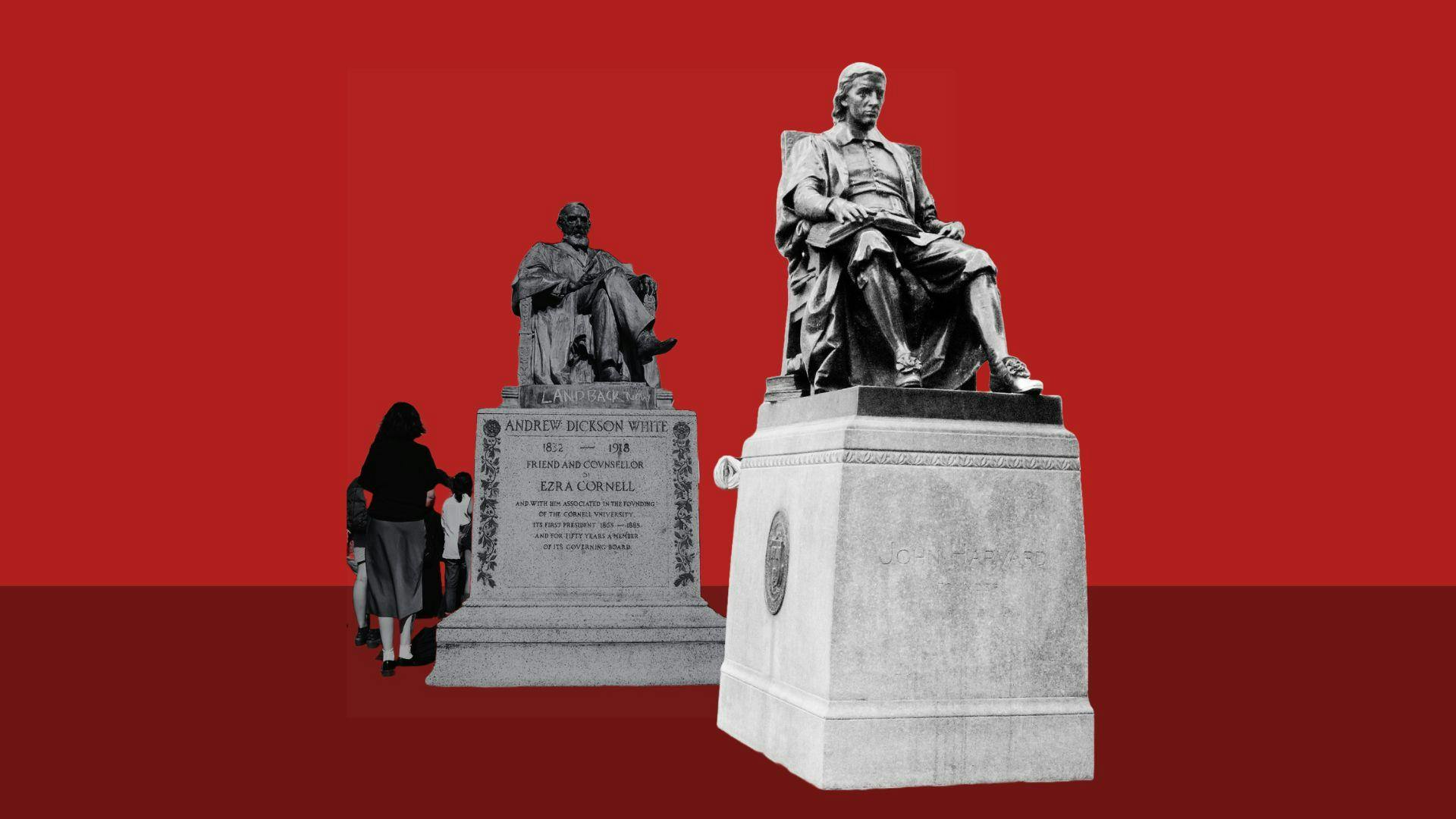
I am an only child, so I don't have any experience with siblings. But on Monday, the Ivy League's academic big brother, Harvard University, did what I expect any parent would want an older sibling to do. They set an example.
Just before spring break, I wrote urging the Cornell administration to work with the rest of the Ivy League and other schools in challenging the actions of the Trump administration. Since then, Cornell has seen $1 billion in funding frozen by the federal government.
What schools like Cornell need is substantive messaging that takes a firm, public stance against the threats to academic freedom. One way Trump's populism mobilizes the public against higher education is by painting a picture of elite universities as enemy institutions that proffer dangerous ideas and represent "woke" ideology. In reality, they're sandboxes for ideas to make society a better place. Challenging that perception requires loud, vocal support for the good work universities like our own do for society: innovations in spaceflight, advancement of artificial intelligence and developments in novel cancer treatments among other public goods.
That kind of highly public, vocal, individualized advocacy about the benefits of research universities requires some real guts. And taking the first step towards it is understandably difficult. Last week, a senior Cornell administrator framed it to me as a classic collective action problem. And they were exactly correct.
A collective action problem - familiar to any Cornellian in an economics or government class - is a situation in which a group shares a goal, but individual members hesitate to act, hoping others will. Put simply: why stick your neck out when someone else will do it for you?
In our case, high-level research universities broadly share the goal of defending academic freedom but fear the retribution associated with taking a stand. The administrator I talked to described this as the threat of being taken hostage. No school wants to take the first step. Textbook collective action problem: group interest, individual paralysis.
How do you overcome the paralysis? You need a first mover: a respected individual who takes that gutsy first step and absorbs the uncertainty of action. Maybe the risks aren't as bad as everyone's making them out to be, but they'll never know until someone acts. Once that dam breaks, momentum can build.
On Monday, Harvard University took that first step. President Alan Garber rebuked the Trump administration's demands on his university. They included leadership, hiring and admissions reforms; student discipline adjustments; viewpoint rebalancing within the faculty; and government monitoring. None of these changes are in line with the institution of academic freedom. So Harvard rightly charted a firm course, stating their "University will not surrender its independence or relinquish its constitutional rights" in the face of government demands.
As an institution with high public prestige, institutional leadership and sizable financial cushion, Harvard had the wiggle room to make a courageous move that substantially lowered the bar to solving the collective action problem.
What was the Trump administration's response to Harvard's defiance? More funding cuts and a threat to their tax-exempt status. While I don't want to downplay the far-reaching impacts of $2.2 billion in cuts (they will have profound impacts on the functioning of the university), the White House just continued using the tool available to them -financial pain.
With Harvard's refusal to bend, they may have started to break the spell of fear the Trump administration has cast over higher education. Publications have applauded Harvard's response. Public opinion seems to have swung their way.
Now, the collective action problem shifts from cooperation to momentum. The snowball has begun to roll and it's time for it to grow. Institutions like our own should take the cue from Harvard and join the fight.
On Monday, before seeing the news from Harvard, Cornell dipped its toes into the shallow end of resistance. In the relatively safe legal sphere, Cornell banded together with land-grant universities, the Association of American Universities and a variety of strong public and private schools to sue the Department of Energy over the cuts to indirect costs for DOE-sponsored research grants. This was a first sign of a resistant attitude from Cornell.
Now that they have seen Harvard take the first step, Cornell's administration should ratchet the pressure up a notch and join the fray of vocal opposition against the Trump administration from the highest levels of academia.
It was only natural for America's most prestigious university to set the tone in fighting challenges to academic freedom. Harvard is the older sibling of the Ivy League, and we need to follow them into the heat of opposition. Collective action is no longer an excuse. We can't leave our big brother to fight alone.
The Cornell Daily Sun is interested in publishing a broad and diverse set of content from the Cornell and greater Ithaca community. We want to hear what you have to say about this topic or any of our pieces. Here are some guidelines on how to submit. And here's our email: associate-editor@cornellsun.com.
Eyes Without A Face: The Paradox of a Masked Artist 16 Apr 8:00 AM (2 days ago)

Sleep Token's latest single, "Caramel," currently sits comfortably in the UK's Official Charts Top 10.
Slightly below Ed Sheeran's "Azizam" but just a couple positions above Sabrina Carpenter's "Busy Woman," it rests there as if this were its natural habitat - as if an alternative metal band nestled beside Benson Boone's "Beautiful Things" were the most ordinary presence in the world. Sleep Token has been making a splash far beyond Europe. With Billboard highlighting them in the Hot 100, and Spotify noting "Caramel" as the top global debut on April 6, the band has been taking the music market by storm, claiming global visibility that most obscure masked bands between Boston and Brooklyn could only dream of - more than a couple of crowded basements, and even more than an unreasonably active Tumblr tag.
And yet, here they are next to the titans of pop, with no promotions, interviews or on-stage banter. Sleep Token operates like the stoic performers of a long-gone era: they appear, play their set while occasionally breaking into a dance best described as a cross between Joy Division-esque twitching and a cardio jog and leave without providing any context. Silence seemed to be working for a while. Sleep Token has been active since 2016, releasing three albums and playing hundreds of live shows within the span of less than a decade, all without stepping into the limelight maskless.
A rupture came in 2024. In the blink of the internet's all-seeing eye, the musicians were doxxed, and all the YouTube fan videos opening with a chuckle of "well, we don't really know anything about them…" suddenly felt like a relic. Of course we do - and we know more than just anything: full government names and addresses. Berated by metal purists as "the Imagine Dragons of hard music," Sleep Token stepped into the pop world only to find themselves too unknowable for its parasocial demands.
But haven't we seen a masked performer before and managed to let their mystery breathe? Daft Punk have been left alone for decades on end. Orville Peck has been a pair of eyes and a toothy southern grin for as long as he pleased, only recently deciding to unmask for his role in Cabaret on Broadway.
A closer inspection reveals the contrast. Daft Punk were two chill guys making chill music. Orville Peck is open and warm, generously spending the currency of interviews and walking Vanity Fair through his house to show off his shoe rack. While maintaining a level of unattainability, both Orville and Daft Punk remained appeasingly easy to wrap one's head around - a compromise that Sleep Token didn't offer. They never invited a reporter into their houses, never posed for a cover of Teen Vogue. Their reluctance to maintain any communication with the press left the public, already suspicious of all hard music in the never-settling dust of Satanic Panic, feeling uneasy, almost provoked to uncover the truth - without being able to elaborate on what exactly they were hoping to find there.
It's the kind of entitlement Chappell Roan has been speaking up against while establishing boundaries with photographers and journalists. The "we made you; we own you" refrain has long haunted the entertainment industry, but few areas were affected by it as much as music where the management and promotion teams are staying in the shadows while the artist is front and center. Immediacy is a double-edged sword: while driving relatability and, in some cases, commercial reach, it does not tolerate the lack of transparency in a way usually only reserved for most intimate relationships. While not entirely unreasonable - fans are understandably wary of supporting the "wrong" people - this desire for clarity cannot realistically be fulfilled. Even knowing the artists' names, the fanbase is left with a mere set of letters that say nothing of their bearers' moral character. Unless we are willing to conduct a thorough investigation into every artist's background, we may need to reckon with the uncomfortable possibility: we may simply never know. Sleep Token's doxxing yielded, from the public's perspective, a handful of superficial data and a couple of blurry photos of the vocalist, Vessel, on Google Images - an almost disappointing outcome of something that should have felt like a moral victory.
The potential losses that we stand to bear, on the other hand, are concrete and tangible. The arts have long been a safe haven for the outcast, the lonely, the sensitive - a utopian corner of the world where everyone could feel seen. Leaving this premise behind may not kill the entertainment industry, but it risks turning it into a strictly regulated field, governed not by the most creative, but by the most durable, and this tradeoff is worth sitting with. Are we willing to sacrifice artistic expression for the slender illusion of control?
And if we rip every mask off before it slips, will anyone dare wear it at all?
Arina Zadvornaya is a graduate student in the College of Engineering. She can be reached at az499@cornell.edu.
An Editor's Very Real First Time Getting High: Bear Spray, an Edible and a Midnight Visitor in the Woods. 16 Apr 7:55 AM (2 days ago)

There are a few moments in life when time slows down just enough for you to realize you've made a terrible, terrible mistake - like those students who just committed to Columbia. For me, that moment came somewhere between my face getting blasted with bear spray and a real live bear showing up outside my tent. But let's rewind.
It started as a simple camping trip. Me, my brother, and nothing but untouched wilderness. We were deep in the woods - like four hours from the nearest city, deep. Think towering mountains, alpine lakes, no cell service and no one else around for miles. It was beautiful, serene and a little bit dramatic in that nature-romance kind of way. I was thriving. First night of the trip and the morale was high.
My brother, a seasoned stoner, naturally brought an edible with him. I, an innocent soul with no experience whatsoever in the realm of weed, thought: Why not? We're in the woods. We're vibing. What's the worst that could happen?
Oh, sweet, naive me.
My brother, bless his enthusiastic heart, gave me what I would later learn was far too much for a beginner. Like, astronomical amounts. "It'll hit in a bit," he said casually. Forty-five minutes later, I was clinging to the earth like it might launch me into space. My brain was doing somersaults, my vision was a Jackson Pollock painting, and I could hear everything - everything - at once.
"Come sit in the car," my brother said. "It'll help you relax."
It did not help me relax.
You see, he had the bear spray in his pocket. Unlocked. He sits down, and the can decides it's time for chaos. The spray goes off, directly into my very confused, very overstimulated face. Suddenly, I'm not just high out of my mind in the woods. I'm high in the woods and my face is on fire. My skin is peeling, my eyes are screaming and my mind keeps spinning. I'm four hours away from the closest hospital. My brother is panicking. I'm panicking. I kept saying, "Are it end," which was the best my fried brain could come up with for "make it stop."
To his credit, he really tried. He helped me wash off, brought me water and guided me back to the tent like a charred, stunned little forest creature. Eventually, I crashed, probably more from exhaustion than anything else. I remember thinking: "Okay. That was a lot. But it's over now. Nothing else could possibly happen." - Right?
Spoiler alert: It got worse.
Some indeterminate time later, I woke up to a screech. A horrible, soul-chilling screech. My eyes blink open, puffy and crusty from the pepper spray, and I notice ... a shadow. A very large, very bear-shaped shadow. Literally right next to me. Inches away. Just me, a thin piece of tent fabric, and a wild black bear, all vibing together in the moonlight.
"There's a f*cking BEAR at our tent!" my brother shrieks.
Now, under normal circumstances, I would've lost my mind. I love the outdoors. I'll do a 20-mile hike like it's nothing. But a bear? Next to my face? No way. I would've run for my life.
But high-me? High-me was like, "Huh?"
I barely processed it. Just sat there, blinking slowly while this 400-pound predator contemplated its next move. Luckily for us, it was a black bear. Skittish. Loud noises scared it off. My brother yelled enough for the both of us, and the bear scampered off into the dark trees, probably equally confused.
When I woke up again the next morning, I genuinely couldn't tell if it had all really happened or if I had just lived through the most bizarre, terrifying National Geographic trip in my head. But the burns on my skin were real. The peeling was real. And the edible? Still kind of real. 12 hours later, I was still high. The only thing that had changed was that I now had firsthand knowledge of how it feels to be attacked by a bear while chemically impaired. Great.
I have no idea what I learned from that night, other than never trust a stoner's dosage judgment and never assume your brother's bear spray is safely locked. But hey - at least it makes for one hell of a 4/20 story.
Guess who wrote this? is a member of a class in a college in a university. They dabble in some form of work for a newspaper. They can be reached at an email.
Editor's Note: 4/20 content is a part of The Sun's joke issue and contains exaggerated and factually inaccurate information.
The Sun's Postseason Men's Hockey Mailbag 16 Apr 7:53 AM (2 days ago)
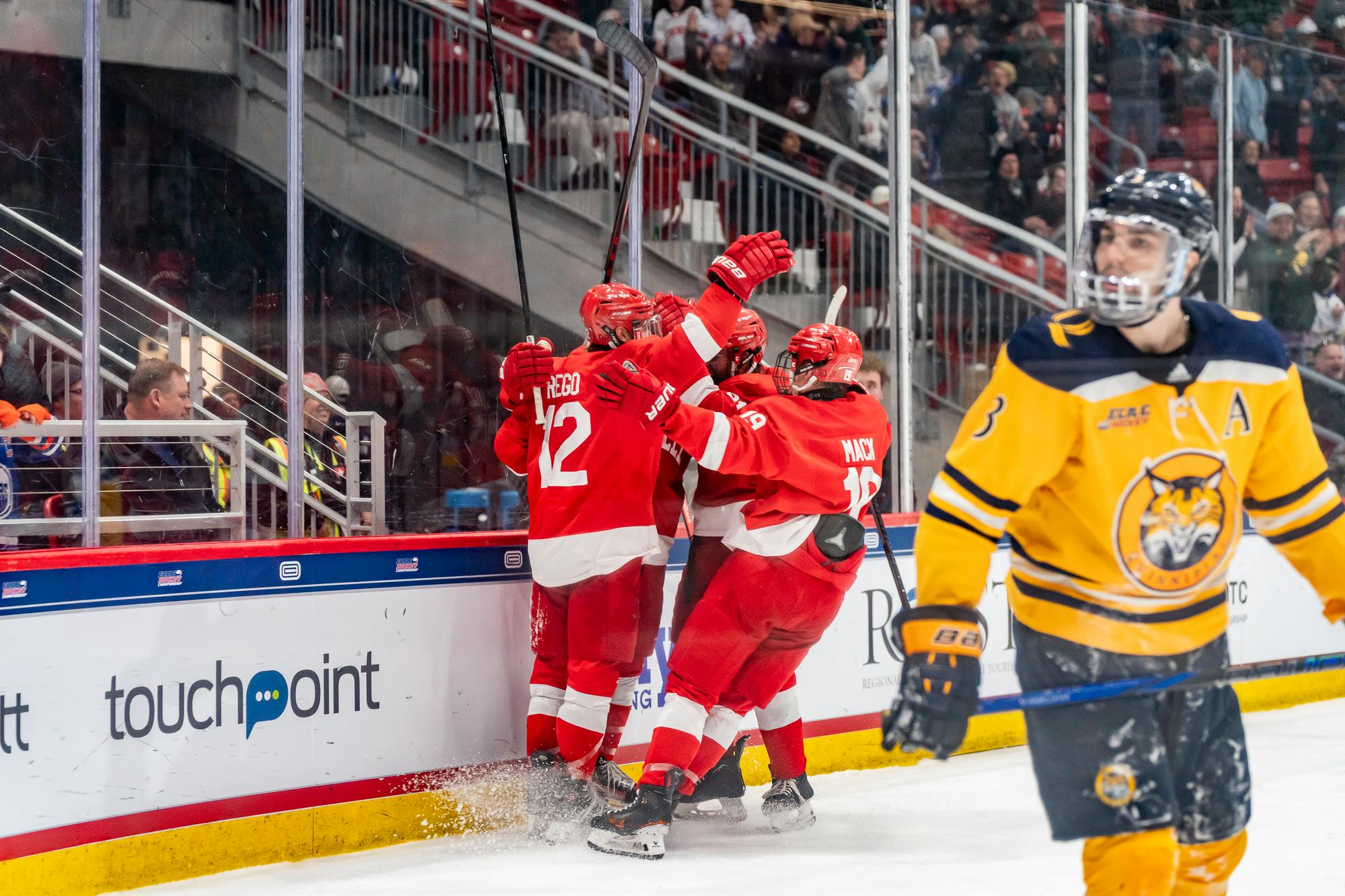
Though Western Michigan was just crowned the national champion of a tumultuous college hockey season, men's hockey hasn't taken the ice for 18 days, and has already seen a handful of intriguing developments.
As the dust settles on what was a sprint to the end of a turbulent Cornell hockey season - the final one for Mike Schafer '86 - there remain endless questions about how the 2024-2025 season unfolded, and how things might change for 2025-2026.
In my third and final mailbag of the season, I will do my best to answer - most of - your burning questions about the Cornell men's hockey team.
Good or bad, what surprised you most about this Cornell hockey season?
The most surprising thing was not where Cornell ended up, but how it got there. Injuries inhibited the Red from playing consistent hockey from the start of the season, and the magnitude of the injuries was unlike anything I had ever seen. The team had to battle through impaired lineups and suspensions just to finish sixth in the ECAC.
A mere few weeks after Cornell solidified its No. 6 seed in the ECAC tournament, it was preparing for a regional final matchup against Boston University.
The Red had the potential to play as dominant as it did down the stretch all season, but ulterior misfortunes seeped into the locker room and created a rocky road into the NCAA Tournament. What is most surprising was not Cornell's 4-3 victory over top-ranked Michigan State but how long it took to get to that point, and what the Red had to struggle through before things began to click.
What also surprised me immensely was the inconsistency of special teams. Though Cornell finished a middle-of-the-pack 42nd in power play percentage (18.2 percent) and 37th in penalty kill percentage (79 percent) in 2023-2024, the Red's power play this past season never climbed out of the bottom-five in the country. Cornell finished at 14.7 percent, but often mingled around 10-11 percent throughout much of the regular season.
With strikers like junior forward Dalton Bancroft and sophomore forward Ryan Walsh, it was expected that Cornell's power play might rise to the level it once was in 2022-2023, where the Red finished with the seventh-best man advantage in the country (24.6 percent).
The penalty kill struggled early - perhaps an inherent consequence of losing former associate head coach Ben Syer over the 2024 offseason - but ultimately regained its footing and finished at 14th in the country (82.7 percent).
Late-season heroics - like senior defenseman Tim Rego's overtime winner against Quinnipiac in the ECAC semifinals, a night Cornell scored twice on the power play, and senior forward Sullivan Mack's last-second game-winner against Michigan State - might have partially satisfied some fans' dissatisfaction with the power play all year. But in order for Cornell to contend next season, a year set to be riddled with question marks, the numbers must improve.
Way too early line projections for next season?
Like you said - it's way too early. Next year's recruiting class has not been rounded out yet. Elite Prospects and Neutral Zone both list Cornell as having 12 incoming freshmen next season, but that number could change depending on how active head coach Casey Jones '90 is in the transfer portal. I'd anticipate the incoming class being around 10-12 players deep to account for losses.
With placeholders for the departing players, here's an idea of where the Cornell lineup stands right now based on the starting lineup from this past season.
LW - Walsh - RW
LW - C - DeSantis
LW - Castagna - Major
Kraft - Catalano - RW
LD - RD
LD - Stanley
LD - Fegaras
G
Keopple
Katz
Now, I'll fill in with some of the healthy scratches and injured players that should return next season, plus a little shaking up of the top-six.
Kraft - Walsh - Major
LW - Castagna - DeSantis
LW - Devlin - RW
Donaldson - Catalano - Wallace
Fisher - Stanley
LD - Fegaras
O'Brien - Wolfenberg
Keopple
Katz
The forward lines are definitely subject to change. I could see Kraft potentially skating on a line with DeSantis to maximize speed. The same could be said about Devlin being paired with Wallace to account for physicality. Devlin has also played on the left wing at times, but is listed as a center and could be asked to account for the loss of depth at the 'C'.
I slotted junior defenseman Jack O'Brien in with freshman defenseman Nicholas Wolfenberg, as I'd expect he'll contend for a spot in the starting defensive pairings with the departure of four key defensemen. I also added incoming sophomore transfer Michael Fisher, who is a defenseman that played for Northeastern in 2023-2024 and in the British Columbia Hockey League this past season. He is listed as having a right-handed shot but has played on the left side with the Penticton Vees this past season.
That leaves two extra returning players - sophomore defenseman Marian Mosko and freshman forward Parker Murray - that I expect will compete with incoming freshmen for lineup spots. Of course, any of the incoming players could overtake current starters for roster spots. When you account for injuries, the departures don't look quite as costly.
The biggest loss comes between the pipes.
Who is supposed to be the No. 1 goalie next year?
Junior goaltender Remington Keopple should undoubtedly be given a look for the starter's crease for his senior year. In his brief appearances throughout his tenure, Keopple has shined - no brighter than on March 1, where Keopple secured a 21-save shutout after earning a start in Cornell's final regular season game. Senior goaltender Ian Shane was then given the nod for the playoffs and won six of his final seven games.
The coaching staff made the tough decision to go with Shane over Keopple in the playoff, presumably due to his experience. Keopple should earn that experience next season, but it's anyone's fight for a spot between the pipes.
Also returning is freshman goaltender Justin Katz, who battled injury throughout his first season and did not dress for the Red's final nine games. Katz is an intriguing prospect who, notably, catches with his right glove instead of the standard left for most goaltenders, but has struggled to stay healthy over the last few years.
Arriving in Ithaca this fall will be Erick Roest, a 2004-born goaltender who hails from Lethbridge, Alberta. Roest has split time between the United States Hockey League and the BCHL, posting a .878 and .857 save percentage in 23 and seven games, respectively.
The three goaltenders should duel for the starting position, and all three should get playing time in Cornell's anticipated exhibition matches. Unless Roest or Katz shine, I'd expect it to be Keopple…
… However, I'd be interested to see if Jones utilizes the transfer portal for this position. In his last two years at Clarkson, Jones twice turned to the portal to find his starting goaltender. Before leaving Clarkson for Cornell, Jones recruited Lake Superior State's Ethan Langenegger for the 2024-2025 season, who went on to win ECAC Goaltender of the Year. In 2023-2024, Jones brought in Providence College product Austin Roden.
Obviously, Jones faces more constraints, as graduate students are not eligible to play in the Ivy League. But past behavior might indicate an interest in dipping into the portal for a potential starting goaltender - carrying four goaltenders is a tall task, but as Katz did not dress for much of the season, the small difference would be felt most at practice.
Is [Jones] going to try to use the transfer portal more?
On a similar note, I think yes. He's already picked up Fisher as a much-needed piece for the depleted defensive corps, and I wouldn't be surprised if he tried to recruit in the Canadian Hockey League after last year's rule-change that allows major-junior players to play in the NCAA.
The transfer portal is difficult to utilize as an Ivy League coach - there are so many academic constraints that accompany transferring into the Ivy League, as the standard is that much higher. Additionally, the lack of Name, Image and Likeness money coupled with the prohibition of athletic scholarships also limit the wiggle-room for Ivy League coaches to cash in on the luscious market of transfers.
Do you expect any more transfers out?
Re: Sophomore Defenseman Ben Robertson Transfers to Michigan
I don't expect any other players to transfer out, based on what I've heard from around the program. With Robertson's commitment to Michigan, as well as the status of the other two initially rumored destinations for Robertson - Notre Dame and Denver - it is clear that he was highly sought after by some of college hockey's top programs.
Originally reported by Mark Divver and subsequently confirmed to The Sun, Robertson is expected to attend Boston Bruins development camp this summer. Last summer, he attended Winnipeg Jets development camp as a non-roster invite. After going undrafted, a player like Robertson is looking to maximize his outreach to NHL teams.
Transfers in many cases are situational and unique, despite Cornell's coaching change.In short, I don't expect others to transfer out.
Leading goal scorer next season?
I'll take my pick now: Walsh. He led the way in 2024-2025 with 17 goals and 31 points.
Close seconds: sophomore forward Jonathan Castagna and freshman forward Charlie Major.
For the latest offseason updates on the men's hockey team, follow senior editor and men's hockey beat reporter Jane McNally @janemcnally_.
Dress Well, Feel Well: Styling Confidence 16 Apr 6:58 AM (2 days ago)
By Ruhi Datar
We've all been there - a gloomy Ithaca Monday morning, dread for your next class and a long week ahead. All you want to do is throw on your most comfortable pair of sweatpants and rush out the door with a messy bun. Sure, some might say that comfort is key, but I'd argue that there is something else that can actually make a bigger difference: the intentionality of dressing up and having a slow morning routine.
For me, the best days always start with a little ritual - my roommate and I listening to "Charm" by Clairo, sipping on our coffee and getting ready at the same time. We pick out cute outfits, do our makeup and put our best foot forward. It's peaceful, it's calming and, honestly, it sets the tone for the whole day.
I've noticed such a huge difference between days when I take my time in the morning, versus the days I'm scrambling out of bed before my 8:40 am class, still half-asleep. The days when I wake up earlier and allow myself that hour to get ready feel so much more productive and optimistic. The act of dressing up and taking time in the morning isn't just about looking good - it helps improve several other aspects of my day:
A sense of control. Taking the time to get ready in the morning, instead of rushing out the door, gives me a sense of control over my day. Especially at a school like Cornell, where it's so easy to feel overwhelmed by everything that needs to get done in your day; but slowing down - intentionally choosing an outfit I feel good in, doing my makeup, sipping on my cold brew - gives me a moment to breathe before the my classes and whatever else I have planned. It's a simple act of self-care that helps me mentally prepare for whatever ensues during the day. I've found that the calmness usually lingers, and I find myself feeling more centered, even when the schedule gets busy. There are many small acts people incorporate into their morning routines that help them feel more in control. For example, Kate Sahin '28 explains that "making my bed in the morning gives me a sense of order to start my day," while Estelle Emmons '28 says "I take my vitamin supplements every morning to feel more put together."
Boost of confidence. There's also something about putting on a well-thought-out outfit that makes you feel more put-together - like you have your life in order, even if you really don't. Studies have shown that dressing well can actually boost confidence and even improve performance. While a good outfit can make you feel more put together and confident, it's also about how it affects your mindset. Psychologists refer to this as enclothed cognition - the idea that what we wear can influence our mindset, behavior and even how we perceive ourselves; it's all about embodying confidence.
Improves your overall mood. Wearing an outfit you love also brings a small but meaningful boost to your day. Fashion is a form of self-expression, and the clothes we choose can shape how we feel about ourselves. When you put on something that makes you feel happy - whether it's your favorite sweater, a bold pair of sunglasses, or your best fitting pair of jeans - it can shift your entire mindset. Sanika Saraf '28 states, "Whenever I wear my jean jacket I feel good. I love a Canadian tuxedo." Even on tough or gloomy days, dressing up can act as an uplifting force. Mikayla Thomas '28 illustrates this perfectly: "I always wear my favorite Free People tank top to boost my mood because the shirt feels like summer, which makes me feel happy."
In the end, dressing up and taking time for a slow morning routine is about so much more than just looking good - it's setting yourself up for the best possible day. Whether it's the sense of control that comes from allowing yourself the time to take a breather, the confidence boost that comes from wearing the perfectly fitting top or the sheer joy that comes from self-expression that fashion brings, it all adds up. These small moments of intentionality can make a huge difference, especially at a place like Cornell, where it's easy to feel overwhelmed. So, next time you're tempted to skip the extra time for yourself and rush out the door, remember that a little intention in the morning can change your entire day for the better.
Ruhi Datar is a first-year in the College of Arts and Sciences. She can be reached at rrd56@cornell.edu.
Dyson to Be Renamed Donald J. Trump School of Business Excellence in Business 16 Apr 6:51 AM (2 days ago)
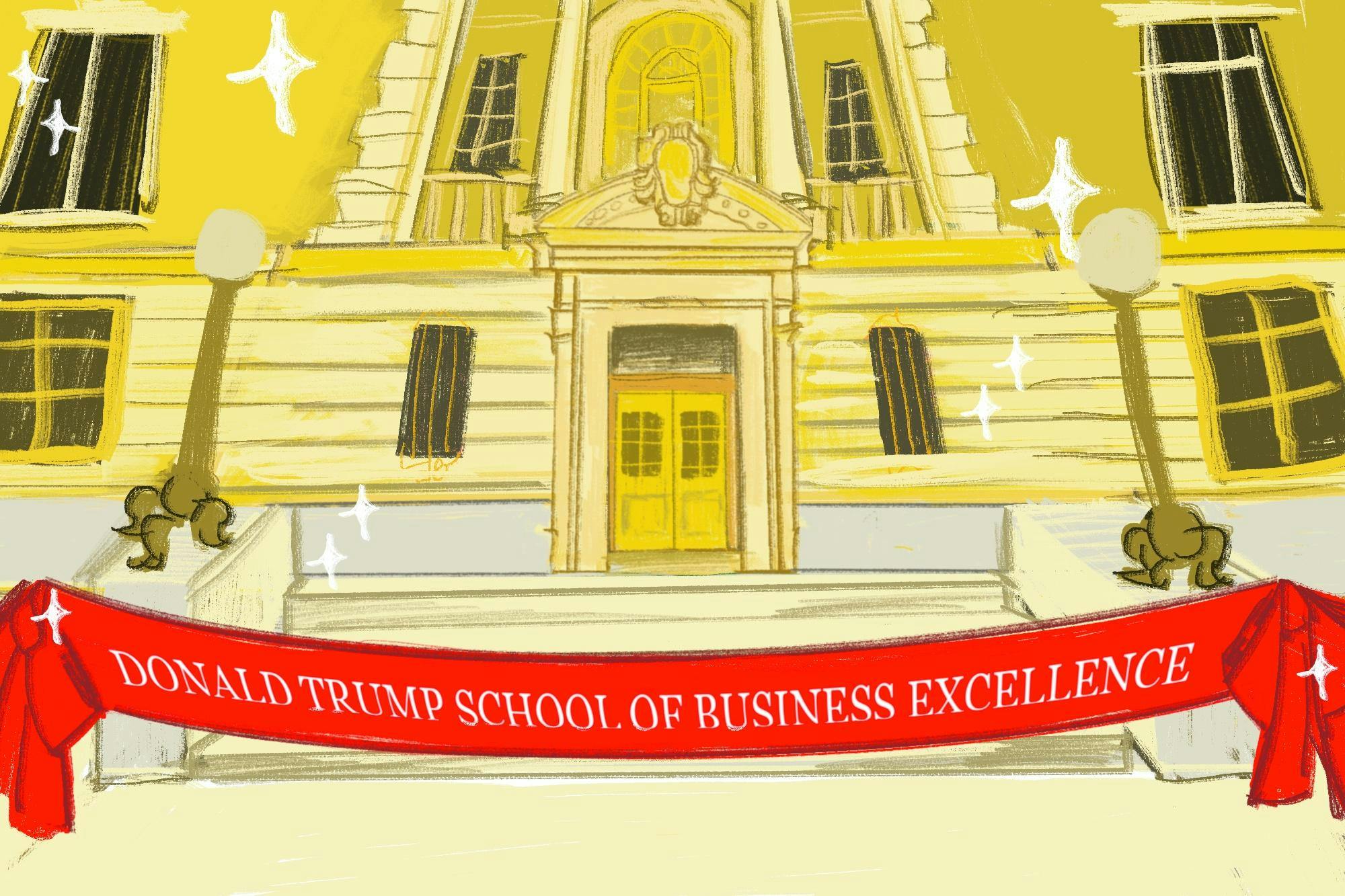
After intense pressure from President Donald Trump, the Cornell administration has decided to make a swift change in branding, renaming the Dyson School of Applied Economics and Management to the Donald J. Trump School of Business Excellence in Business.
On April 8, the Trump administration notified the Cornell administration that it had frozen $1 billion in federal funding. The administration delivered Cornell a list of demands that, upon completion, would lead to the restoration of federal funding.
In an interview with The Sun, President Kotlikoff said, "While I cannot publicize the exact content of the list, our University refuses to comply with the demands of an unhinged authoritarian who uses executive power to destroy the institution of academic freedom. Read my lips: no complicity."
Later in the day, however, Kotlikoff made a startling announcement in an email sent to the Cornell community that starkly departed from his generally academic tone. Seemingly influenced by Trump's syntactical style, Kotlikoff said, "We are a place where any person can pursue any study, especially the study of BUSINESS and DEALMAKING."
Kotlikoff continued, announcing the new name for the Dyson School.
"That is why we have decided to RENAME our SMART business school," Kotlikoff said. "This has been in the works for a LONG time! We're doing this HUGELY! WE WILL KEEP CORNELL GREAT!"
The statement from the Dyson School said that it would be renamed The Donald J. Trump School of Business Excellence in Business. According to the Cornell administration, the change of name represents an acknowledgement of Mr. Trump's deep commitment to lifelong learning and academic leadership.
They cite Trump's statement that "a book can be a big beautiful thing sometimes, with all those words in one place" as evidence of his passion for higher education. A University spokeswoman stated that Trump's devotion to the University's mission of "some people, a few studies" led Cornell to make the change.
It appears that she has misquoted the motto.
Along with the name and curriculum change will come an overhaul of the interior of Sage Hall. The building, originally constructed in 1875 as the University's first all-women's dormitory, will receive a long-overdue makeover that includes the installation of 14 new gold toilets and velvet drapery across the entire atrium ceiling.
When asked by The Sun how the University would finance the updates to the building, Vice President for New Construction Bilda M. Tall stated, "They're telling me the funding is being consolidated by cutting the Africana Studies and Gender Studies Departments. We're also getting a few million by terminating the women's ice and field hockey teams. Who needs that stuff anyways?"
According to administrators speaking under the condition of anonymity, the quick change in naming for the Trump School has absolutely nothing to do with the $1 billion in funding cuts. They say President Kotlikoff was "showing reverence for a great president" when he decided to rename the school.
Buildit Bigly was a second-year student in the former Department of Gender Studies. He can be reached at bbigly@cornellsun.com.
Editor's Note: 4/20 content is a part of The Sun's joke issue and contains exaggerated and factually inaccurate information.
Cornell Revises Expressive Activity Policy, Allowing Students With MAGA Hats to be 'as Disruptive as Possible' on Campus 16 Apr 6:41 AM (2 days ago)
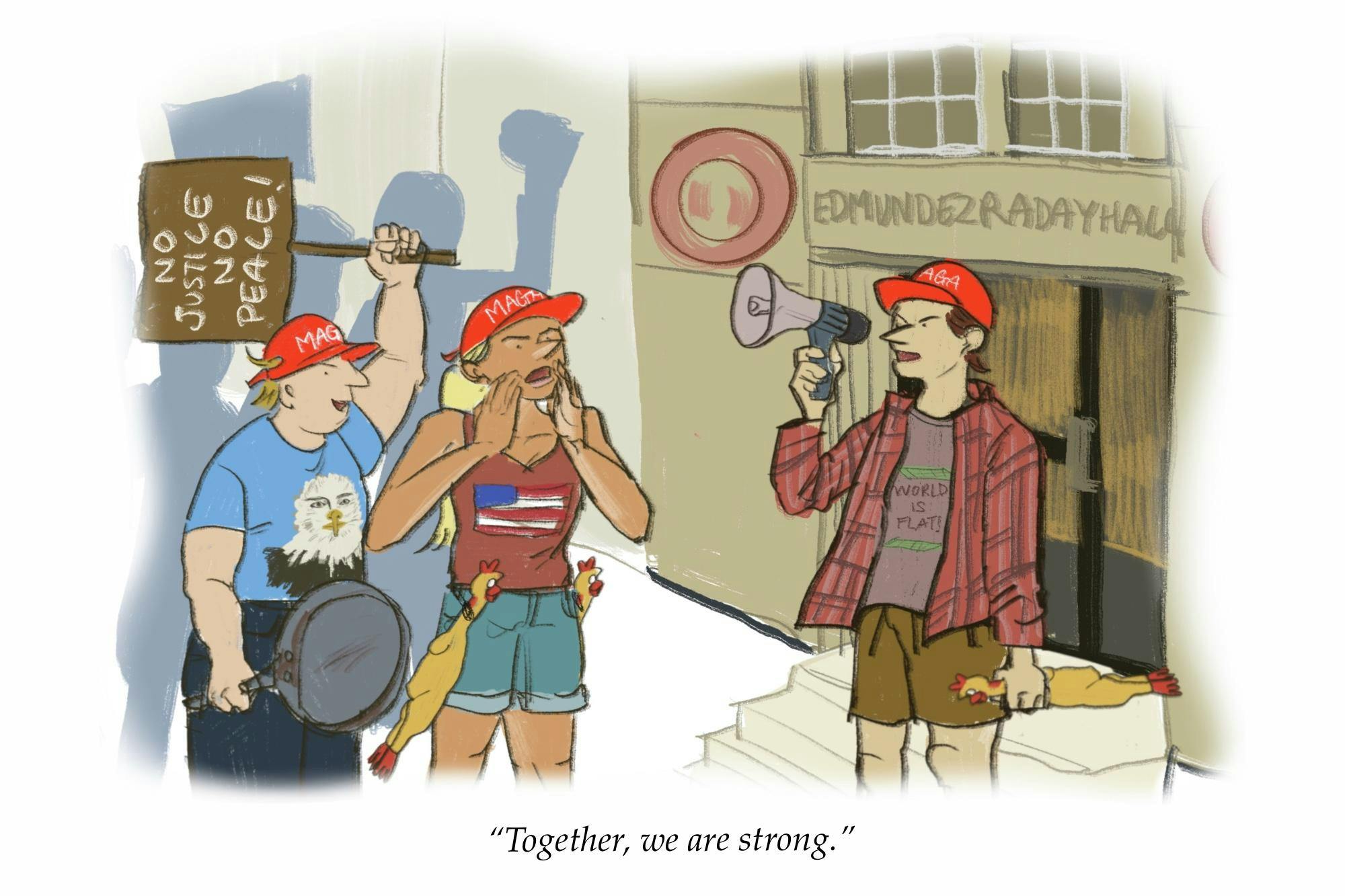
Following the University's adoption of its finalized Expressive Activity Policy in March, administrators revised the new policy, allowing campus protests without restrictions, with only one catch: it can only be done while wearing "Make America Great Again" hats.
The newly revised policy allows for students - or anyone - to protest in classrooms, Ho Plaza and in front of Day Hall 24/7 while wearing President Donald Trump's MAGA hats, showing the University's commitment to supporting the "greatest president to ever live, ever" according to a statement from University administrators on Tuesday.
The policy also allows for demonstrators wearing MAGA hats to have direct access to Day Hall and even the president's office to voice their opinions on important issues to administrators. Students are encouraged to get on top of Mikey K's desk and scream their most pressing concerns.
"It is important for this university to not restrict the speech of those who wear a MAGA hat, as it would imply that we are censoring what supporters of President Trump have to say," the statement reads. "Censoring the speech of those who support the dictator - I mean, president - who has done so much for this country - would be contrary to the values of this university, and it is something we cannot tolerate."
This decision follows the federal government freezing over $1 billion from Cornell after an ongoing civil rights investigation from the now defunct U.S. Department of Education. It is unclear how an unstaffed department is currently carrying out an investigation.
"The new policy allows for students wearing MAGA hats and supporters of President Trump to be as disruptive as possible on campus effective immediately," administrators explained. Administrators later performed a cover of "Please, Please, Please" by Sabrina Carpenter in front of a photo of President Trump following the announcement.
Trump responded to the announcement of the new policy revision in a post to Truth Social on Monday, highlighting his support for the University and revocation of the funding freeze.
"CORNELL UNIVERSITY HAS DONE A GREAT JOB IN ALLOWING PROUD PATRIOTS TO VOICE THEIR INCREDIBLE AND VALUABLE OPINIONS ALL OVER CAMPUS WHENEVER THEY WANT," Trump wrote. "IT IS A GOOD DAY IN AMERICA FOR THOSE WHO SUPPORT THIS GREAT COUNTRY, AND I, THE GREATEST PRESIDENT TO EVER EXIST, WILL IMMEDIATELY HALT THE $1 BILLION FUNDING CUT FROM CORNELL. THANK YOU FOR YOUR ATTENTION TO THIS MATTER #MAGA."
The new changes to the Expressive Activity Policy still include restrictions on other members of the Ithaca community and students demonstrating on campus.
Charlie Kirk '27 explained their support for the new policy revision, highlighting why it will be beneficial to the University.
"It is important for campus conservatives and those who support President Trump to not be restricted in their speech on campus," Kirk said. "Freedom of speech is paramount in this country, but only for Republicans and conservatives, and I am glad that the University established this policy as some speech is more important than others."
The administrators concluded their Tuesday statement by explaining how they believe the revised policy will be beneficial for campus speech going forward.
"For far too long, campus conservatives and others who have the correct political ideology have been silenced, and it is our mission to allow for an unparalleled era of freedom of speech, but only for those who support the president," the administrators wrote. "President Trump has done so much for our country, and we are honored to support such a kind-hearted soul who will go down as not only the greatest President, but the best human to have ever lived on planet Earth."
Ima Fashest is a staff writer and can be reached at ifashest@cornellsun.com.
Editor's Note: 4/20 content is a part of The Sun's joke issue and contains exaggerated and factually inaccurate information.
Like an Awkward First Kiss: Bon Iver's "SABLE, fABLE" Review 16 Apr 6:00 AM (2 days ago)

A meet cute. Those first sparks. Infatuation as a high like no other, like wanting to get to know everything about a person, like wanting to turn them inside out and understand, really, everything that makes them who they are. I'm not an expert on the feeling, but I'd be lying if I said I've never experienced anything like it.
When I first heard Bon Iver's "SABLE, fABLE" I didn't expect it to be an album about love - or, more accurately, obsession. Originally released in Oct. 2024, Bon Iver's three-song EP "SABLE," struck me as absolutely introspective; raw, sparse and inexplicably vast in sound, "SABLE," sang of self-realization and acceptance. Beautifully orchestrated and emotionally evocative, it was one of my favorite albums of the year. Although "SABLE, fABLE" is technically one album - with "SABLE," making up Disc 1 of the 13-song, 41-minute long runtime - there could not be a greater emotional dichotomy between discs 1 and 2 of the album.
If "SABLE," was Bon Iver's journey to self-acceptance, "fABLE" is the product of that newfound confidence. A rebirth in its own right, "fABLE" sings of a new perspective manifested in the idea of romantic love. "fABLE" itself is upbeat, elaborate, and pop-y - a drastic sonic turnaround from "SABLE," which leaned more heavily into Bon Iver's folk roots. Although Disc 2 holds its own as a solid pop album, it doesn't quite measure up to the expectation that "SABLE," set, trading depth for extrospection and rawness for an overly-produced pop sound.
We are given a mellow introduction to "fABLE" in "Short Story," the first track of Disc 2. Stripped down instrumentally, it follows in the same sparse yet orchestral quality that defined "SABLE," and creates a smooth bridge between the two discs of the album. As the song ends, we are met with a steady synth beat that leads us into track 2 of disc 2, "Everything is Peaceful Love." Originally released as a single, "Everything is Peaceful Love" serves as the emotional pivot of the album. With a fast synthetic drum beat backing elaborate horns, the song builds excitement; it is the initial meeting - childish innocence, giddy anxiety. "And damn if I'm not climbin' up a tree right now / and everything is peaceful love, and right in me," Bon Iver sings. It's sweet - if not a bit saccharine - in its innocent rhymes ("trippin', slippin', rippin', limpin', blinkin'") but the song itself works. It's a cute way to change the tone of the album and, all around, inoffensive.
With "Walk Home" begins the progression of a relationship. Languid and low-key, Bon Iver sings of the intimacy and peace provided by a sexual relationship. The lyrics are straightforward and sensual - two adjectives not usually associated with Bon Iver's music - making the song somewhat of a refreshing change from their usual style: "Walk home/" the chorus goes, "Wanna be inside with you." It is a simple song and a nice addition to the album. Again, all around, rather inoffensive - a trait that will come to define the album.
All the songs on disc 2 of "SABLE, fABLE" are decent. The theme of love is cohesive, and the album itself flows like a love story. It flirts with a multitude of genres, dipping into RnB, pop and folk, so it doesn't make a boring listening experience. Yet something is missing.
As we traverse from disc 1 to disc 2 of the album, we trade lyrics like "As you live and breathe / I really know now what had hold on me" and "Oh, but maybe things can change / What can wax can wane" for lyrics like "Keep the sad shit off the phone / and get your fine ass on the road" in "I'll Be There." It's a jarring change of pace and, frankly, corny when considered in the context of the three songs that make up "SABLE,." Don't get me wrong - I love the concept of this album. I love the innocence in the rebirth narrative. I love the excitement palpable in the layered instrumentation and dreamy synths, with "If Only I Could Wait" being a perfect example of the genius in Bon Iver's arrangements. I love the romance and sensuality of some of the lyrics, such as "But if only I could pray/ in the blaze of a northern bar/ I'll bend another straight/ we'll decay in other ways now" in "If Only I Could Wait." In fact, the three songs that make up the ending of the album - and the subsequent bittersweet ending of a relationship - are by far my favorites on the track. "There's a Rhythmn" has a lofi-esque quality to it, and, combined with some of the most beautiful and least cheesy lyrics on the album, serves as a serene yet hopeful ending of the story. And, with no lyrics at all, "Au Revoir" is a beautiful, atmospheric last track that combines melancholy with contentment. But the other songs in "fABLE," while, again, inoffensive, are forgettable and awkwardly placed in conjunction with the sparse and gorgeous "SABLE,."
Perhaps my review of this album is a bit close-minded. After all, Bon Iver is known for his melancholic cabin-folk, and, frankly, that is what I've come to expect from him. I appreciate his attempt to break the formula with this album, and I find the pipeline between self-acceptance and romantic love appealing. And I love how he returns to form at the end of the album, turning the story back inwards, giving the lyrics more depth. However, I can't help feeling disappointed by the bluntness of the lyrics (I like my music a bit pretentious), the overuse of synths and the lack of vocal emphasis in the second disc of "SABLE, fABLE." But, then again, perhaps that's indicative of the human experience. After all, "fABLE" is a love story, and, in the end, all love stories are a little bit awkward and a little bit innocent. That's what makes them so pure, after all.
Yaelin Hough is a freshman in the College of Arts & Sciences. She can be reached atyh2299@cornell.edu.
EDITORIAL | The Sun Endorses Saad Razzak '26 for Student Assembly EVP 16 Apr 5:12 AM (2 days ago)
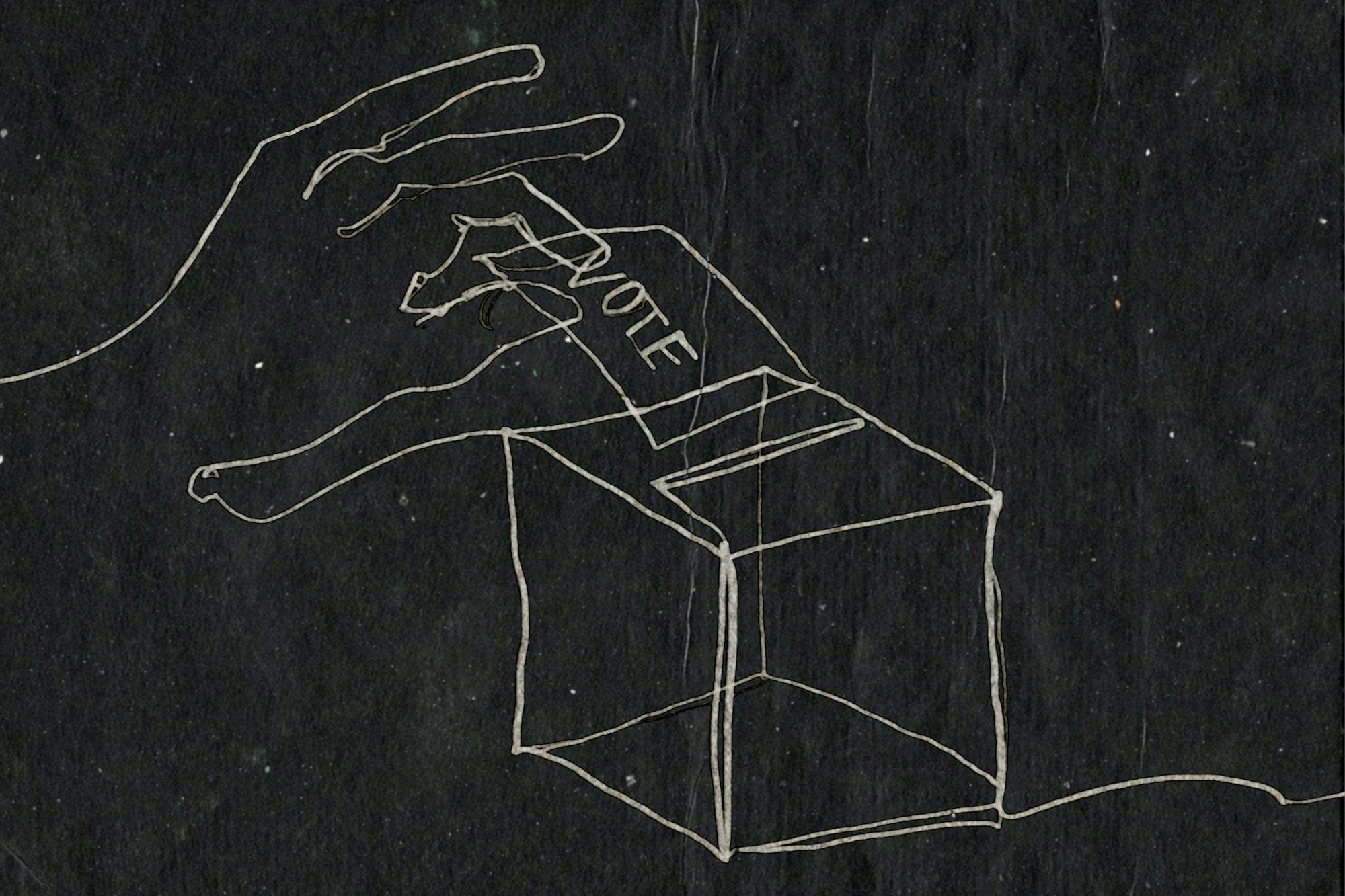
Editor's Note: After interviewing all presidential candidates who were available, The Sun's editorial team has decided to abstain from endorsing any candidate for president. The Sun's editorial team believes no presidential candidate demonstrated both the policy commitments and consistent actions necessary to fully reflect the institutional values of this paper.
Cornell stands at a precipice. With a $1 billion funding freeze from the Trump administration and the Student Assembly entering a byline funding year, the stakes are much too high for the normalized ambivalence the student body holds towards Assembly elections. Student representatives must meet this moment with both courage and competence - and that begins with leadership that understands the magnitude of the work ahead and is willing to do it. At this critical moment, The Sun places its trust in Saad Razzak '26 for executive vice president of the Student Assembly.
Razzak is the current representative for the College of Arts & Sciences and chair of the Academic Policy Committee. He has spent his term working on the kind of steady change that is often undervalued in campus politics. But it's precisely that seriousness - of purpose, of vision and of follow-through - that sets him apart. He is pushing for tangible academic policies: pushing for resolutions to prevent prelims from falling on Election Day or the eve of breaks and advocating for clearer credit transfer protocols.
He crucially balances this local efficacy with a clear-eyed understanding of broader political challenges. When national politics reached our campus in the form of defunded research and executive orders threatening our most vulnerable students, Razzak authored Resolution 36, urging the University to find alternative funding for defunded research and to take legal action against executive orders at odds with federal and state laws. He worked closely on Resolution 37, which outlines concrete protections for immigrant, undocumented and refugee students - from legal support to mental health resources.
Throughout our interviews, Razzak spoke with honesty about bureaucratic challenges and institutional delay. He did not overpromise or romanticize the role of EVP. Instead, he emphasized strategy: cross-Assembly legitimacy through collaboration with the Faculty Senate, careful rapport with University administrators and early engagement with the Student Activities Funding Commission and byline funded undergraduate student organizations to demonstrate that the Assembly cares about each group's concerns amid potential funding cuts.
Candidate David Suarez '27 offered strong rhetorical commitments to diversity, equity and inclusion. His proposal to call on Cornell to join the National College Attainment Network is a thoughtful one. We commend his prior Assembly experience, including working on Resolution 17, which urged a campus-wide community restorative day following a string of campus tragedies, and Resolution 37. Though his policy vision is inspiring, he has not always mobilized the Assembly to enact tangible change despite holding what he said was its "third-most powerful position."
Candidate Ezra Galperin '27, currently an undesignated at-large representative and chair of the Dining Services Committee, pointed to real accomplishments, including his work on Resolution 31, which calls for the expansion of meal swipe access to Trillium. He offered detailed ideas to improve Assembly transparency - including the use of campus kiosks, QR codes and revamped social media strategy - and emphasized the need for stronger committee accountability. However, Galperin lacks a track record of unifying the Student Assembly to respond to national politics.
The University is facing unprecedented challenges that directly impact the student body, and the Assembly is the most direct representation of 16,000 undergraduates. And at a moment where political instability and financial uncertainty threaten the very structure of student life, we need more than promises. We need policy. We need accountability. We need results. The Sun believes that a vote for Saad Razzak meets the moment.
Editor's Note: Student Assembly president and executive vice president candidate Christian Flournoy '27 did not respond to multiple requests for an interview with The Sun and did not attend the candidate forum. EVP candidate Ezra Galperin '27 is also a Sun columnist.
The Cornell Daily Sun's Editorial Board is a collaborative team composed of the Editor in Chief, Associate Editor, Opinion Editor, Assistant Opinion Editor and one Opinion columnist. The Editorial Board's opinions are informed by expertise, research and debate to represent The Sun's long-standing values. The Sun's editorials are independent of its news coverage, other columnists and advertisers.
The Sun is interested in publishing a broad and diverse set of content from the Cornell and greater Ithaca community. We want to hear what you have to say about this topic or any of our pieces. Here are some guidelines on how to submit. And here's our email: opinion@cornellsun.com.
Softball Takes Down Syracuse, Gets Swept by Princeton 16 Apr 5:02 AM (2 days ago)
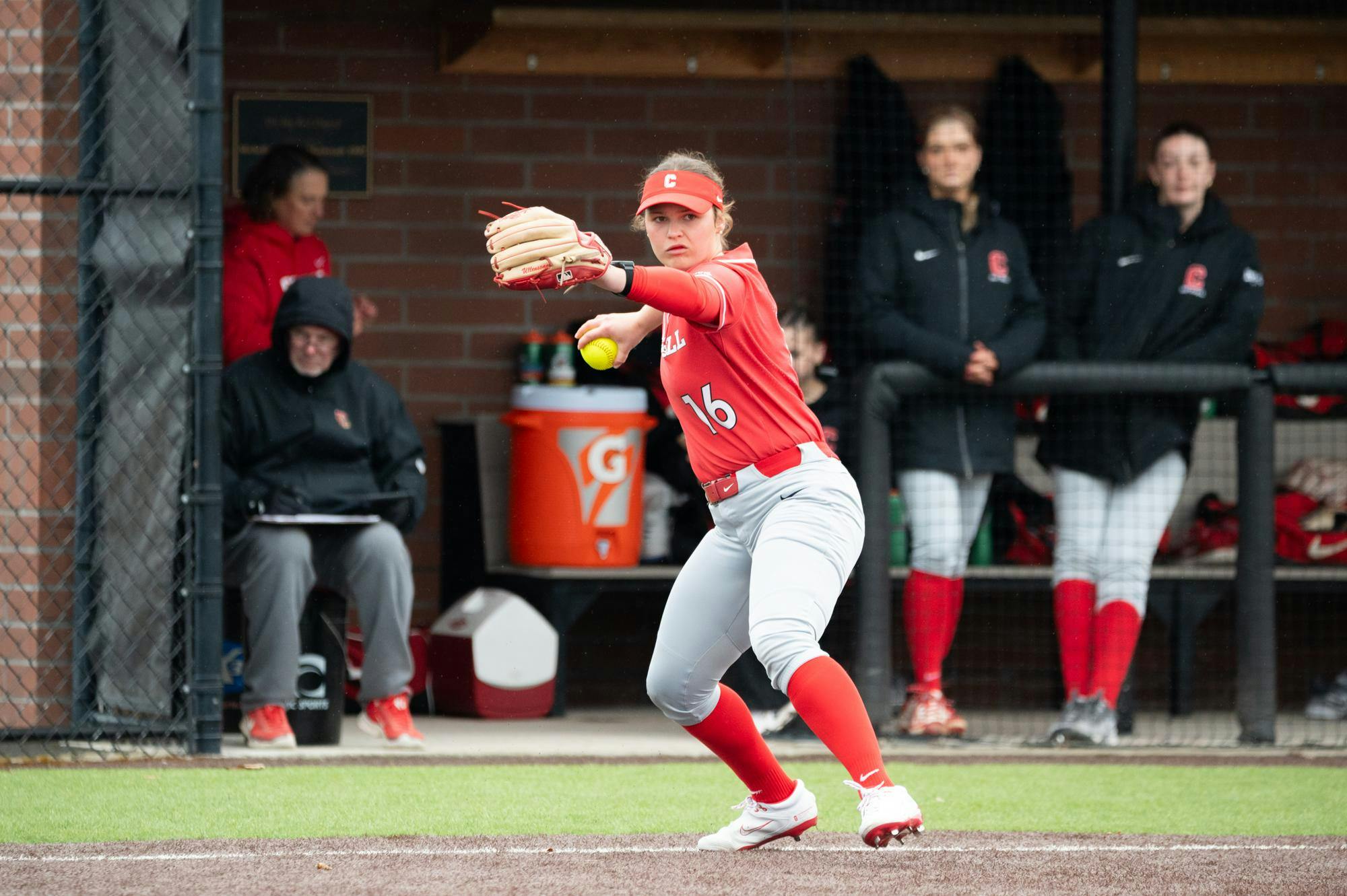
Softball (13-14, 4-8 Ivy) began the week on Wednesday with a single game against Syracuse University (22-16) at home. It was a tight contest throughout, but the Red was able to pull off a close victory.
Syracuse opened the scoring with a sacrifice fly to right field in the second inning. In the bottom of the second, senior infielder Emma Antich reached first base on an error, knotting the score at 1-1.
The score remained stagnant until the bottom of the sixth when junior catcher Lauren Holt hit a clutch home run to left field and gave Cornell the lead. The 2-1 score would hold, and Cornell claimed the win. The winning pitcher was freshman Mila Fiordalisi, who closed the game with two scoreless innings.
"We came in on Wednesday, showed up and took care of business," said head coach Julie Farlow '97. "It was a pretty positive feeling for sure."
On Sunday, Cornell began a three-game series at home against Ivy League opponent Princeton University (17-3, 11-1 Ivy). The Red were swept in the series, scoring only four runs throughout three games.
"It made us aware that we had some work to do and some adjustments to make," Farlow said.
Game one was a 7-2 loss for Cornell. Princeton shut out Cornell until the final frame of the game and scored seven unanswered runs, including a grand slam in the top of the fourth. In the bottom of the seventh, a single from freshman infielder Emma Harshberger scored two runs. Cornell was unable to overcome the seven-run deficit and ultimately fell in game one.
In game two, Princeton jumped out to an early lead with a four-run first inning and never looked back. Through the fifth inning, Princeton scored twelve unanswered runs. Junior infielder Ella Harrod broke the shutout with an RBI single in the bottom of the fifth, and Harshberger added another run by reaching first on a fielder's choice. A groundout in the bottom of the fifth ended the game as Cornell lost 12-2.
Finally, game three was an 8-0 shutout loss. Princeton's pitcher, Brielle Wright, dominated the Cornell lineup, only allowing three hits against the Red.
"I don't think we performed in many aspects the way we wanted to against Princeton, but it's done and we have to move on from it right now," Farlow said. "We have nine very important Ivy League games left to end the year on a good note and still battle for a place in the tournament."
Cornell will look to rebound in an interleague series against the University of Pennsylvania at Niemand-Robison field beginning at 12:30 p.m. Saturday. Fans can catch the action live on ESPN+.
AYSW? | Daily Consumption 16 Apr 4:00 AM (2 days ago)

If you were to ask me about my screen time … I'd tell you, but then I'd have to kill you. The embarrassing amount of time I spend looking at my screen is taken up by movies, YouTube videos and, unfortunately, mostly TikToks. While I've been trying to cut down on my phone usage and "create, not consume," media has always been a lifeline of sorts for me. Whether it's a Youtube video playing while I eat, a five-minute TikTok break or a movie when I can't sleep - visual content has always been something I turn to in my day-to-day, or to be honest, my minute-to-minute. In the midst of balancing my academic and personal life, I can always manage to find gaps in time to consume comforting content that gives me a break to laugh, reminisce, analyze or reflect. Here's a snapshot of how I've been spending my time recently including some movies, YouTube videos and TikToks I've been watching to maintain comfort, curiosity or just plain distraction.
2025 Best Picture Nominees: Conclave and Anora
While my 2025 Best Picture was obviously Wicked, the Academy had other ideas … I'll be honest, the 2025 Oscars Best Picture pool felt a little dodgy to me given that Emilia Pérez snagged a nomination, which held me back from watching the nominees - as I usually do - before the Oscars happen. After Anora won, I was really curious about what made it such a great movie, so I decided to watch it alongside other nominated films in the coming weeks. I got around to watching Anora, and while it was a well-made screwball comedy, I couldn't bring myself to fully enjoy it because Anora/Ani's character felt so underdeveloped. Mikey Madison is a powerhouse and did an amazing job at portraying Anora, but I think the only charm and depth the character possesses is solely because of Madison's acting - not because of Sean Baker's writing. On the plane back from Spring Break I watched Conclave. I wasn't super excited to watch Conclave because I thought it was just going to be boring old white men fighting - which in part is what it was - but to my surprise I was on the edge of my seat the entire time. Conclave gave me a sensation similar to watching RuPaul's Drag Race (Season 6, specifically), which is no easy feat, nor is it something I take lightly. The popes gathering, voting and campaigning gave "lipsync for your life," and I loved every second of it; to quote my favorite Conclave Letterboxd review: "they were having a diva off!" The drama, the score and the cinematography all blew me away, and I'm surprised it only won one of its eight nominations; Conclave is a close second to Wicked in terms of my Best Picture 2025.
Commentary YouTube
For a few years now, I've been a big fan of commentary Youtubers; they're my go-to to play in the background of any small daily task or when I'm eating alone. Some of my favorites are Drew Gooden, Kurtis Conner and Danny Gonzalez. These YouTubers make genuinely funny and informative content that I can watch to shut my brain off and laugh. Other than making high-quality content, their content has an aspect of rewatchability that makes their videos easy to turn to when I have a hard time choosing what to watch. Some of my favorite videos of theirs are: Kurtis Conner's "WATERTOK: The Strangest Community on TikTok," Drew Gooden's "I bought every weird ad I saw for a month" and Danny Gonzalez's "Tech Products That Should Not Exist." Besides making great individual content, these specific content creators collaborate often, resulting in hilarious videos like one on Danny Gonzalez's Youtube: "DIGTOK (w/ Drew Gooden and Kurtis Conner)."
Concert TikToks (Old Eras Tour TikToks and Lady Gaga's Coachella Set)
Around this time two years ago I went to Taylor Swift's Eras Tour in Tampa, Florida. It was a legendary night that I remember almost nothing of because I was in such a haze of disbelief that I think my cognitive function clocked out for the night. Besides attending the tour, I would also watch live streams of it as it was happening; however, since the tour came to an end in December of last year, I'd barely seen any footage of it up until recently when I assume my TikTok algorithm somehow found out the anniversary of my Eras date was approaching. In the spirit of reminiscing I've found myself sitting through every video I get of the tour, briefly reliving the experience of a once in a lifetime concert and filling in those gaps I'd forgotten about!
On a more recent note, I stayed up till 4:00 am on Friday watching Lady Gaga's enthralling Coachella set. I couldn't take my eyes off the otherworldly artistry that Gaga turned out - as expected from her - but this was just on another level. The costuming, light design, choreography, set design and Lady Gaga's superhuman stamina showed out for a spectacular performance filled with iconic songs and her newer hits from Mayhem. It's now my mission to go to her Lady Gaga: The MAYHEM Ball tour and be transfixed by her artistry in person.
Paulina Delgado is a freshman in the College of Arts and Sciences. She can be reached at pmd99@cornell.edu
"Are You Still Watching?" is a column spotlighting what the Cornell community has been streaming. It runs every Wednesday.
17 Former or Current Students See SEVIS Records Terminated, At Least Four Report Visas Revoked 15 Apr 11:12 PM (2 days ago)
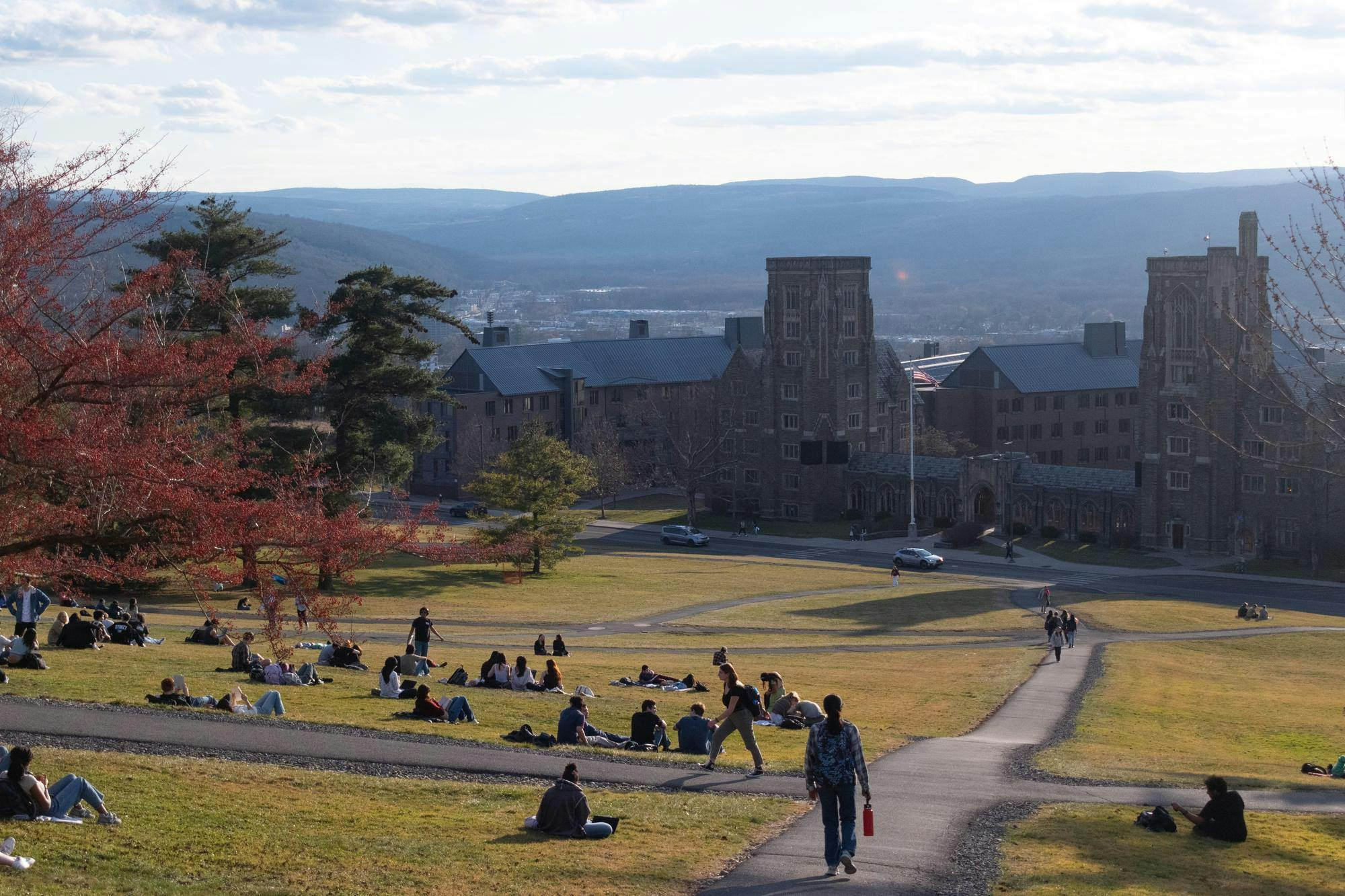
Seventeen current and former students have had their Student and Exchange Visitor Information System records terminated by federal authorities, and at least four of the 17 reported that their visas were revoked, according to a Cornell spokesperson.
This development comes after The Sun's Monday article reported that the University quietly updated an FAQ webpage, revealing that "a small number" of international students have had their SEVIS records terminated. At the time, University officials twice declined to disclose to The Sun how many students were affected.
On Tuesday, a University spokesperson shared a statement with The Sun detailing the number of SEVIS record terminations. Of the 17 whose records were terminated, nine are current students and eight have graduated, the spokesperson wrote.
In recent weeks, hundreds of students across the country have had their visas revoked and now face potential deportation. As of April 12, the legal status of over 1,200 international students has changed.
SEVIS is a web-based system that the U.S. Department of Homeland Security maintains, which tracks students on visas. The University can audit student SEVIS records, and has stated that they are actively checking SEVIS for updates.
When a student's SEVIS record is terminated, they lose their student status. If SEVIS records are terminated for a violation of their status, students must leave the country immediately unless they apply to have their SEVIS status reinstated - a process that can only begin if a designated school official provides a recommendation for SEVIS status reinstatement.
If a student's status is not reinstated, they may face consequences - including deportation - for remaining in the United States.
While SEVIS records are viewable by educational institutions, students are notified of visa revocations individually. On March 31, Cornell International Services issued guidance that urged students to notify the University if they received correspondence saying that their visa was revoked.
Men's Polo's Valiant Effort to Come Back Falls Short against University of Kentucky in Division II Championship 15 Apr 10:57 PM (2 days ago)

Down 10 points to open the second half, the Cornell men's polo team was prepared to make a valiant comeback attempt to maintain its Division II Champions title from last year's victory over Georgetown University.
Not much changed between the first and second half in terms of players - starters freshman Max Sponer and junior Benito Jaramillo remained in the lineup and freshman Dylan Tung subbed in for senior Christian Finlay.
At the same time, so much changed in the Red's offensive effort between the first and second half. Less than a minute into the third chukker, Cornell scored a point and slowly mounted its comeback. Less than nine seconds later, the Red scored again, and in 26 more seconds Cornell added another point to the board.
"Our team was a little slow in the first chukker," Sponer said. "We woke up and played better in the second half. [We] missed goals and opportunities and gave away too many penalties to start."
In less than two minutes, Cornell had already scored more points than in the first half total. But scoring was just half the battle, as Cornell needed to keep the University of Kentucky from scoring too.
"In the second half we improved as a team and had less penalties, more goals made and marked men better and closer," Sponer said. "I am proud of this team and how far we were able to make it this year and am confident that next year we will be better with two starting freshmen."
However, the Wildcats were determined to hold onto its lead - it brought the score to 5-13 with under three minutes left in the chukker. Jaramillo notched one in for the Red, but Kentucky answered with two scores. To match this, the Red scored three more points in the last minute and 15 seconds of the chukker.
To enter the final chukker, the Red trailed 8-15. Kentucky scored first but Sponer answered by scoring behind the 25-yard mark, as did Jaramillo 17 seconds later.
Now, the score was 12-16 but the Red would have a hard time scoring as the Wildcats held play and scored 12-17. Sponer would score the Red's final point of the season, and ultimately the match would end with Kentucky winning the championship, with a final score of 13-17. Cornell's impressive 11-5 run in the second half was not enough.
But the championship weekend had some high points for Cornell, as it beat Texas Tech University on Friday decisively, 21-7. In this match, the Red mounted a comeback in the second chukker headed by Sponer.
"The match against Texas Tech was a team victory, and I am very proud of Dylan, Benito and Christian," Sponer said. "They all played very well and I was supported heavily by them."
Sponer had a total of 11 points and a pony goal - meaning his horse kicked the ball in. Jaramillo notched eight goals, and Finlay scored one during the win.
The Red ended the season 9-8 overall, with Jaramillo awarded a National All-Star recognition and the Men's Horsemanship Award.
Looking to next year, the Red are excited to take on a new season with a young squad of players and hope to take back the National Title.
"We know we will make it back next year," Sponer said. "We know that we will be more experienced and play under pressure better. Our goal is always to work together and play as a team."
The Battle for the Class of 1975 Cup: Women's Rowing Faces Off Against Princeton and Harvard-Radcliffe 15 Apr 10:51 PM (2 days ago)

Donated by five graduates of Princeton University's class of 1975, the prized Class of 1975 Cup has been awarded annually to the winner of the first Varsity-8 race between Cornell, Princeton and Harvard-Radcliffe. This year, while the Cornell women's rowing team achieved victory in the 3V4 event, the cup ultimately remained in the paws of the Tigers for the 10th consecutive competition.
The Red took to the water early Saturday morning for a total of 6 races: the 3V8, 1V8, 2V8, 1V4, 2V4 and the 3V4. In the first race of the day, the 3V8, the Tigers took the victory with a 6:42:97 time. The Red took 4th place in the 3V8, clocking a 7:18:04 time.
The Tigers followed up with another victory in the 1V8, with a time of 6:18.67 that awarded them the Class of 1975 Cup. The Red finished in 3rd once again, with a time of 6:40.76 in the 1V8. In the 2V4, it was Harvard-Radcliffe that secured the victory, clocking a 7:19.98 time. Princeton followed up in 2nd place with a time of 7:24.11, and Cornell finished in 3rd place with a time of 7:41.73.
In the very last race of the day, the 3V8, the Red was victorious with a time of 7:44.92. Harvard-Radcliffe finished in 2nd place in the 3V8 with a 8:00.43 time. Overall, racing conditions were mild on Saturday, with moderate tailwind, light snow for the first few races and light rain to round out the last few races.
While the Red may have fallen to the Tigers for possession of The Class of 1975 Cup, the women's rowing team has a few more regattas to look forward to this season. This weekend, the Red will travel to Andover, New Hampshire to face off against the Big Green at Dartmouth College.
The following weekend, The Red will head to Providence, Rhode Island to race the Bears at Brown University for their last regatta of the regular season before the Women's Sprints Championship and the Ivy League Championship.
Coverage of all regattas will be available on ESPN+.
Grace Reuben is a Sun Contributor and can be reached at gyr5@cornell.edu.
Warden and Betlow Lead Men's Golf to its Best Finish of the Spring Season 15 Apr 10:45 PM (2 days ago)

Junior Weston Warden, starting his first round with a double par, hit his second shot in the hazard. But he refused to give up, remembering his high school coach's words: "Just shut the door. After every hole, it's like you have a new swing, a new hole ahead of you."
Despite difficult conditions, he completed an impressive recovery, carding two birdies en route to a 78 finish. One of these came on the 18th hole, after a shot that Warden describes as his best of the event. With a drive down the middle, Warden caught the edge of the green and managed to finish the hole with a three.
"I would say that was one of the more fun ones, especially because I needed it during that time," Warden said.
The Red improved by eighth strokes in the second round, from 311 to 303 for a total of 614 strokes (46-over par) to finish 13th out of 14 teams, outlasting Rider University who finished at 616 strokes. Senior Jackson Debusschere finished third on the team with two rounds of 79. Sophomore Tyler Debusschere (81-78) and sophomore Viktor Stollinger (79-80) also scored for the Red.
Princeton University took the win at its home course, finishing with 566 total strokes (2-under par). Rutgers University (579) and Seton Hall University (581) filled out the rest of the podium.
The Red powered through tough conditions on the first day, with 18 of the scheduled 36 holes being canceled due to cold weather and rain. Freshman TJ Betlow remained steady, making a birdie and 12 pars to help Cornell secure a 12th place spot on the first day after a first round of 75.
"Knowing your own game through those conditions is really important," Betlow said. "Relying on what you know how to do best, and centering on that was important for me."
On the 18th hole of the second round, Betlow hit an unsatisfactory drive and a shot into the right greenside bunker. In recovery, Betlow managed to get up and down from the sand for par. Describing this hole as his favorite of the event, Betlow explained, "Even though it wasn't the prettiest hole, I ended my round on a solid note."
He continued to perform on Sunday, improving to a 74 (3-over par) with three birdies. Meanwhile, Warden carded a 72 (1-over par) in the second round with four birdies, a six shot improvement from the first day.
"You're really able to rely on your teammates for support," Betlow said. "The team camaraderie goes beyond the sport. We're such a close-knit team."
This weekend's event generated momentum for the Red as it looks ahead to its next event, and the Ivy Championship in two weeks.
"I feel like we're very happy we're with where our games are at," Betlow said.
Looking forward, the Red travels to Kingston, New York this weekend to compete at the Roar-EE Invitational hosted by Columbia University at Wiltwyck Golf Club.
Coverage of the matchup can be streamed on ESPN+.
Isabel DeLuna and Roscoe Heuer are Sun Contributors and can be reached at ied6@cornell.edu and rsh269@cornell.edu.
Cornell Tennis Keeps Ivy Title Hopes Alive With Weekend Wins 15 Apr 10:34 PM (2 days ago)
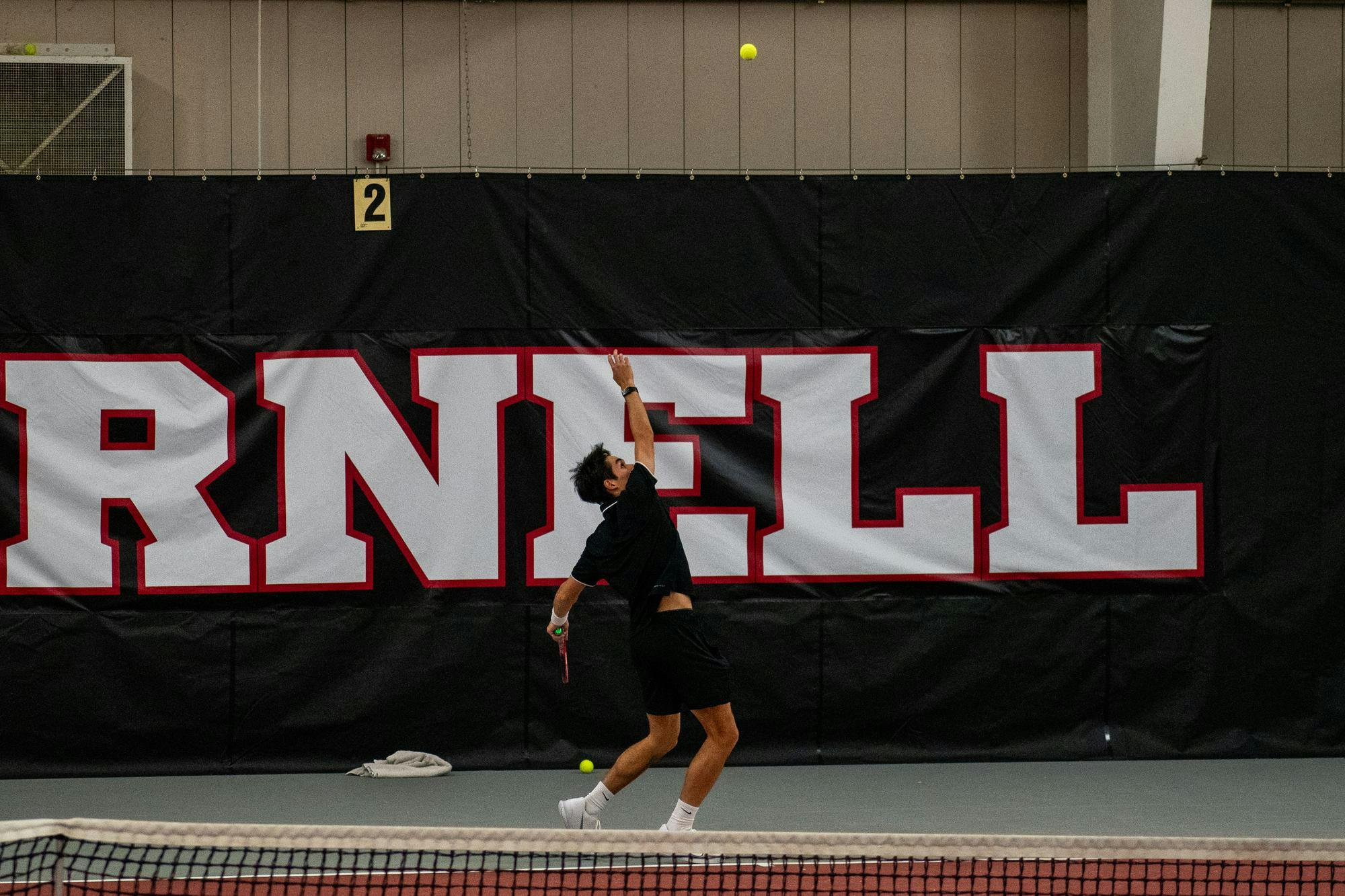
Tennis found its rhythm this past weekend with both the men's and women's teams delivering strong performances to keep post-season hopes alive. The women's squad broke a losing streak in a Sunday showdown at home, while the men's team claimed back-to-back wins over ranked Ivy rivals to stay firmly in the championship contention.
Men's tennis delivered a pair of statement victories to improve to 14-6 overall and 4-1 in Ivy play. After stunning No. 30 Princeton University on Senior Day at home Friday, the Red left Ithaca to knock off No. 47 University of Pennsylvania on Sunday, keeping pace just behind league-leading Columbia University.
Friday's clash at the Reis Tennis Center was Princeton's first loss to an Ivy League team this season. Tied 2-2 with three matches still in play and all pushed to third sets, three of Cornell's seniors rose to the occasion. No. 2 senior Adit Sinha rallied from a set down to beat Princeton's No. 40 Paul Inchauspe, shifting the momentum and putting Cornell on the brink of victory.
No. 1 senior Radu Papoe - the first Intercollegiate Tennis Association All-American award winner in Cornell men's tennis history, clinched the win with a 7-6, 3-6, 6-4 victory at the top spot over No. 67 Fnu Nidunjianzan. No. 6 senior Nathan Mao followed moments later with a gritty comeback of his own, taking down Milan Markovits 6-7, 7-6, 6-3 at No. 6 to seal a 5-2 team triumph.
Sophomore No 5. Felipe Pinzon provided the only straight-sets win of the day, dispatching Evan Wen 6-3, 6-4 at No. 4. Cornell had taken the doubles point earlier with wins at the No. 2 and 3 positions, setting the tone for the match.
Two days later, the Red rolled into Philadelphia and kept its Ivy title hopes alive with a 5-2 win over the 47th-ranked Quakers. Mao set the tone early with a commanding 6-2, 6-0 victory at No. 6, and Sinha and Papoe followed with dominant straight-sets wins at Nos. 2 and 1, respectively. The trio dropped just 10 total games between them. Senior Jack McCarthy added a third-set super tiebreak win at No. 3 to pad the final margin.
Men's tennis now prepares for a crucial regular-season finale with major Ivy League implications. It will travel north to face Dartmouth College on Saturday, April 19 before a potential title decider against No. 16 Harvard on Sunday, April 20. Both matches are set for 1 p.m. and will be streamed on ESPN+.
Returning to the familiar courts of the Reis Tennis Center, the Cornell women's tennis team captured its first Ivy League win of the season with a 4-1 triumph over UPenn on Sunday. The Red (11-7, 1-4 Ivy) showed resilience and focus after a narrow loss to Princeton on Friday.
The doubles point was a battle, with Cornell eventually pulling ahead thanks to a 6-4 win at No. 3 by senior Alexandra Savu and junior Emma Baker. Sophomore Michelle Ryndin and freshman Sage Loudon were fighting through a 5-5 in the top doubles match when the point was secured. That early momentum carried into singles play, where Ryndin led the charge once again, now at No. 1, earning a 6-4, 4-6, 6-2 victory over nationally ranked No. 72 Sabine Rutlauka to clinch the team win.
Sophomore Victoria Zhao also turned in a dominant performance at No. 3, defeating Lara Stojanovski 6-2, 6-3, while Baker capped a perfect day with a 6-1, 7-6 win at No. 6 singles. Jenny Wong held a 4-1 third-set lead at No. 4 when the match was called.
After taking a 2-0 lead, the Red couldn't hold off the Tigers. Loudon scored the only other singles point for Cornell, gutting out a 3-6, 6-3, 6-3 comeback at No. 2.
Women's tennis will wrap up its Ivy League season at home next weekend, welcoming Dartmouth and Harvard to Ithaca for 1 p.m. matches on Saturday and Sunday, respectively. Both matches will be streamed on ESPN+.